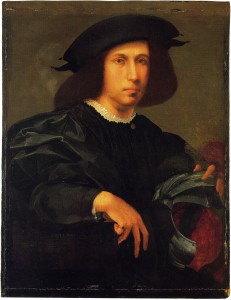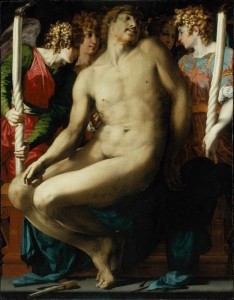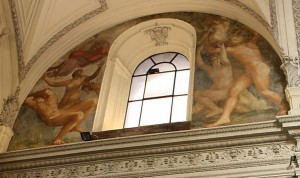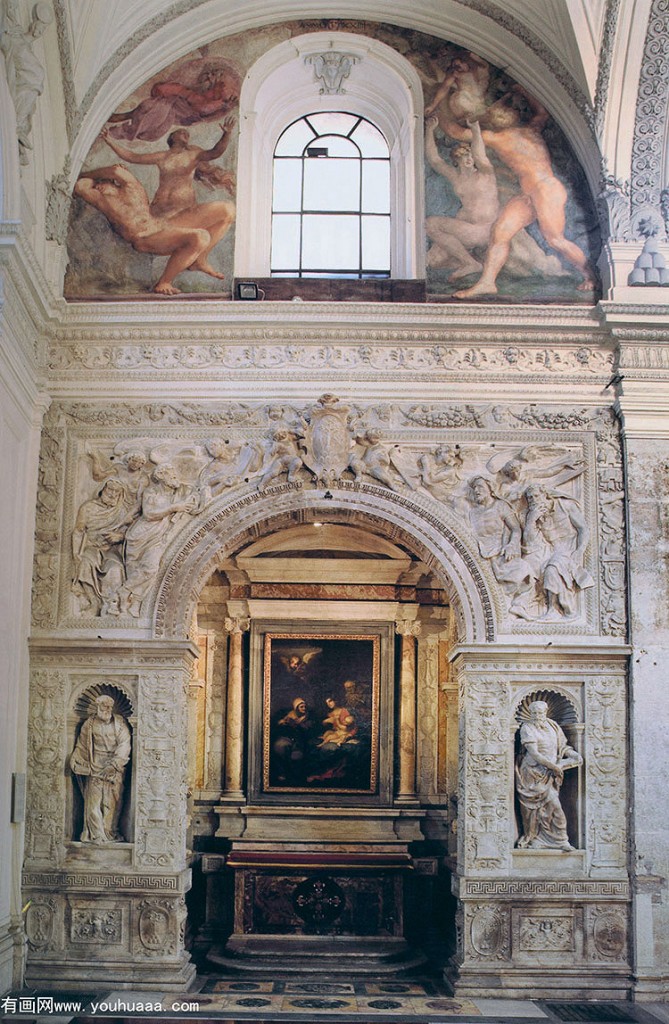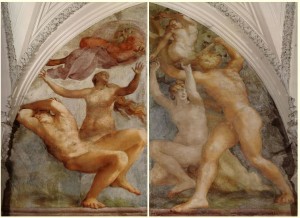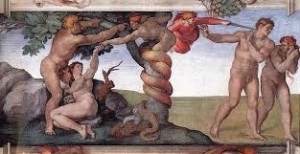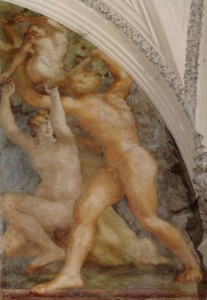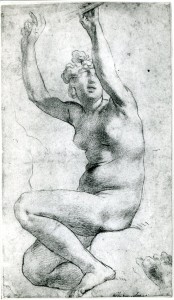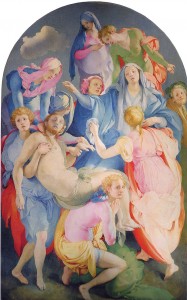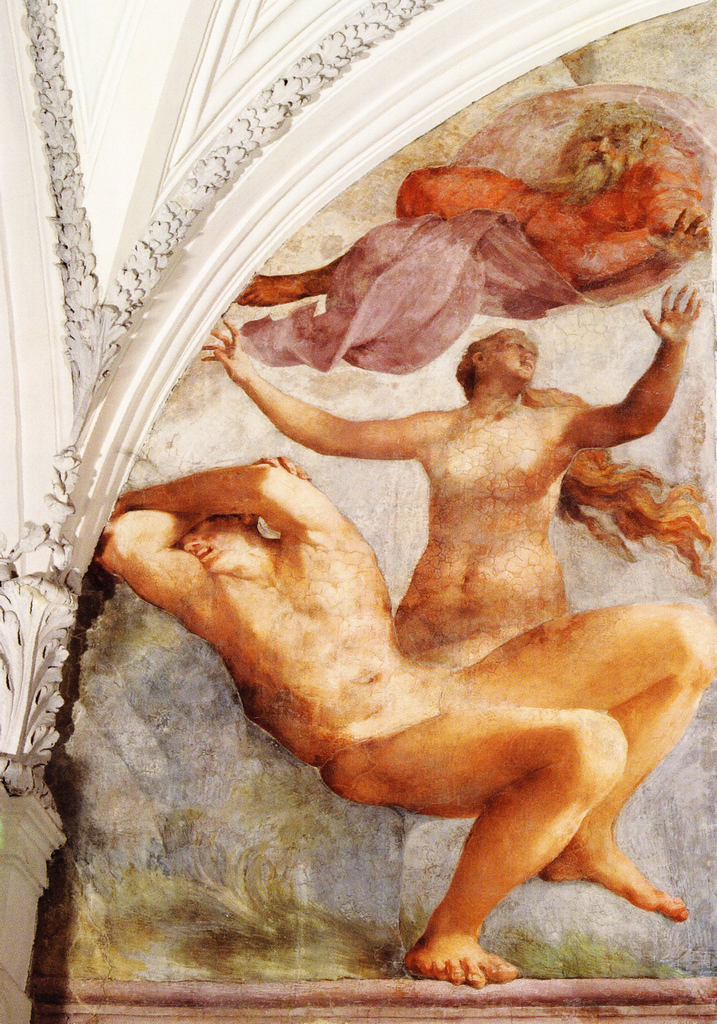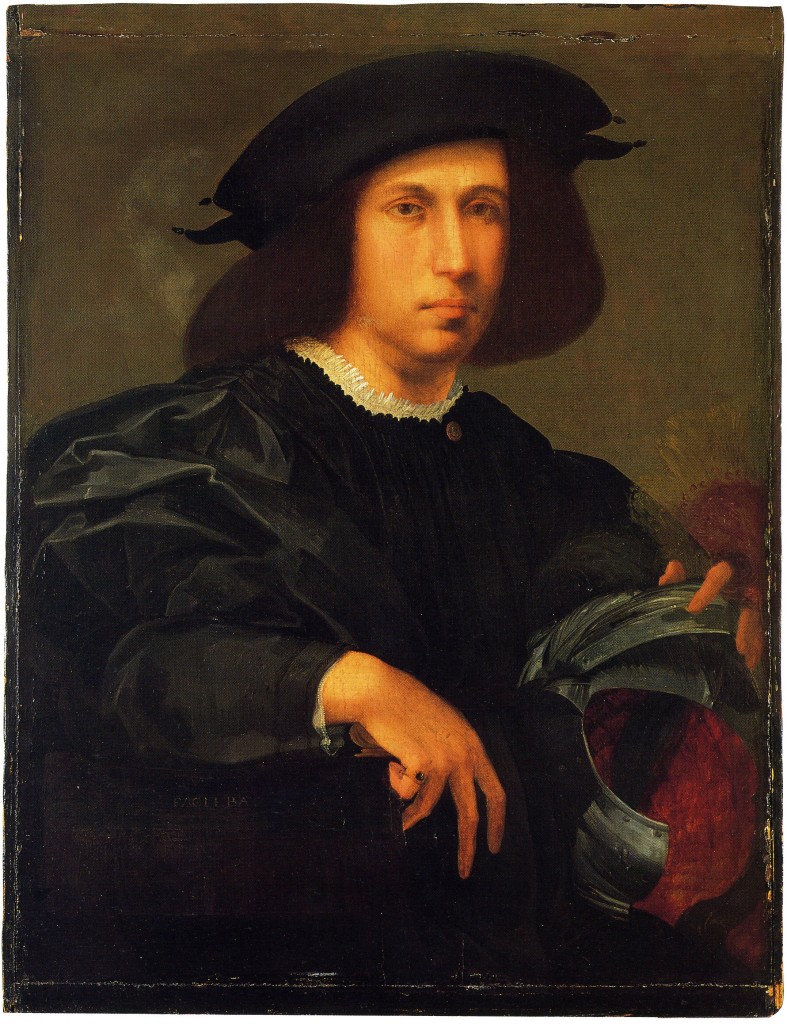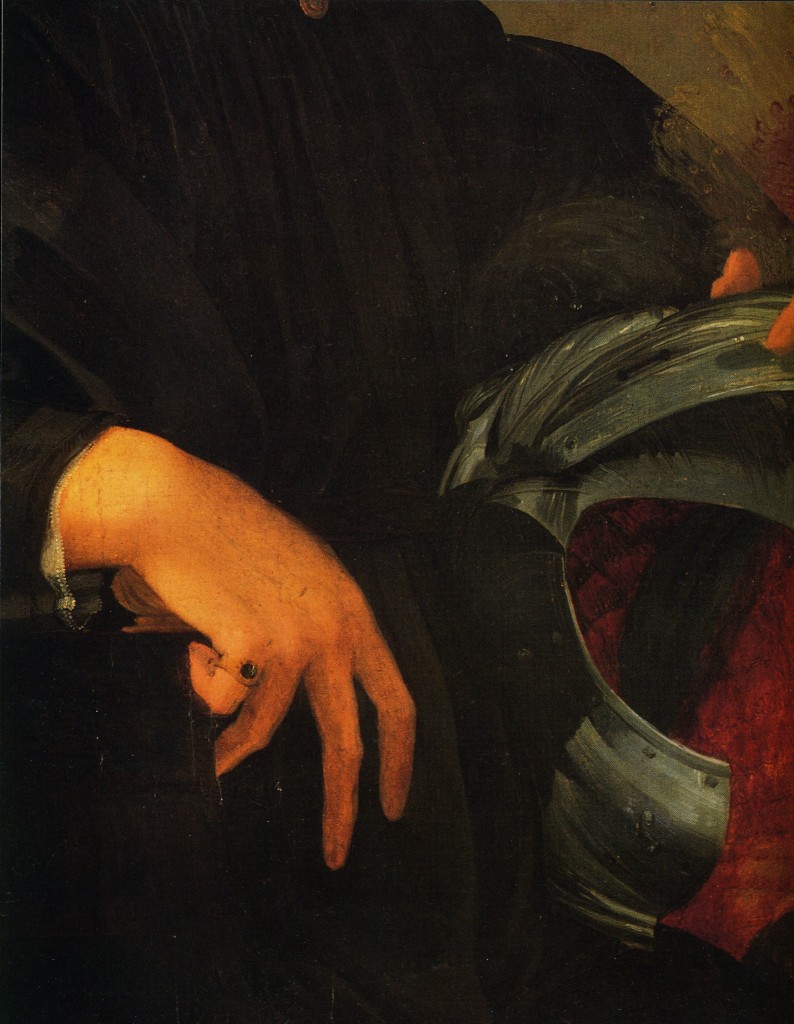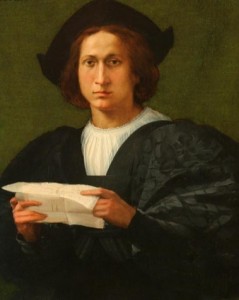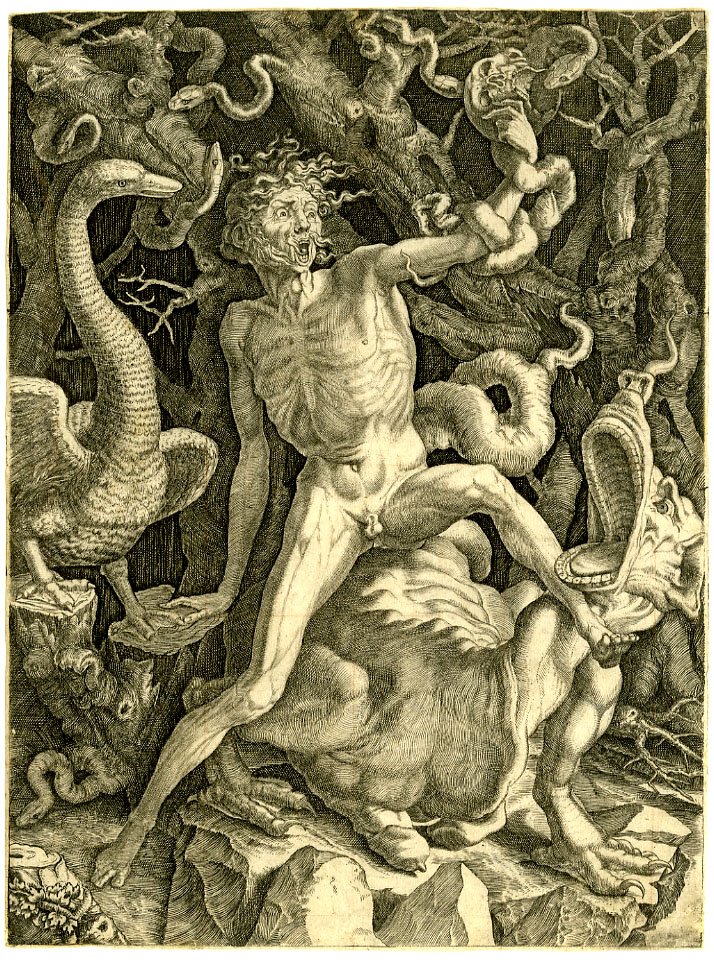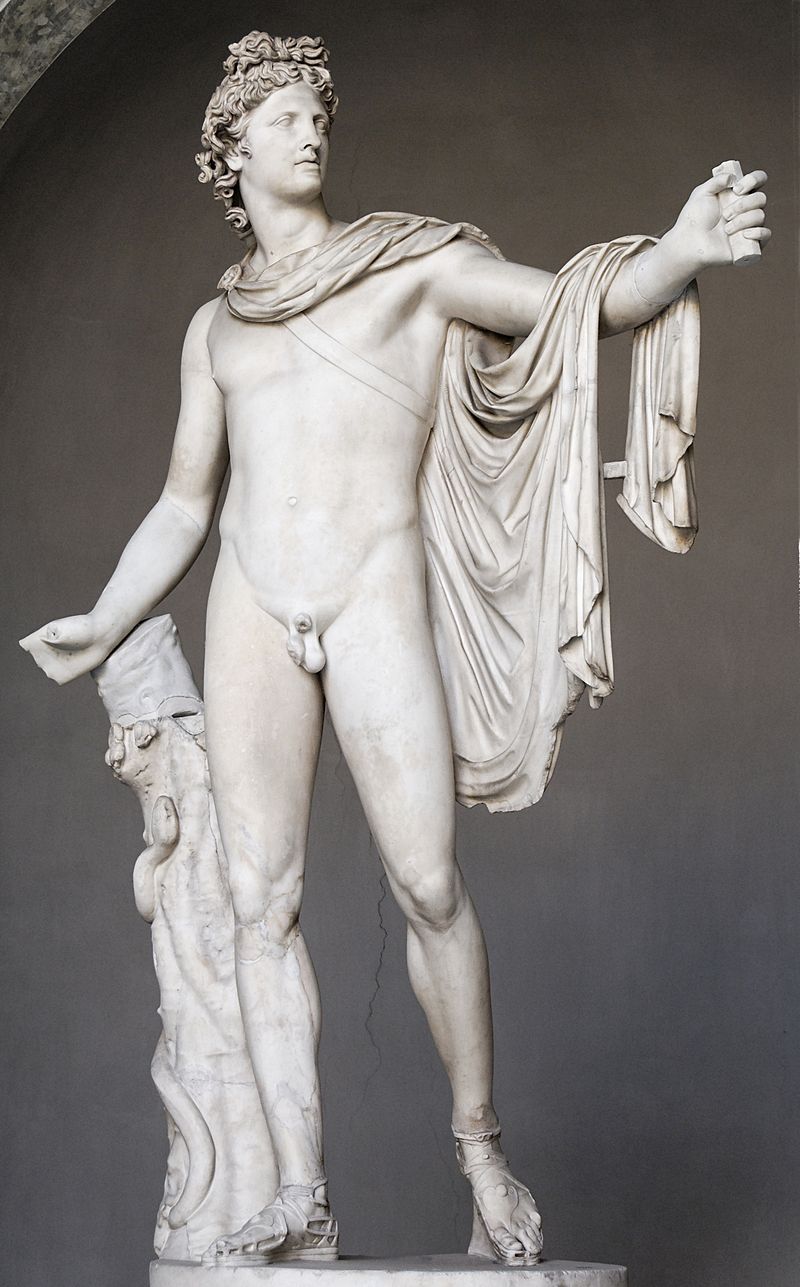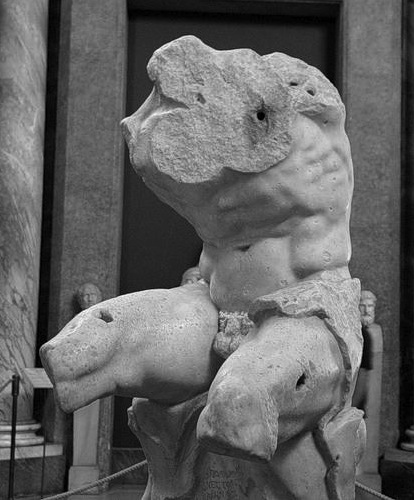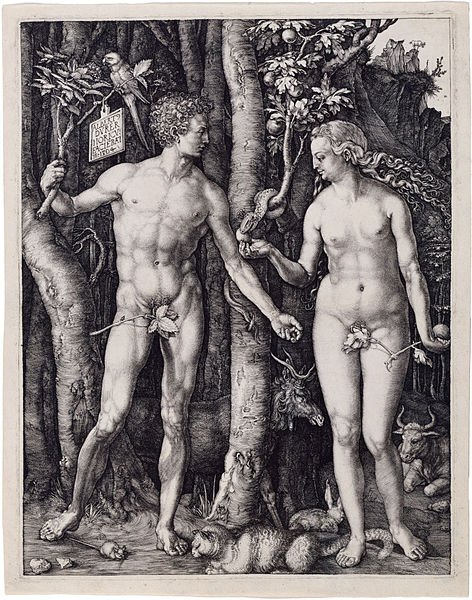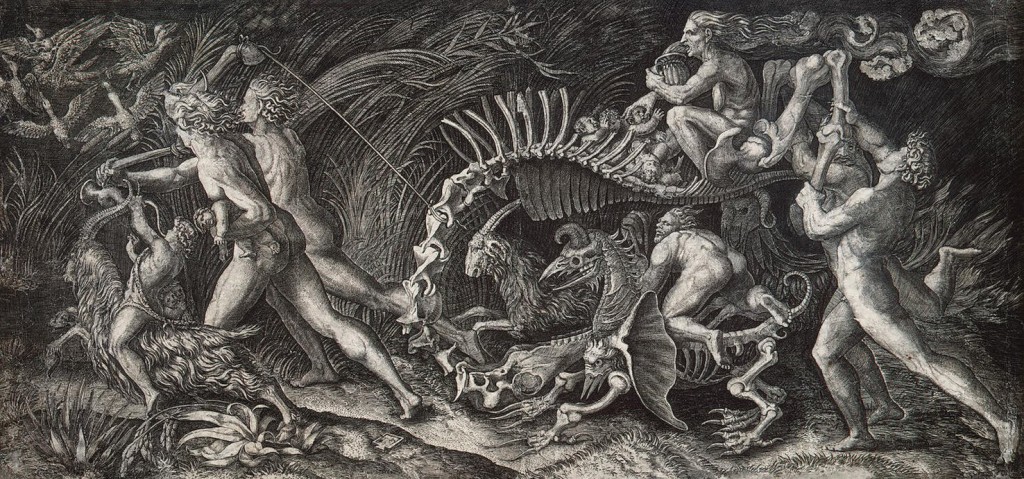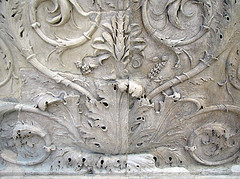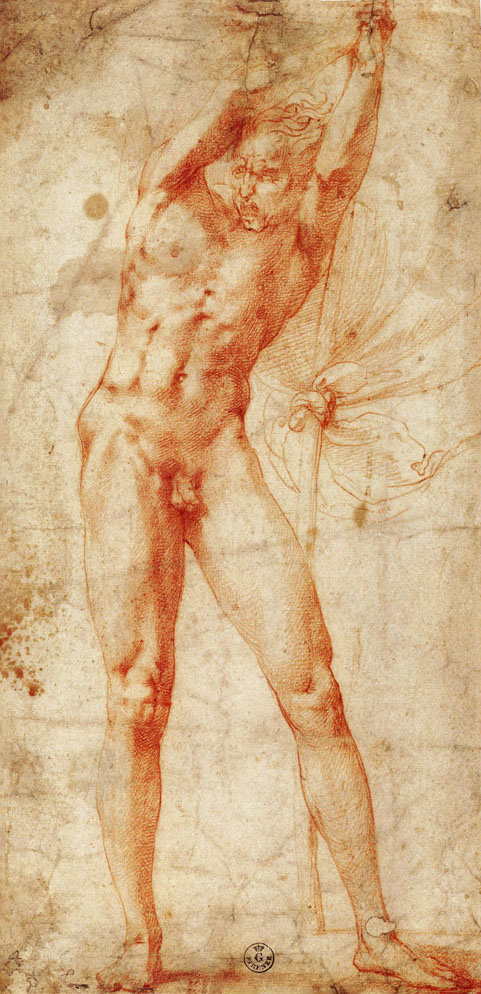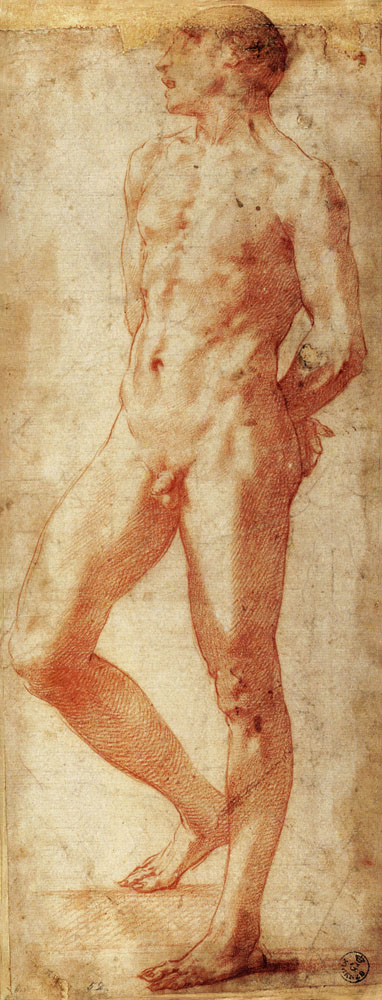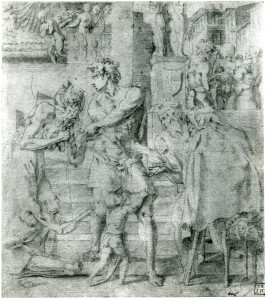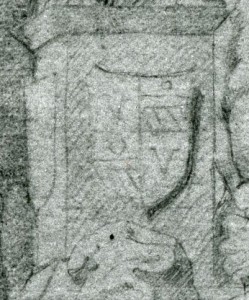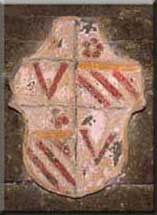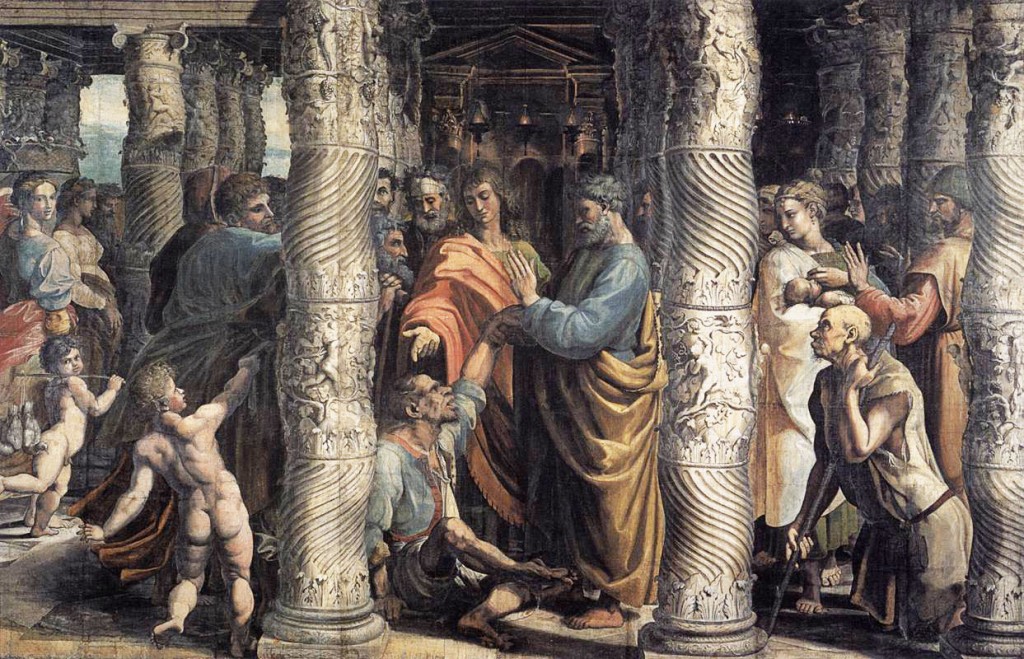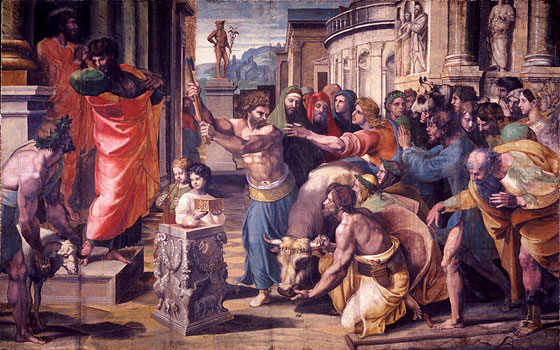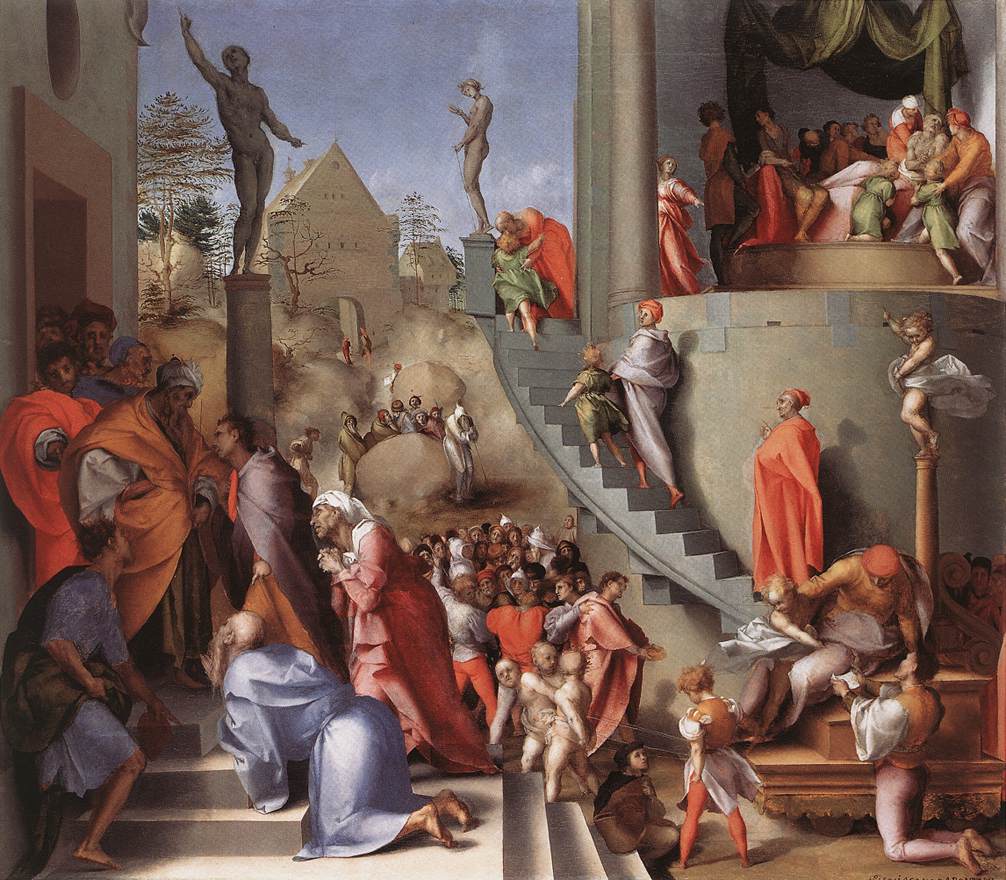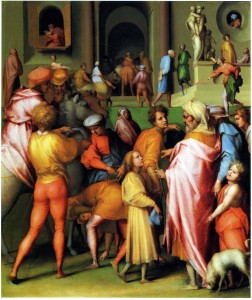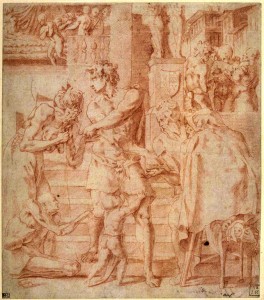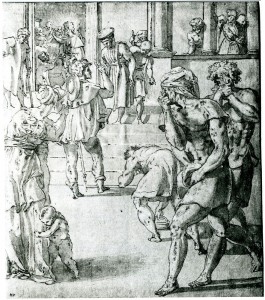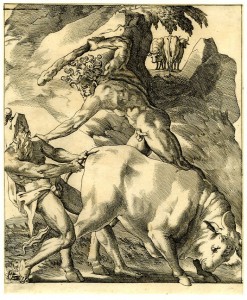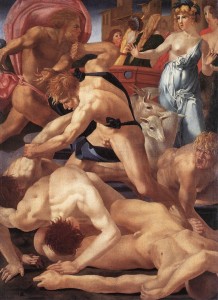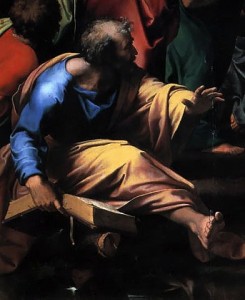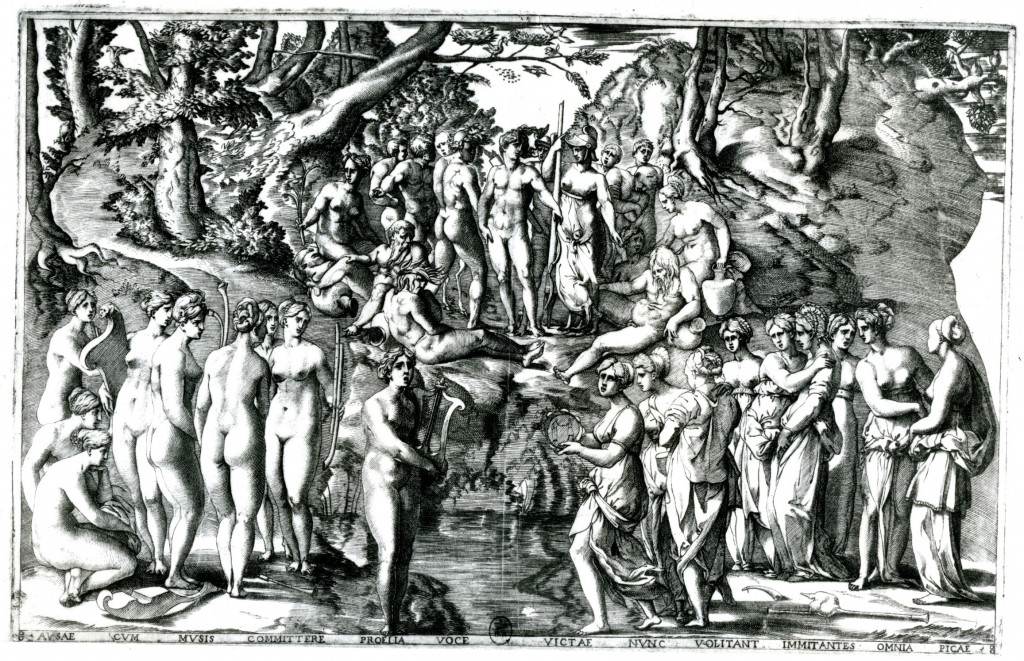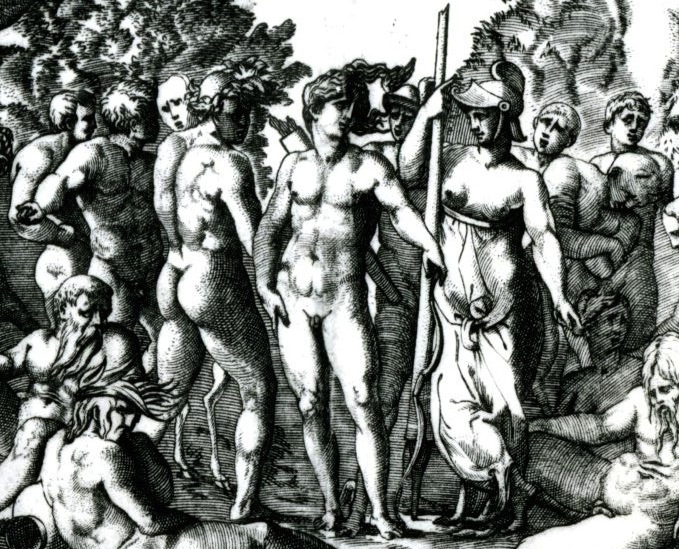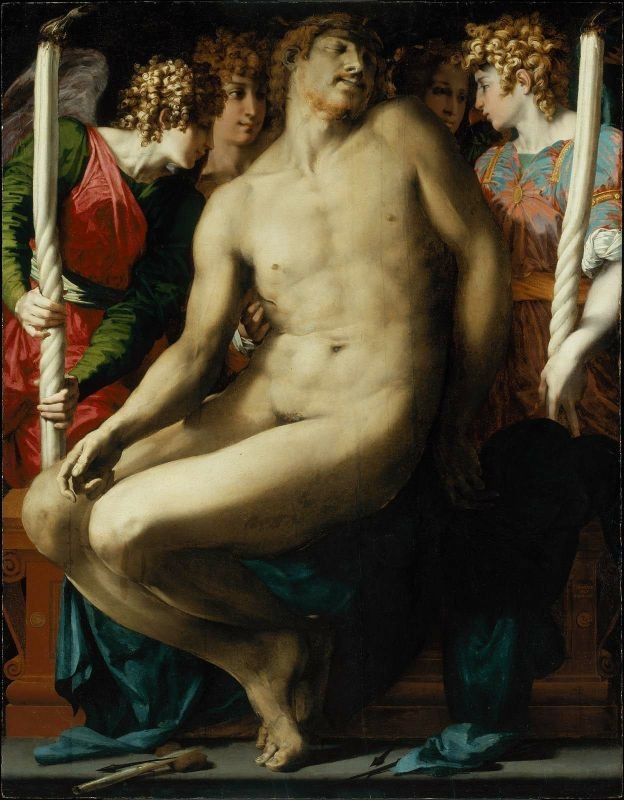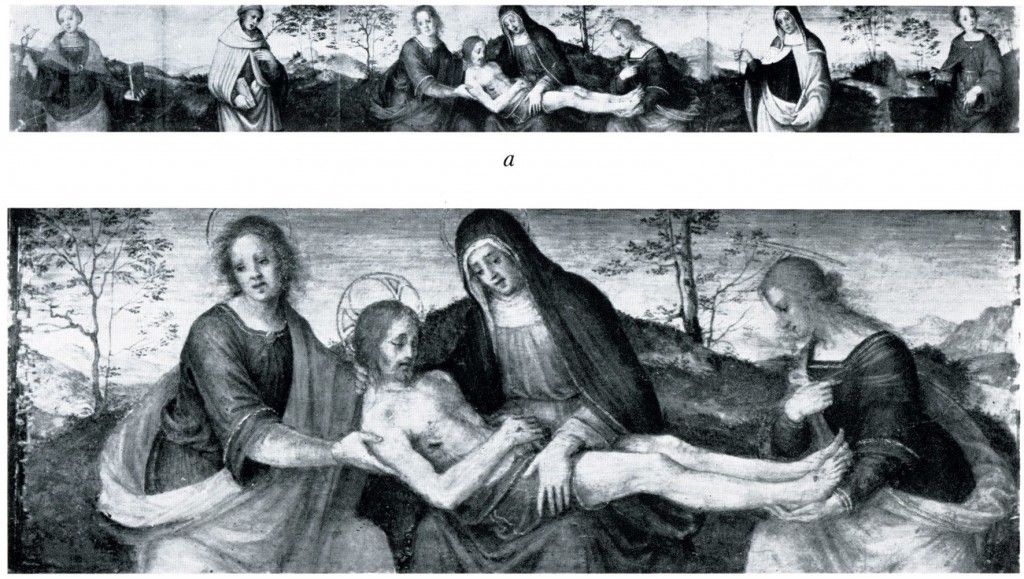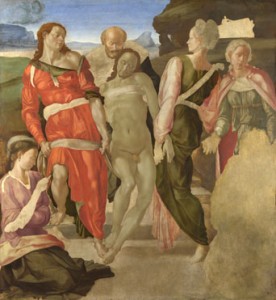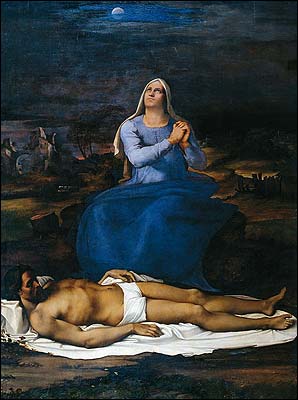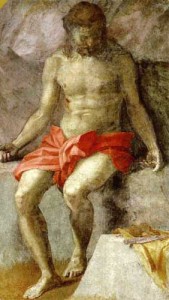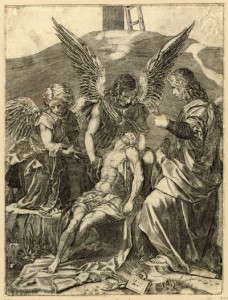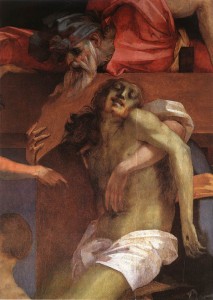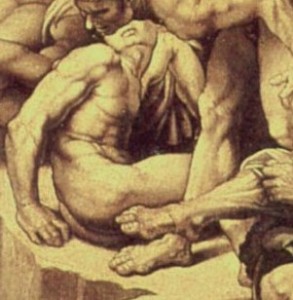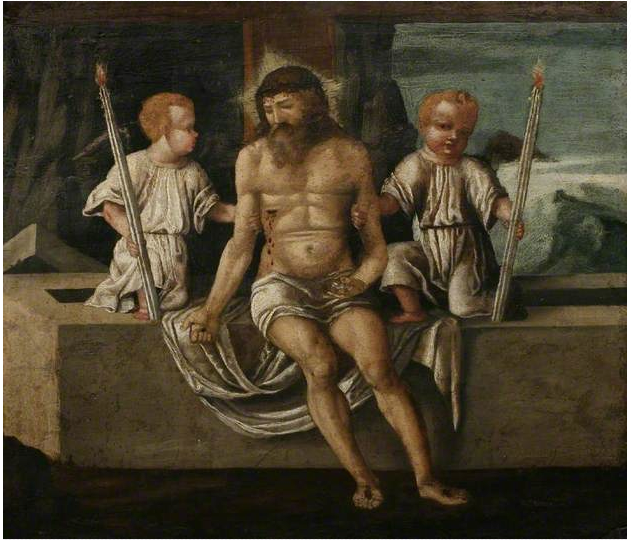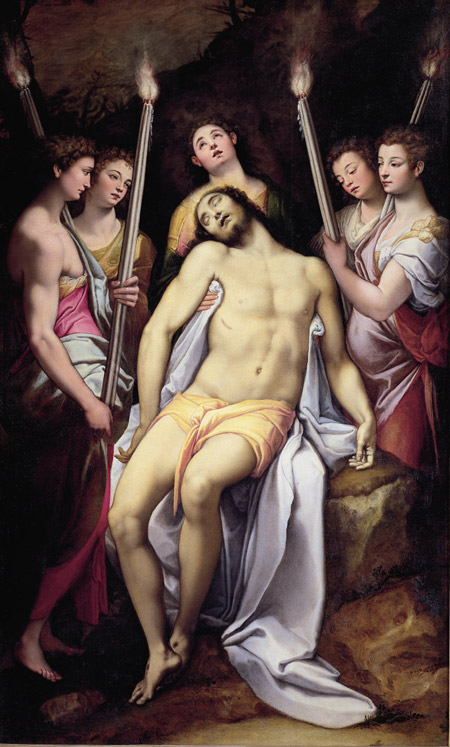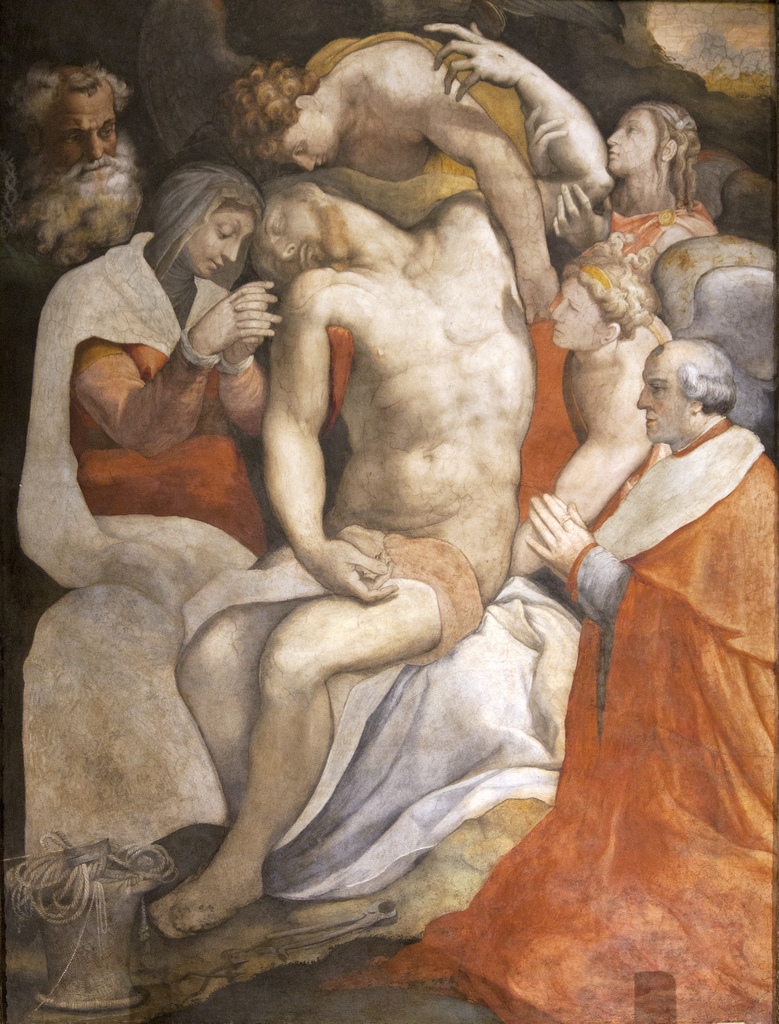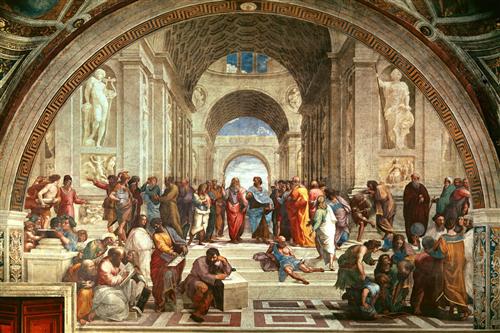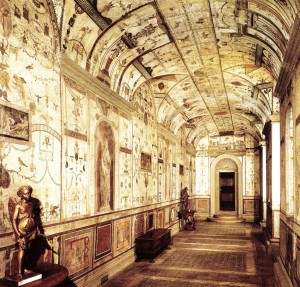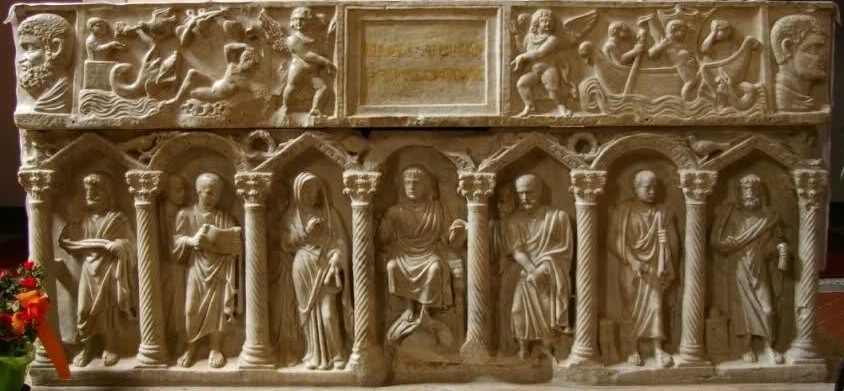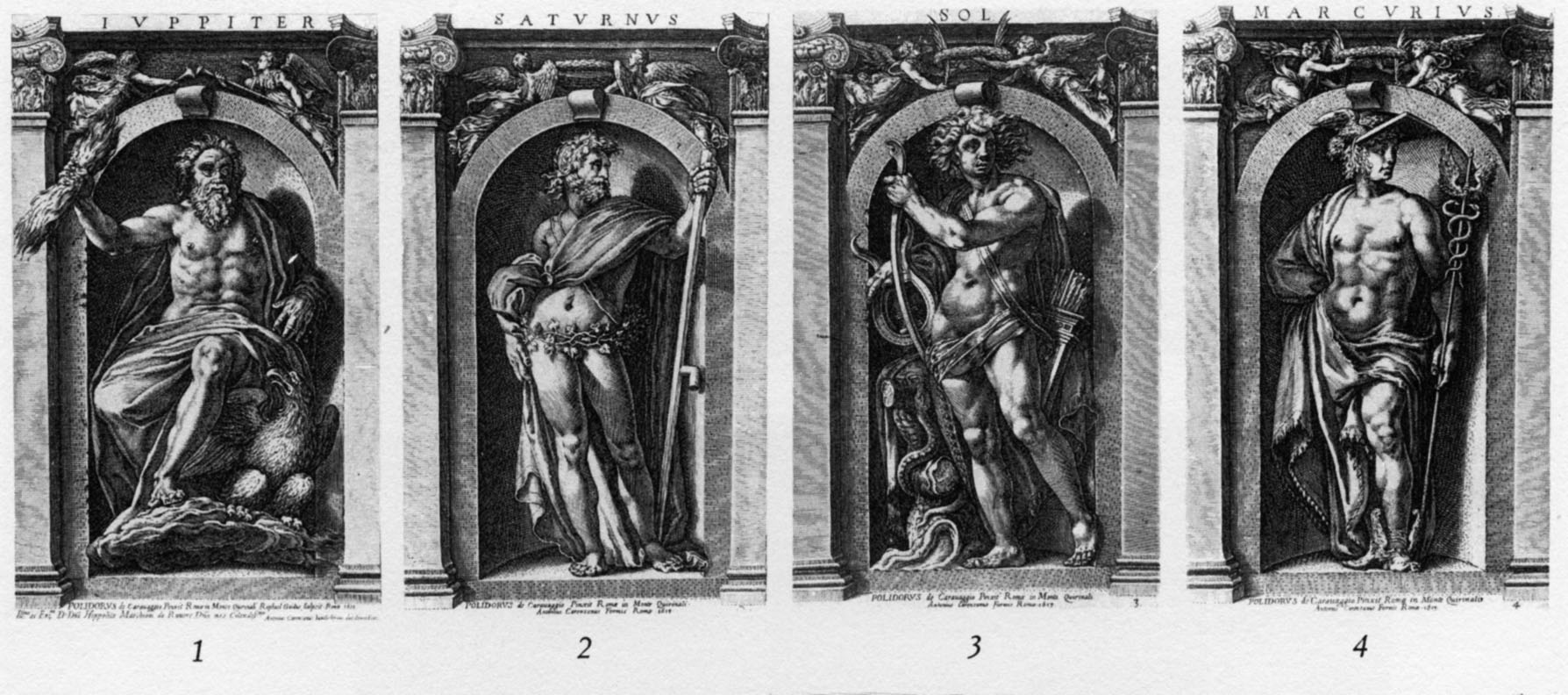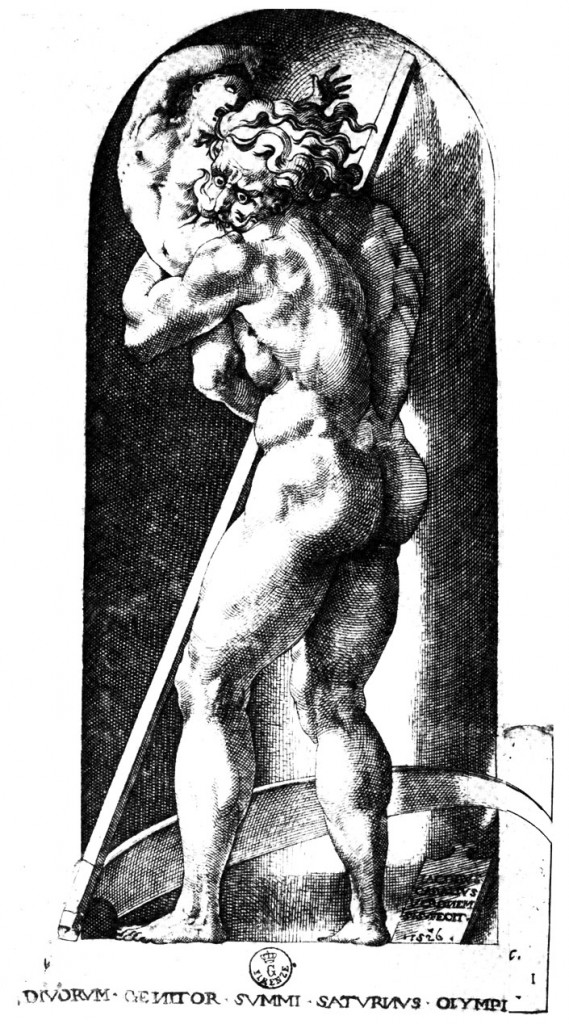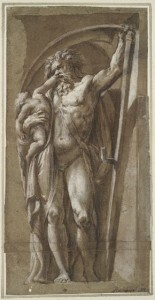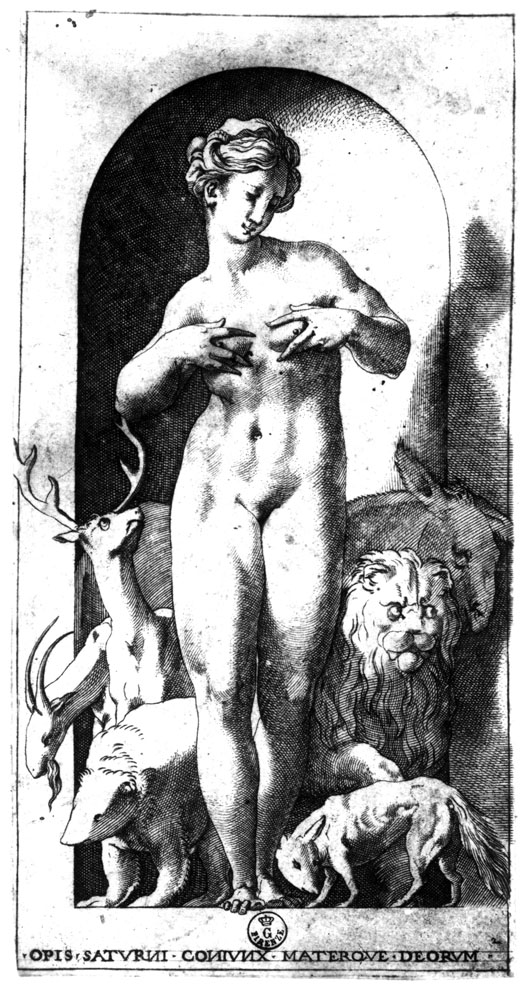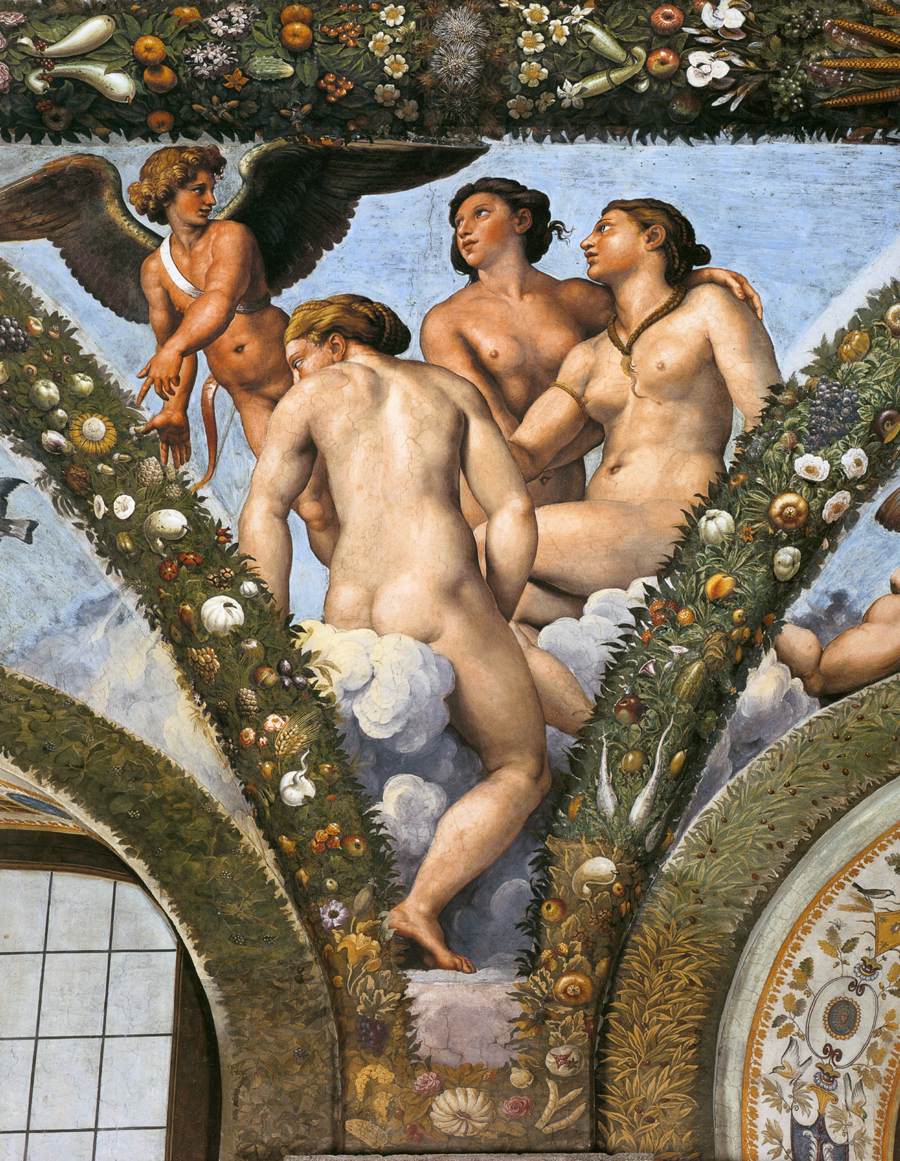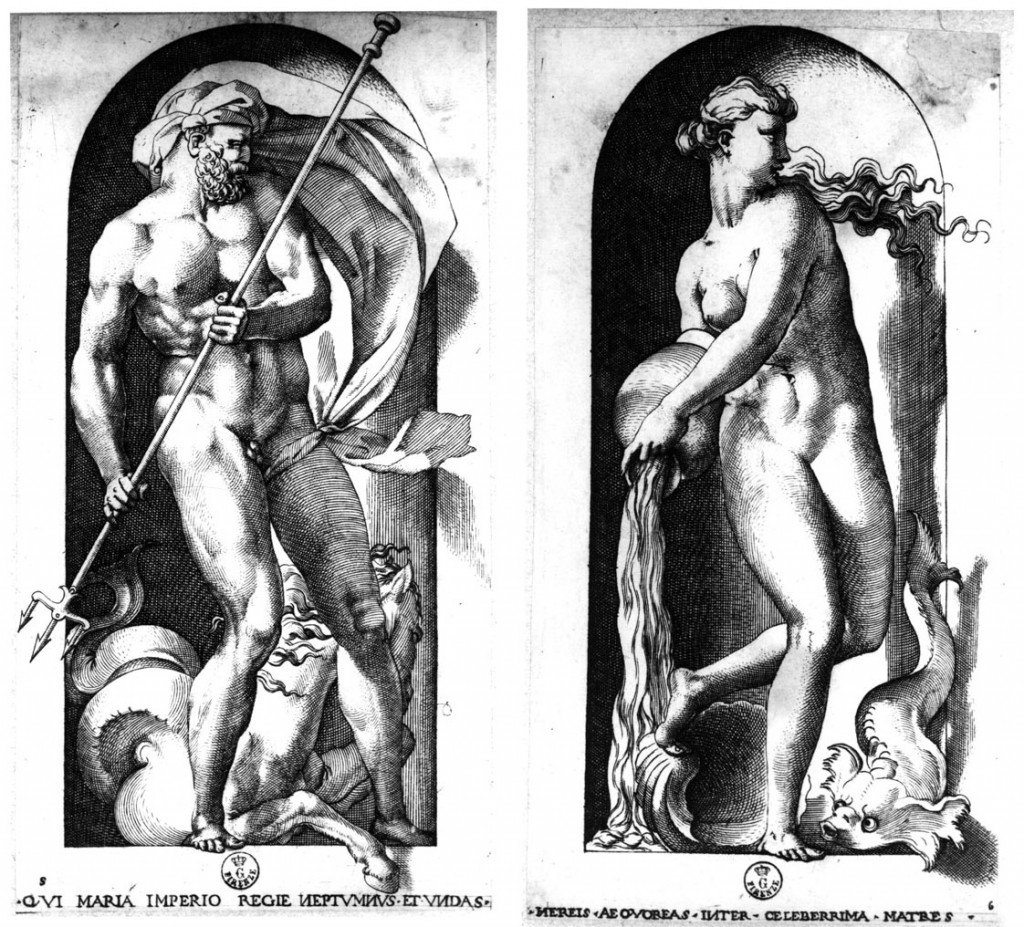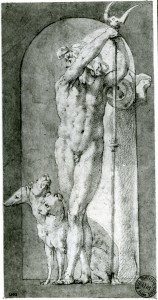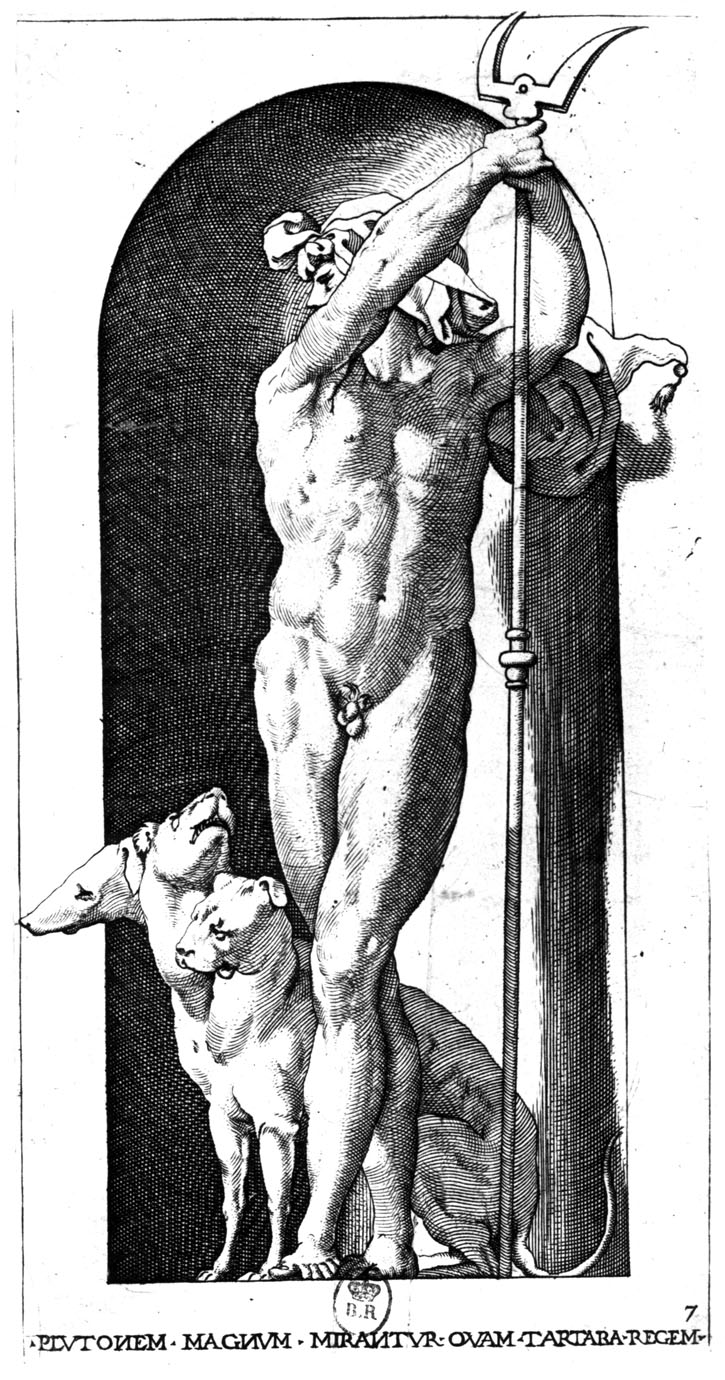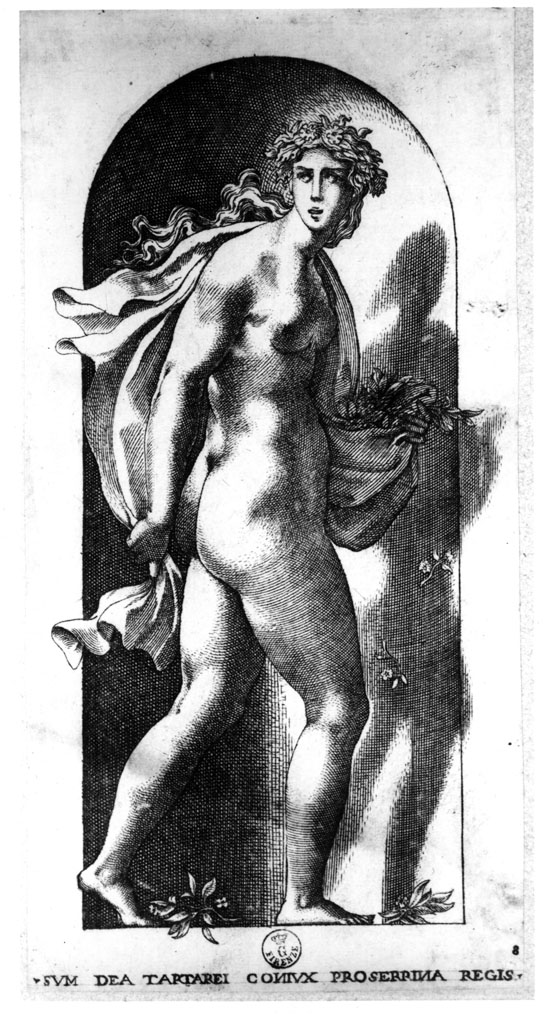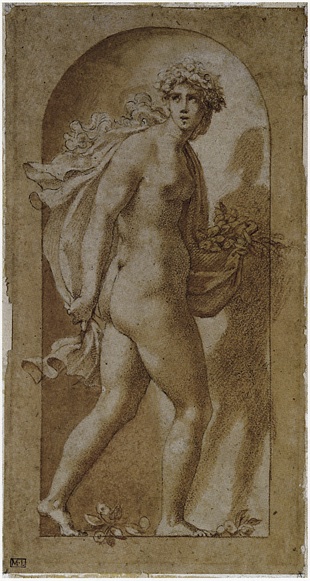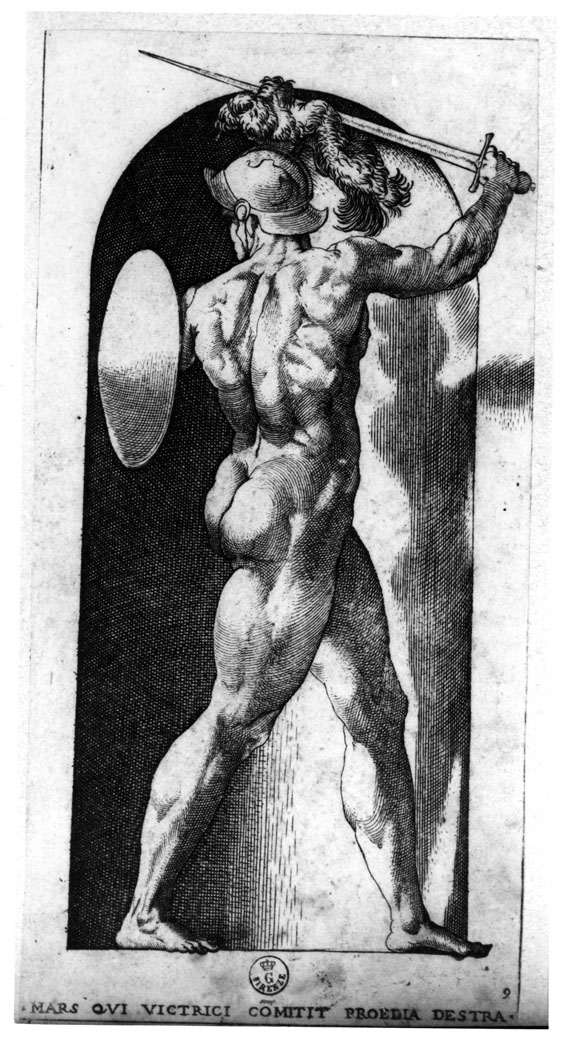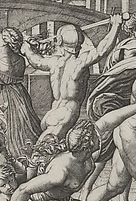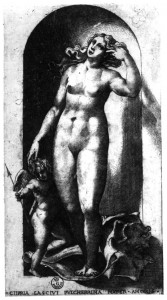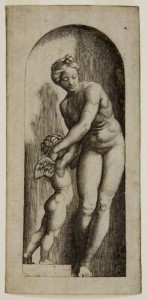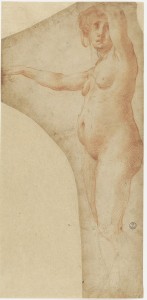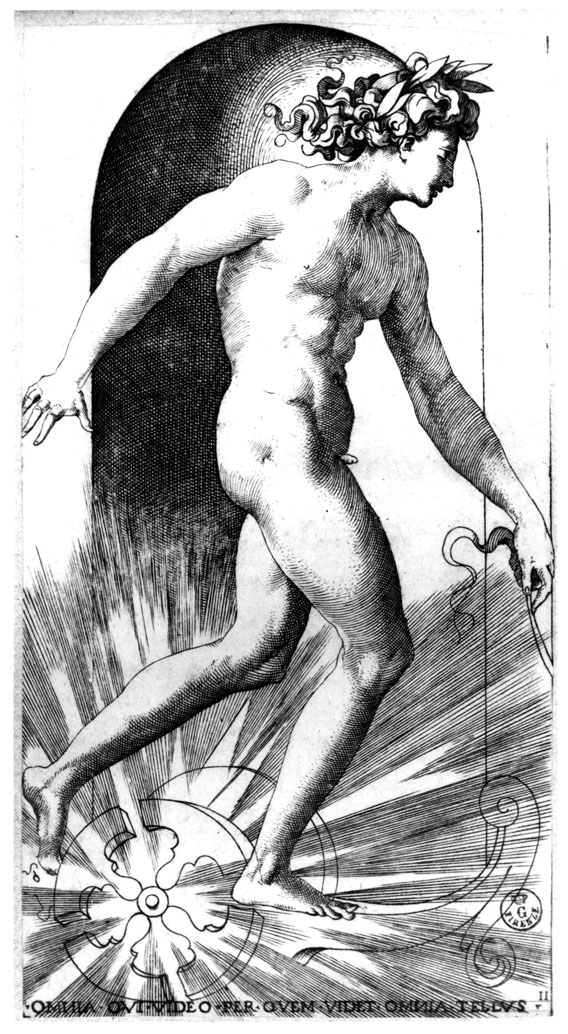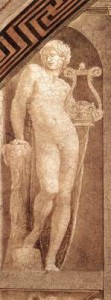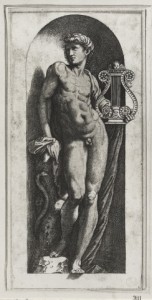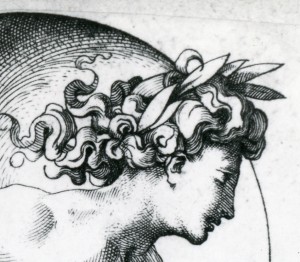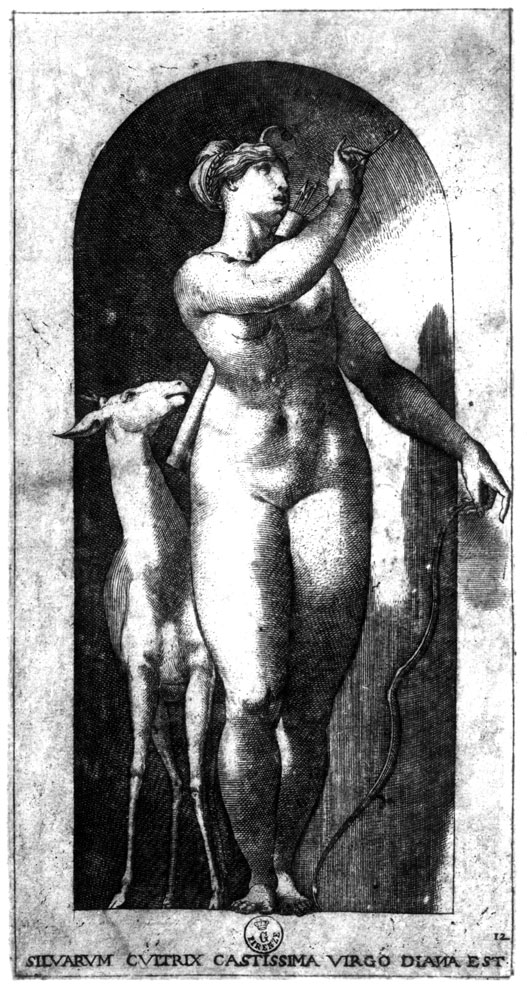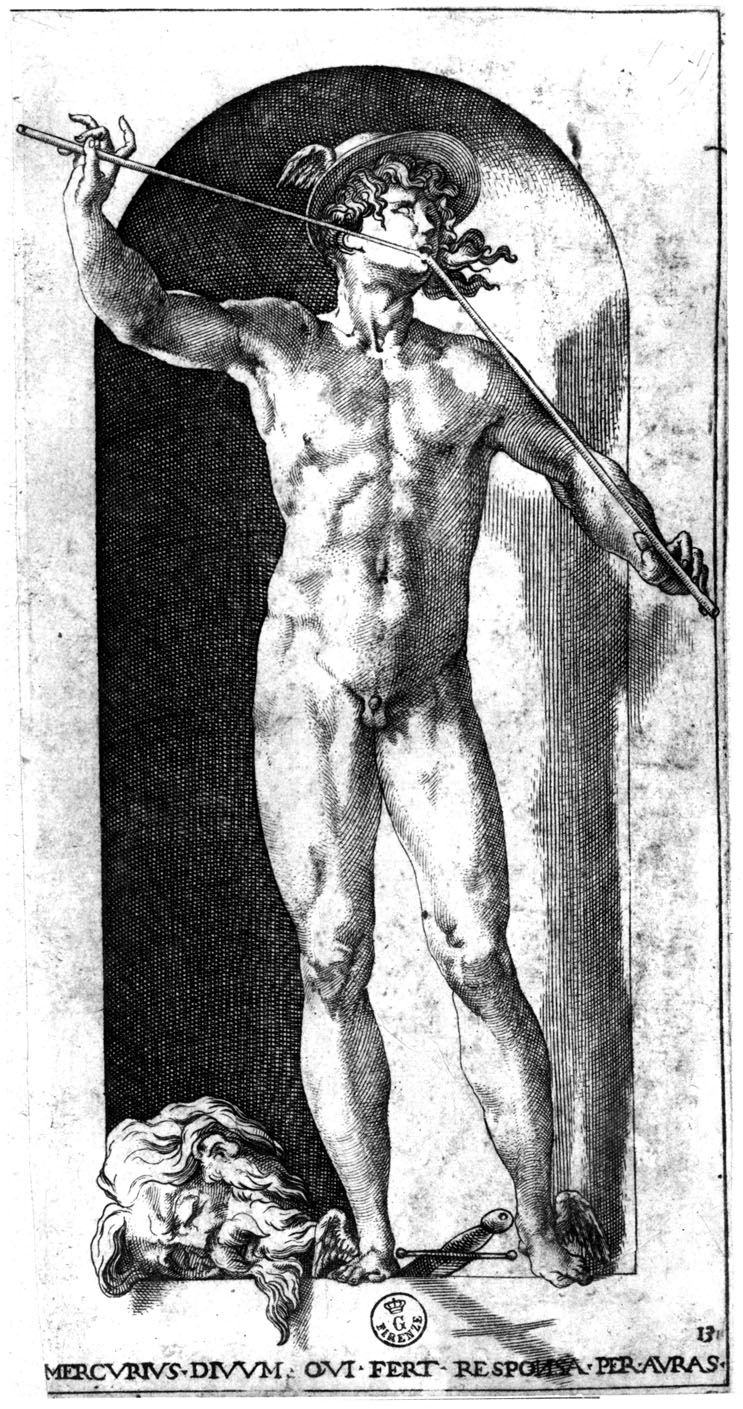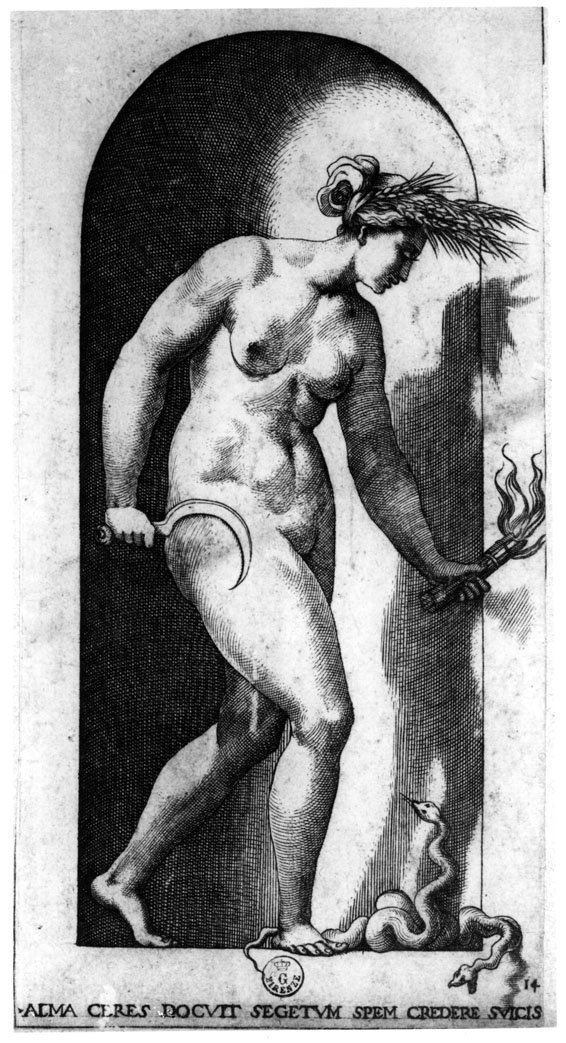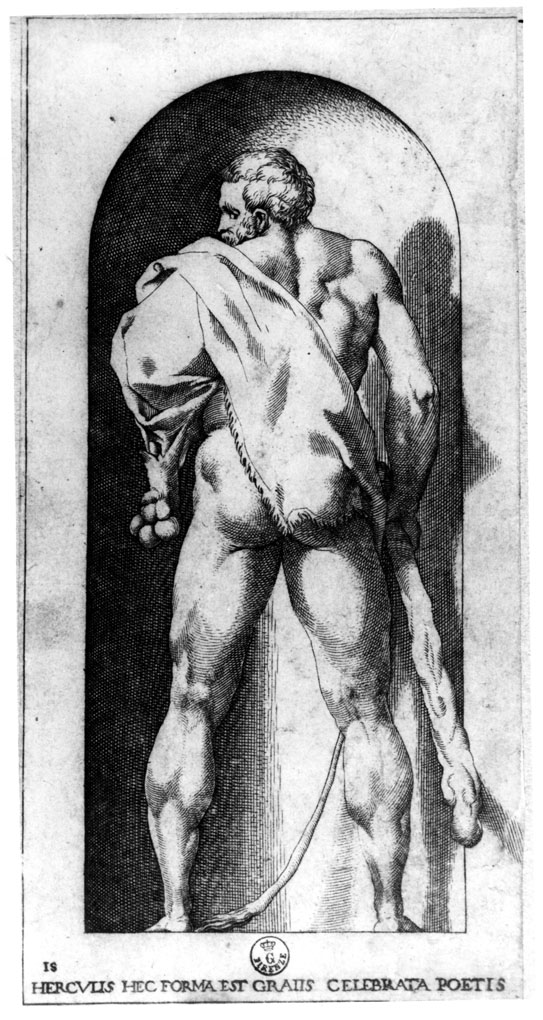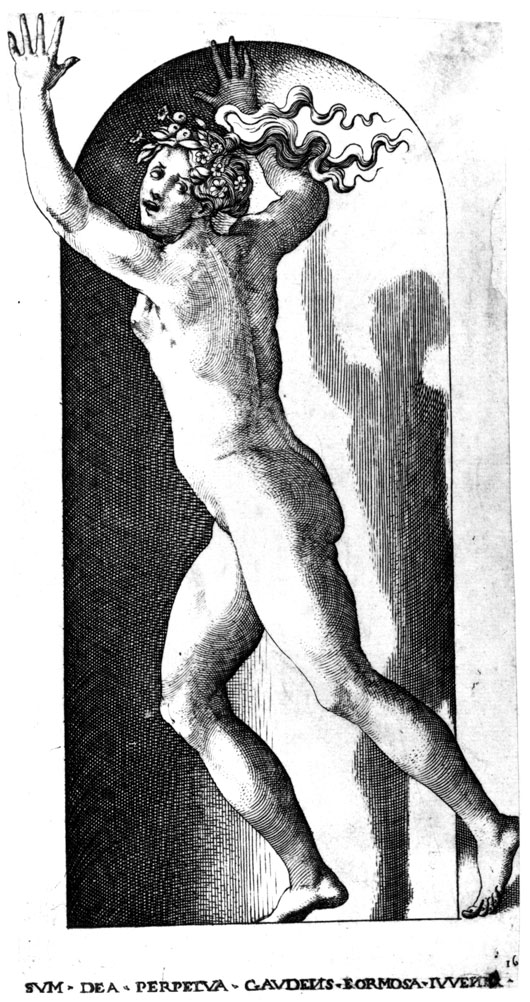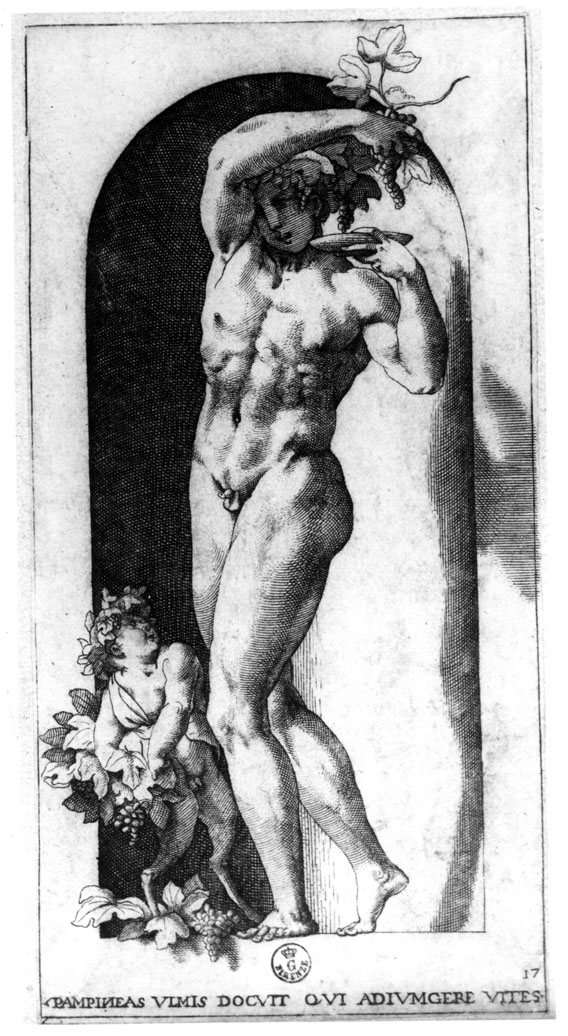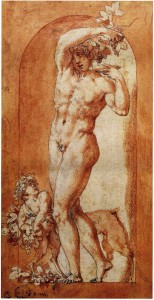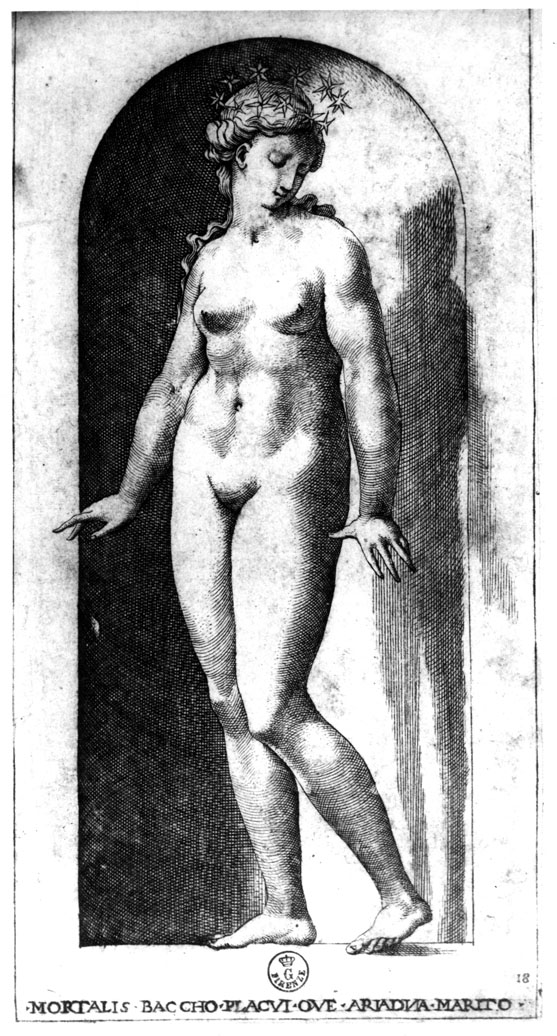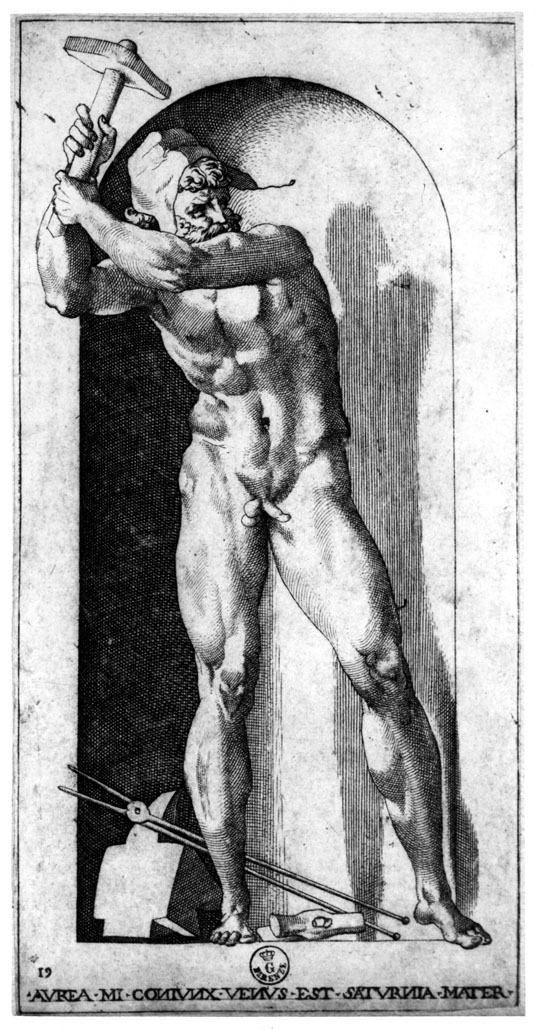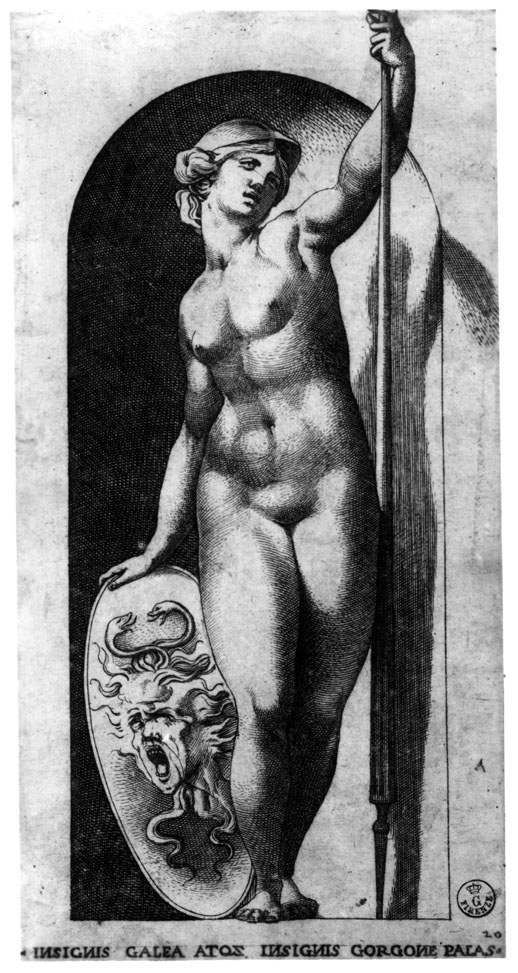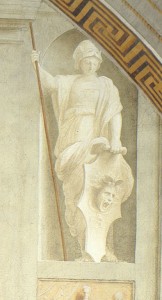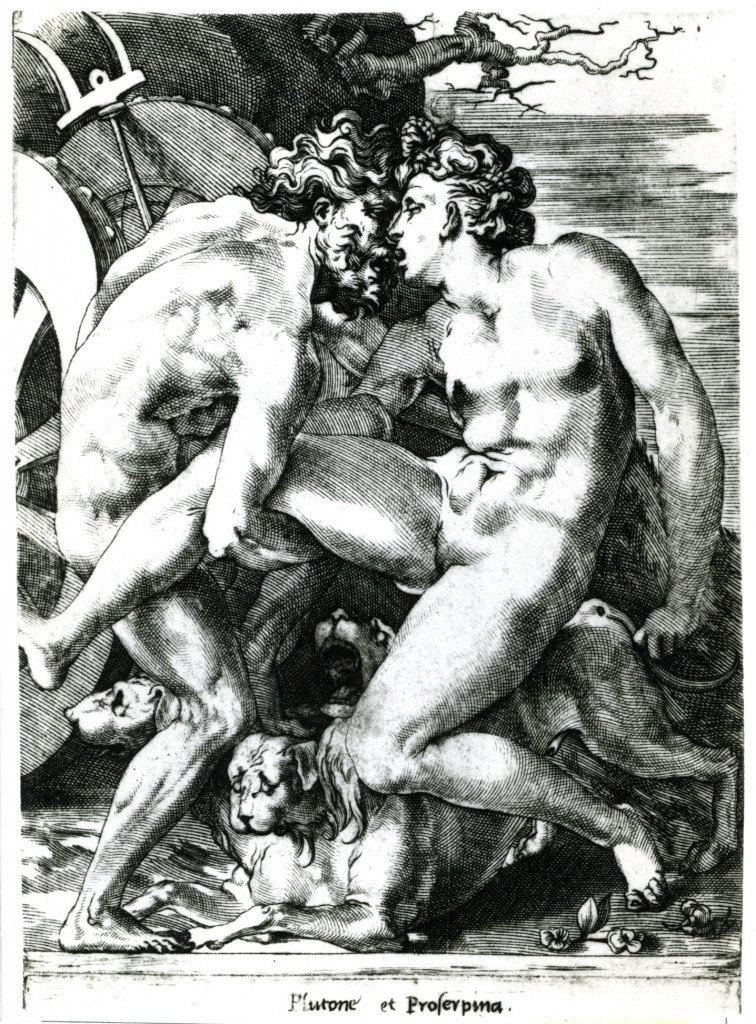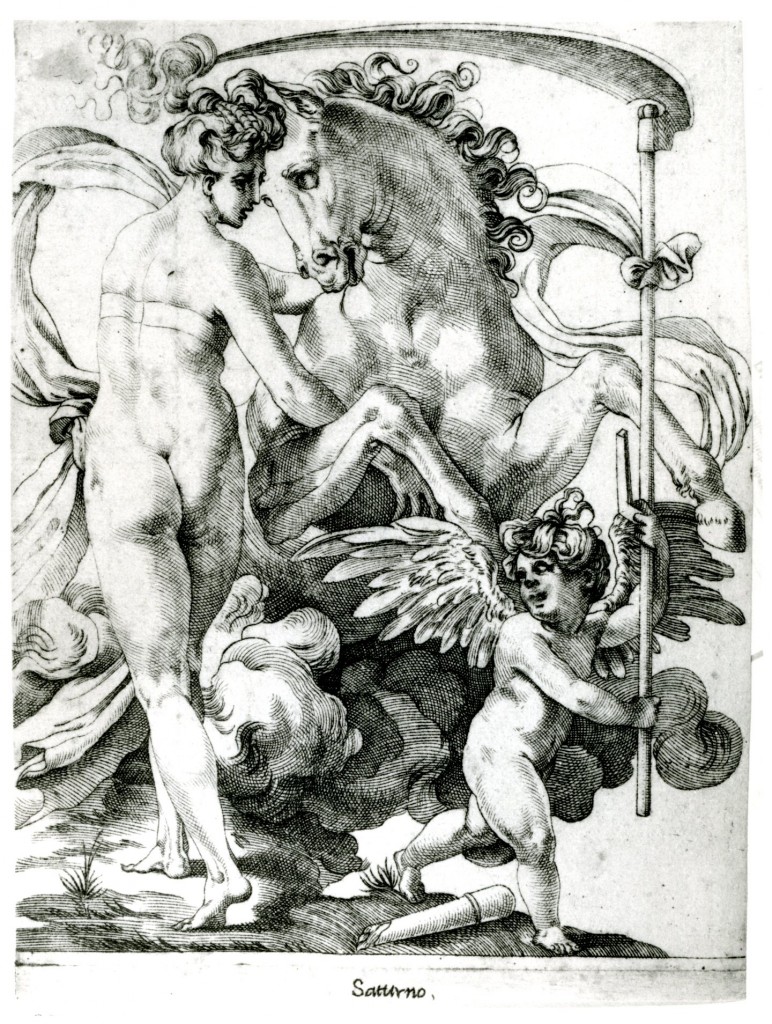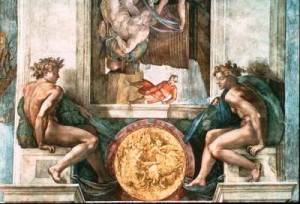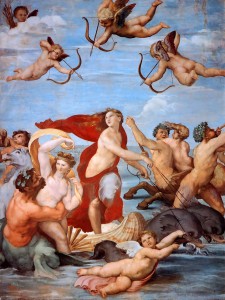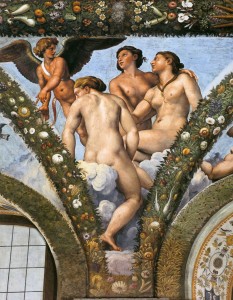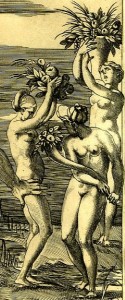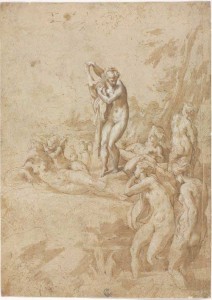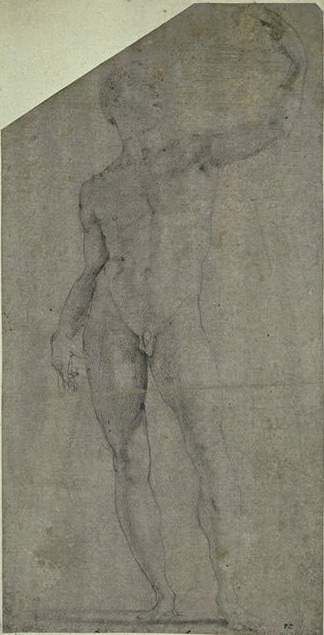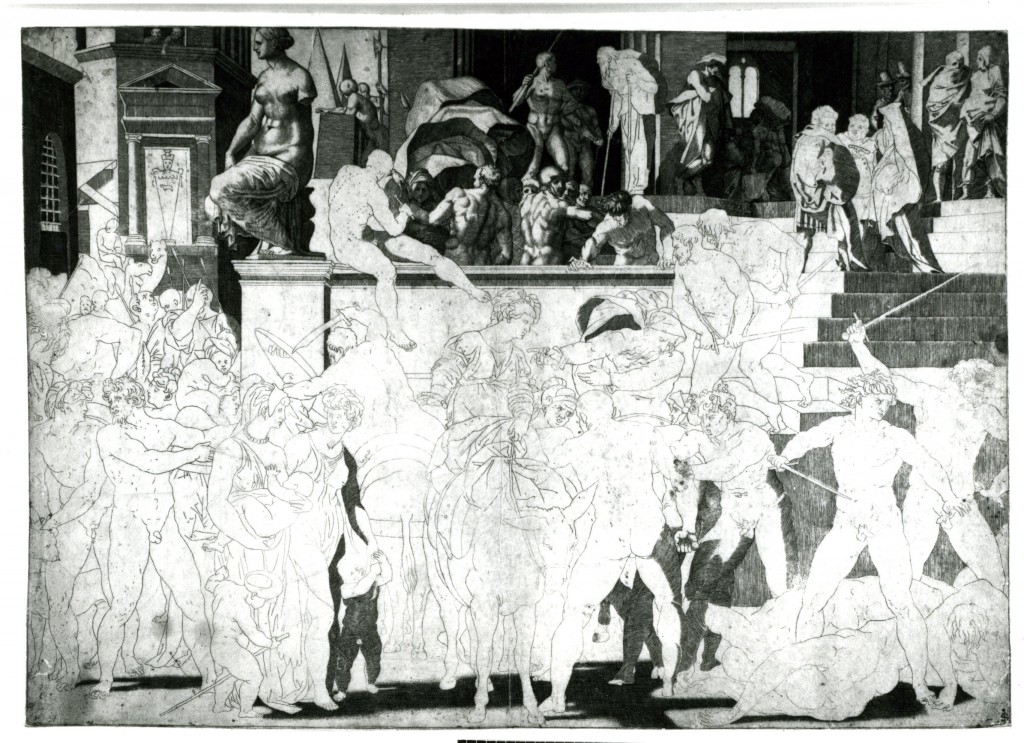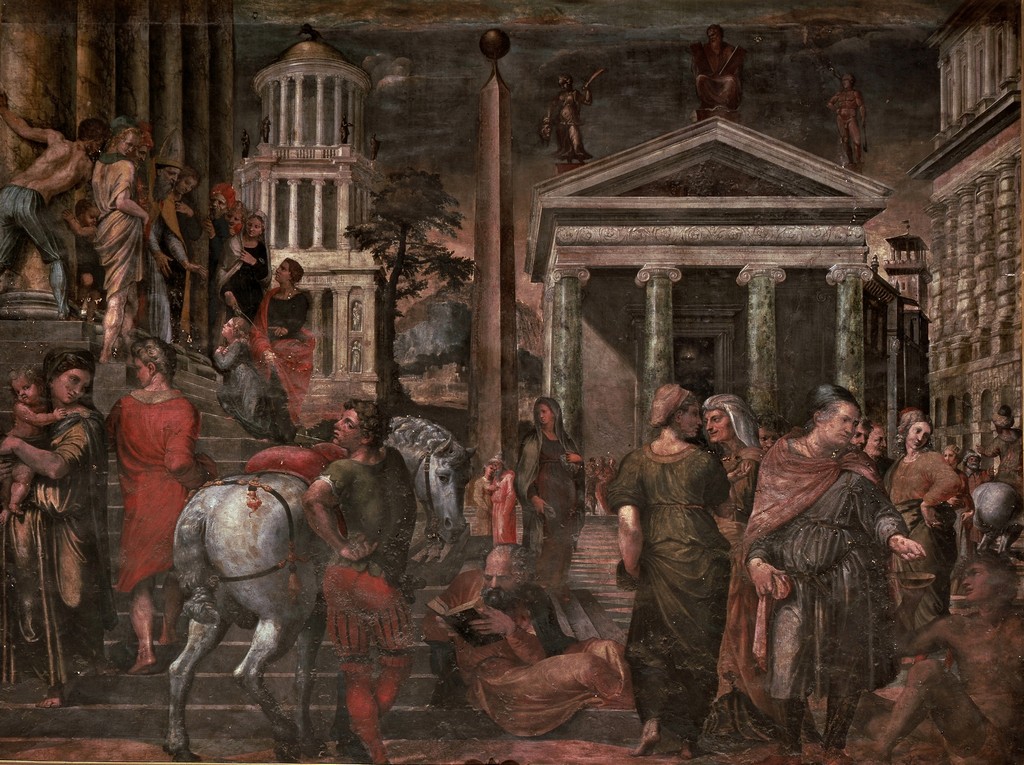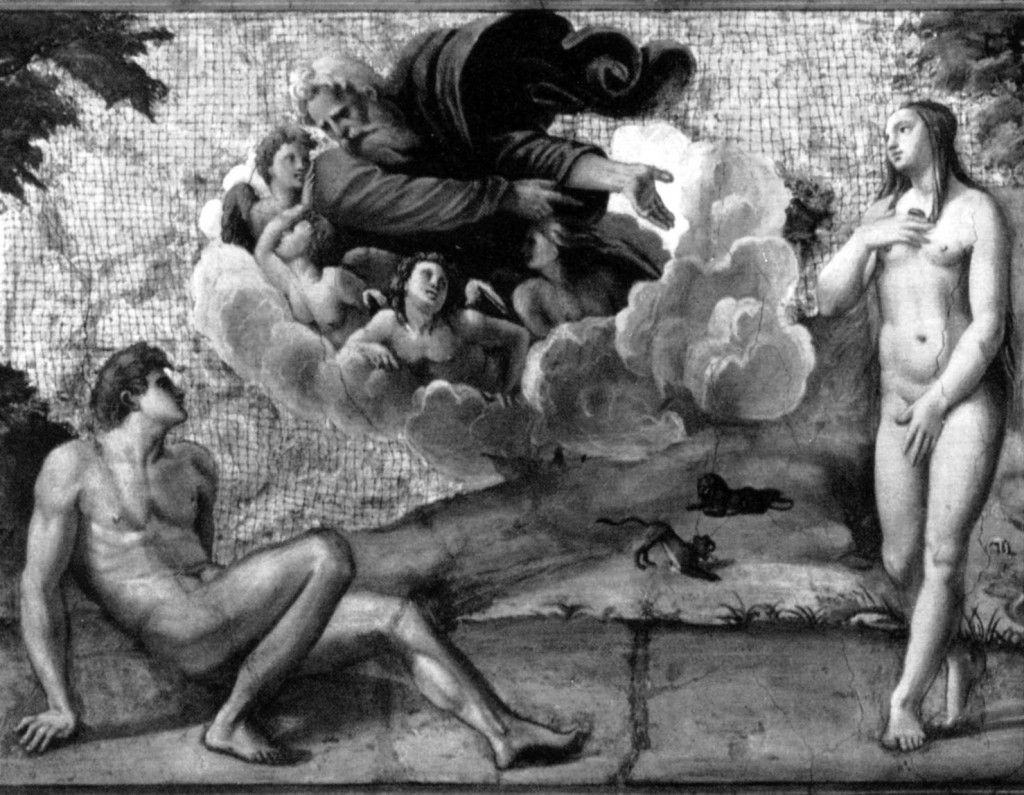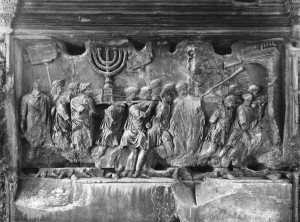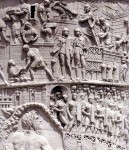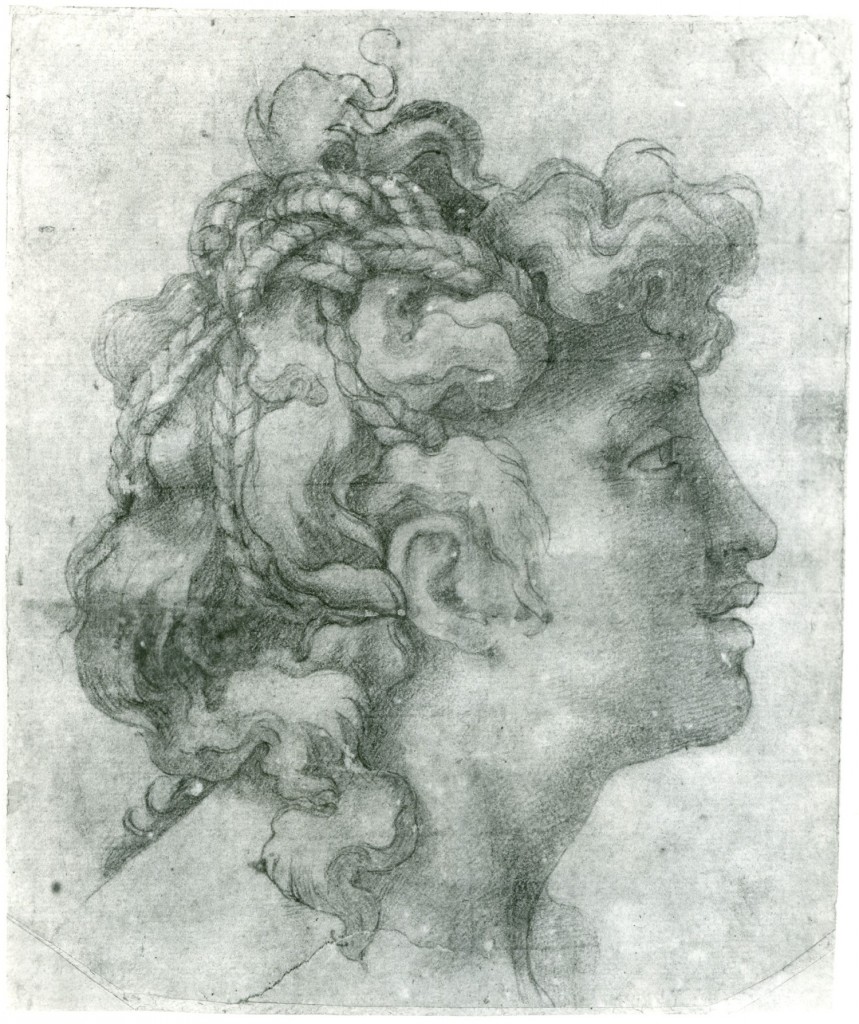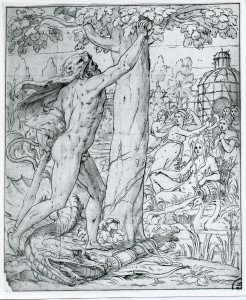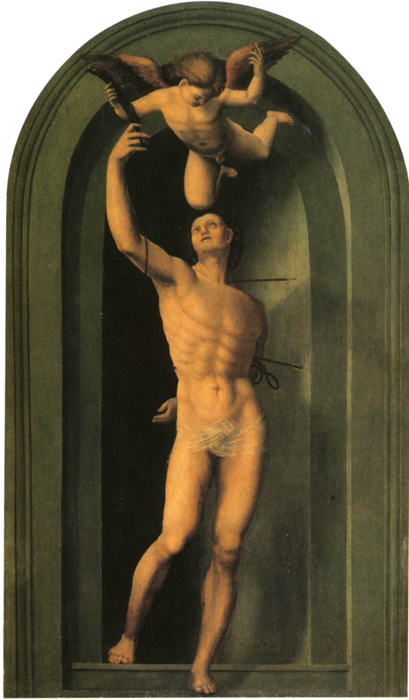Rosso’s work in his late Florentine years shows very dissimilar creations following one upon the other. In retrospect what one begins to see from the time of his return to Florence from Volterra around 1522 is not so much the maturation of the expression of his feeling or the deepening of his intuition about the emotional aspects of art but rather an increasing facility to manipulate the terms of art itself, to invent various modes of painting and to be unlike in style and emotion particularly the art of those on whom his artistic education was largely based: Sarto, Fra Bartolommeo, and Michelangelo. These intentions also suggest his awareness of the special artfulness of his works and his desire to create and maintain his individuality as an artist. In the context of a consideration of Rosso’s art between 1522 and 1524 the suggestion of a self-consciousness art historical position on his part, two decades before Vasari began his Vite, might be overstated. Nevertheless, it is well to bear in mind the often quoted “opinione contraria” of his when we begin to look at his activity in Rome.
Of Rosso’s departure for Rome we can only be sure that it occurred after he had painted the Rebecca and Eliezer for Giovanni Cavalcanti for shipment to England. The Moses was probably painted earlier but then kept by Giovanni Bandini, who had commissioned it, until Giovanni Battista della Palla called for the quadro d’ignudi to be sent to France as mentioned in a letter written by Bandini on 2 March 1529, long after Rosso has left Rome. In Rome on 26 April 1524, the artist signed the agreement to do the frescoes of the façade, the altarpiece a olio in tavola and altre pitture e adornamenti di Capella di stuchi within the Cesi Chapel in S. Maria della Pace. On this date he was also paid the first of three installments for the work that had already been done (ho facto questi in mia mano). The architecture of the chapel, by Antonio da Sangallo the Younger, would have been sufficiently completed well before the date of that commission to receive the two frescoes at the highest level of the façade of the chapel. At this level of the single clerestory facing the nave, only the frame of the window and the moldings at the edge of the arched wall are architectural features of a much smaller and simpler church than the grand baroque temple that it became in the seventeenth century. Rosso’s Creation of Eve is at the left of the window, his Fall of Adam and Eve is at the right. Above the window a decorative plaque in fresco is inscribed: A • S • M • D XXIIII.
It has been thought that Rosso was aware of the Cesi Chapel commission before he left for Rome and that he arrived there only shortly before he began the two clerestory frescoes. So, too, it can be thought that it was this commission that brought him to Rome. But the situation may have been otherwise and with an artist of Rosso’s temperament another story or stories should be considered. After the failure of the Orti Oricellari conspiracy of 1522 to kill Cardinal Giuliano de’Medici it is possible that Rosso, supportive of the republican cause behind this failed plot and never employed as an artist by the Medici in Florence, had it already in mind to move to Rome upon the death of Leo X on 1 December 1521, or during the papacy of Hadrian VII. The death of Hadrian on 14 September 1523 leading to the election of Giuliano de’Medici as Pope Clement VII on 19 November 1523 would have been a disappointment, possibly even a threat. But the alternative story about the Cesi Chapel commission having brought him to Rome around April of 1524 took place when Clement had already been pope for five months.
We know from Vasari that Rosso sent drawings to Rome and that they were very highly praised, leading to grandissima aspettazione of his arrival there. The sending of his drawings alone suggests that he was preparing for his reception in Rome by those who received these drawings and by all those who saw them, including possible patrons. It is a measure of his ambition that he prepared for this move, not merely as a visit perhaps but as a long time resident.
It is not known when the execution of the Marriage of the Virgin, dated 1523, was actually completed that year, which, according to the Florentine calendar, could have been in the first three months of 1524 modern style. Then there was the painting of the two pictures for Cavalcanti and Bandini. Might these have been executed quickly in 1523 modern style before the election of Clement VII? In this case, Rosso’s decision may have been due to his own wish to leave Florence and, after seeing Perino del Vaga’s Roman style on his visit to Florence in 1522–1523, find a new career for himself in Rome. He might have known about the Cesi commission before Giuliano de’Medici was elevated to the papacy but could not yet leave Florence because of the work he had still to complete there. Alternatively he could have gotten to Rome on his own initiative in 1523 while Hadrian VI was still alive and before Clement VII’s reign began.
The sooner he arrived in Rome the longer would have been the period before he had to begin the Cesi Chapel frescoes in which he could have become acquainted with the great achievements of Raphael and his pupils and of Michelangelo. Not long after his arrival in Rome he may have had the occasion to paint the Portrait of a Man with a Helmet in Liverpool (P.16). Already famous for the drawings that had arrived in Rome well before he appeared himself, Rosso may soon have been approached by Baviero de’Carrocci, called il Baviera, the publisher of the rising print trade, about making disegni di stampe for Gian Jacopo Caraglio. The Fury (E.18) could then have been Rosso’s first response to the artistic milieu of Rome.
When Rosso arrived in Rome with his assistant Batistino and his pet ape1 he had never been to another artistic center that rivaled or surpassed in the grandeur of its art the city where he was born, educated, and where he had been mainly active as an artist. To a certain extent his return to Florence from Volterra in 1521–1522 appears to have had an effect on him not unlike that created by an arrival in a new city. For the private, even idiosyncratic, aspects of the art that he produced through 1521 were very deliberately altered in his Dei and Ginori altarpieces in response to artistic demands that earlier in Florence he seems to have ignored. It is, therefore, possible to see Rosso’s adaptation to the circumstances of Florentine art and his imaginative exploration of them after his return from Volterra as the beginnings of a new kind of artistic activity that would continue throughout his years in Rome. Seen in this light the creations of his three years in Rome may be evaluated more justly even as their particular Roman character is recognized to distinguish them from his Florentine works.
These three years in Rome are recorded by more works than in any other comparable period in Rosso’s career: thirty-one disegni di stampe, a pair of large frescoes, a portrait, an altarpiece for a private chapel, and a number of drawings of which only a few survived the Sack of Rome that drove Rosso from the city. One Roman work mentioned by Vasari has not survived, a bozza of the Beheading of St. John the Baptist. Twenty of his Roman works belong to the engraved series of Gods in Niches and six to the engraved Labors and Adventures of Hercules and these, together with the other prints, paintings, and drawings are remarkable for the variety of their inventions. It is not only the individual works of art that represent, sequentially, the nature of Rosso’s ambitions and achievements in Rome, but also, in the series, the conglomerate of artistic possibilities in rivalry with each other. During his short time in Rome we see not a single Roman style but rather a diversity of manners. All bear the mark of the Roman ambiance in which they were made but also the expression of Rosso’s ingenuity that never failed to serve him, here and elsewhere, in revealing his Florentine origins.
In his Life of Rosso Vasari devotes only a page to Rosso’s Roman years and mentions very briefly his work with Caraglio. This aspect of his activity is fully related later in two paragraphs devoted to Marcantonio and other engravers. Here the prints that Rosso designed are listed in what seems to be the order in which they were created. When, however, the first, the Fury, was done cannot be determined from either overview by Vasari of Rosso’s activity as a designer of prints. The loss of the Cesi Chapel commission was, according to Cellini’s report as considered below, the reason for Baviera’s invitation to Rosso to work with Caraglio. But this was not the sole reason that Rosso began to work for Baviera and with Caraglio as Cellini’s whole story reveals. Sangallo was also down on Rosso for criticizing his architecture and pursued the painter for his own reasons.
Although as a young man in Florence Rosso seems not to have wanted to follow the style of any single master, upon his arrival in Rome, at the age of thirty, it was the grand manner of the frescoes of the Sistine Ceiling and of the Vatican stanze that he wished to take on as his own. This is what has to be concluded from the style of Rosso’s frescoes of 1524 at the highest level of the façade of the Cesi Chapel in S. Maria delta Pace. These two scenes of the Creation of Eve and of the Fall of Adam and Eve were severely criticized by Vasari in 1550 and judged by him to be the worse paintings that Rosso ever did. In 1568 this judgment was repeated and emphasized by the implied comparison of Rosso’s frescoes with Raphael’s above the adjoining Chigi Chapel and by the explanation that “nell’aria di Roma” the experience of the grand architecture and sculpture of Rome and of Michelangelo’s statues and paintings seems to have caused Rosso to lose his direction (forse lo cavarono de sè).2 Vasari’s opinion can still be appreciated but it is somewhat undercut by his final comment that the latter part of his explanation concerning Rosso can also account for Fra Bartolommeo and Andrea del Sarto fleeing Rome without leaving any works behind. It might also be pointed out that Pontormo may have visited Rome and likewise left it without having accomplished anything.3
Overlooking the fact that the Frate did actually begin work in Rome4 it remains to be recognized that of these four Florentine artists who had long careers in Florence Rosso is the only one who stayed to face the challenges that Rome presented. Consequently, he was the only one who had a Roman career that produced a Roman oeuvre. The appearance of Rosso’s Roman frescoes of 1524 can to a large extent be considered the result of Rosso’s ambition to establish himself as an artist in Rome on the terms that the art of Rome had itself laid down. For we can assume from these paintings that he was competing for a place equal to that of Giulio’s earlier Roman career, to that of Polidoro, Perino, and Sebastiano and it is debatable that Rosso’s first paintings in Rome, in spite of Vasari’s criticism, were any less an accomplishment than any of theirs up to this moment in 1524. What should surprise us in this Roman context is the degree of heroic grandness of Rosso’s frescoes and the evidence they give of Rosso’s aspiration to know the terms of Michelangelo’s Roman art, remarkably different from what is indicated by his immediately preceding and only superficially Michelangelesque Moses defending the Daughters of Jethro. As for Vasari’s intentions behind these remarks that Rosso’s never did worse following upon remarks on the disorienting Roman works of Michelangelo can be viewed as an aspect of the plot of the Lives that leads to the triumph of the great Buonarotti.
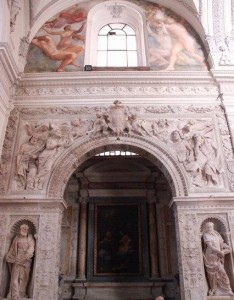
Cesi Chapel, S. Maria della Pace, Rome, from below
Only since their cleaning and restoration have the two frescoes been visible as Rosso intended.5 Rosso was faced to execute two closely related Old Testament subjects of three figures each in two large quarter circle areas of wall separated by a window and high above the floor of the church from where the viewer would have the only view of them. Other than the aria di Roma Vasari never exactly specified what it was that made these frescoes the worse (peggio) works that Rosso ever did. It may have struck him as it does now that the figures of Adam and Eve in spite of their distance from the viewer are too large and the space in which they exist too limited for them. But the large and deeply set window had also to be taken into account and for the artist the wish to see the two scenes dramatically related across the actual deep space in which this window is set. Again here Rosso is finding his own expression of these very important and powerful stories of the God’s creation of Eve and her downfall in sin and her introduction of Death to mankind. The large size of Rosso’s figures may have struck Vasari as beyond the decorum of the relationship between form and space that had long been the rule. Rosso may have abandoned this relationship in favor of the figures so that they could be seen clearly by the viewer and from a sharp angle while approaching the Cesi Chapel within the narrow nave of the church.
The Creation of Eve and the Fall of Adam and Eve are composed in what might be considered a kind of contrapuntal relationship to each other. Each scene contains three figures in approximately the same places, Adam in the foreground, Eve behind him, and above them God the Father, in the Creation, and the Serpent in the Fall, in the narrowest part of each half lunette. In the left fresco Adam is seated at the left seen from the front and leaning backward, asleep. He lies on a huge rock that is cut to fit the profile of his large torso and is then squared off at the bottom. The toes of his left foot extend over an illusionistic rounded molding. On a smaller rock to the right, squared at the left end to fit tightly against the large rock, is placed Adam’s left foot. There is very possibly here the suggestion of the material out of which God created the first man. Adam’s hands are barely invisible behind his arms raised over his head. Eve is upright near the center of the fresco, her arms widely outspread and lifted high forming a great arc; her hands are open and her head thrown back to view the figure of God. Her abundant hair, tied tightly close to her head, blows out as a great wave with rivulets. God floats in above Eve from the left, his strongly foreshortened left arm extended forward. The palm of his widely open hand appears just above Eve’s open hand. God’s raised left hand can be seen above his head suggesting the direction from where he came. (This hand is badly damaged.)
In the Fall Adam is standing, his torso seen at an angle from the back with his bent arms extended outward to the sides. Adam’s legs are seen from the sides and the first two toes of his right foot turn over the rounded molding that frames the scene. His right hand grasps a large branch of the fruit tree in the Garden of Eden to steady his turn in the direction of the woman seated in the tree. Adam’s left hand is seen from the back alongside the partially open hand of Eve that is about to receive the piece of fruit still held by the woman with a serpent’s tail (perhaps barely visible in the space between Adam and Eve). Eve is seated rather awkwardly upon what may be a pyramidal rock with her arms raised almost straight up, her left hand grasping the large branch that Adam also grasps. Eve’s right hand is open to receive the piece of fruit held by the serpentine woman. Her hair is beautifully waved and braided and possibly set with jewels unlike the loose windswept hair of Eve at her birth. Already before she had received the piece of fruit offered by the serpentine woman Eve had become fashionable along the lines of Michelangelo’s teste divine. Before its appearance here there had been no indication that these divine heads carried the connotation of evil. The serpentine woman turns her head abruptly from the viewer’s right to left with her left hand over her head reaching for a piece of fruit on a small leafy branch of the Tree. As already mentioned her right hand holds a piece of fruit from that Tree over Eve’s partially opened hand.
The dramatic relationship of these two scenes as well as the largeness of the figures clearly show that Rosso had carefully directed his attention at Michelangelo’s Temptation and Expulsion. The body of Adam in Rosso’s Fall of Adam and Eve also seems to reflect the turn of the Libyan Sibyl. But the Sistine aspects of Rosso’s frescoes are not merely imitative of Michelangelo’s art; nothing in them specifically adheres to one of Michelangelo’s scenes or figures. The Adam of Rosso’s Creation is related to a figure in his own Rebecca and Eliezer and the Eve of this fresco and the Adam of the other also suggest certain elements in the Moses. Both of these earlier paintings are in their own way Michelangelesque and indicate to some extent the degree to which Rosso in Florence was prepared to meet more fully in Rome the terms of the Sistine Ceiling. In the Moses and the Rebecca and Eliezer pictures it was Michelangelo’s nudes in the Battle of Cascina that Rosso knew. The figures and compositions of Rosso’s Roman frescoes aspire to, and achieve in their way, the dimension of Michelangelo’s humanity. Rosso’s figures fill the picture areas they occupy as do Michelangelo’s, especially the later scenes of the Sistine Ceiling, but not simply to fill these areas with figural inventions as seems so much the case in the Moses and in the Rebecca and Eliezer. The slumbering Adam of Rosso’s Creation of Eve appears almost to be giving birth to the grand figure of Eve who rises from his side in response to the gesture of her Creator. In the Fall the turn of Adam’s enormous body suggests the force of his acceptance of the fate that will be offered him by the now withdrawn Eve. A serious psychological condition inhabits these great figures and the drama that their compositional relationships narrate. The broad grace of Rosso’s figures also suggests at this early date in Rome an appreciation of Raphael’s Roman art. All three figures of the Creation of Eve and the Adam in the Fall move with a grandeur that was fundamentally learned from Raphael’s figures rather than Michelangelo’s, even those by Raphael so very near at hand in the Chigi Chapel, next to the Cesi Chapel, in which he had painted his sibyls and angels in 1514 (Fig.Raphael,Pace).
Rosso’s figures are, however, even larger than Michelangelo’s and herein lies one aspect of their distance from the character of the latter’s Sistine Old Testament figures. The breadth of Rosso’s figures whose limbs reach to the limits of these scenes exceeds in its effects the quality of the specific definition of their anatomy. This is very apparent in the red chalk study in Edinburgh for the figure of Eve of the Fall.
In this drawing the observed anatomy of the model appears superficially generalized and without any indications of substantial structure. Hence while she appears massive the imprecision of her forms and of her posture, as evident especially in the size and position of her right leg, gives her a lumbering quality that separates her from the explicitly articulated figures of Michelangelo. This is also true of Rosso’s other figures above the Cesi Chapel whose bodies could seem more a burden than vehicles of expression. But a feeling of lightness comes from their blond tonality. The viewer may be led to respond to a grandeur of figures rising and turning as though not totally conscious of what is transpiring and hence not altogether unlike what Pontormo would effect in his Deposition at about this same time in Florence.
While what produces the appearance of this kind of experience in Rosso’s figures would be in large measure intentional, it is very likely the result, too, of Rosso’s historical relationship to Michelangelo’s art. For what Rosso saw as significant in Michelangelo’s figures was the expressiveness of their size and large movement. What, however, he was not in a position to appreciate was the knowledge that underlies their appearance and that still connects Michelangelo’s to the value given to knowledge in the art of the Quattrocento. It is true that we do not have in the Cesi frescoes that mere Michelangelesque veneer that is the pictorial matter of the Moses and the Rebecca and Eliezer pictures. But we also do not have an anatomy that is described so as to suggest that the feelings of the figures are visibly generated by it. While Rosso’s Allegory of Death and Fame of 1517 exhibits in its emaciated figures a knowledge of anatomy which can also be seen in the S. Maria Nuova Altarpiece, none of his individual figure drawings indicate any penetrating study of anatomy in relation to the action of the figures he drew. The most precisely drawn nude studies, such as the drawing for the figure of St. Sebastian of the Dei Altarpiece (Fig.D.7) or the Seated Male Nude of around 1523 (Fig.D.9), show nudes that are very carefully observed, their appearance recorded with the finest nuances of light and shade. But so far as anatomical structure is concerned, it is simultaneously undermined by these nuances as they record the extremely exacting attention that has been given to superficial detail. In the Moses and the Rebecca and Eliezer pictures, this kind of detail is generalized and becomes a pictorial substitute for verisimilitude. In the Roman frescoes and in the Edinburgh drawing, the details of the figures have been so reduced that the anatomy of the figures appears almost incoherent. But the influence of Michelangelo’s Roman art did infuse Rosso’s art with a quality of impersonal grandeur that, as a kind of feeling, replaces the deeply felt, and sometimes very deeply felt, but almost always, by comparison, very private expression of his earlier pictures, especially those in Volterra and from Villamagna. It also replaced the rather shallow stylistic wit of the Moses and the Rebecca and Eliezer.
Now that the Cesi Chapel frescoes have been restored it has become possible to give an evaluation of their style. As with the Uffizi drawing for the Dei Altarpiece the drawing in Edinburgh shows again how closely Rosso followed his drawings when he executed his painting. On the basis of the appearance of the Michelangelesque God-the-Father in the background of the Creation of Eve it may be possible, in spite of the damage at his forehead and at his right hand, to recognize a more extended range of stylistic possibilities in these frescoes than is represented by the nude figures of Adam and Eve. Not the smallness of this figure, that locates him farther back in space, but the rhythmic curves of his posture and what seems to be the definition of his pose largely through the handling of his drapery suggest a stylistic fineness similar to that of the Florentine Marriage of the Virgin on 1523. That such is the case, providing an exquisite foil to the large foreground nudes, is further suggested by the style of Rosso’s red chalk Seated Woman in a Niche in the Uffizi (Fig.D.11), that may possibly have been intended as a Virgin Annunciate for the Cesi Chapel that is dedicated to the Annunciation. This might mean that Rosso thought of a change in plans as his contract called for an altarpiece of unspecified subject although possibly an Annunciation, while the Uffizi drawing suggests figures in niches probably placed at an actual distance between them. Eventually the altar received a painting of the Annunciation by Marcello Venusti from a cartoon by Michelangelo.
The handling of Rosso’s drawing brings again to mind Vasari’s comment that Rosso’s arrival in Rome was greatly awaited because a few of his drawings were already known there and “erano tenuti maravigliosi, atteso che il Rosso divinissimamente e con gran pulitezza designava.”6 The draftsmanship of the Seated Woman in a Niche is almost identical to that of the late Florentine Seated Male Nude which may be the kind of drawing that preceded Rosso to Rome. Where, however, in the Florentine drawing the extraordinarily refined clarity of Rosso’s draftsmanship appears controlled by the precise attention that he gave to the model before him, in the Seated Woman in a Niche the draftsmanship appears also to be what has made her grandness almost transparent. The largeness of this figure is like that of the nudes of the Cesi Chapel frescoes and the study for Eve at Edinburgh. And yet the fullness of the woman in the Uffizi drawing is relieved of a sense of burdening mass by the brightness and extent of the light that falls upon her and by the graphic manner that describes and makes patterns of her into an especially artistic phenomenon. Although she, too, like the figures of Adam and Eve, is dependent upon Michelangelo’s figures, on the Erythraean and Libyan Sibyls in particular, her relationship to them is of a somewhat different kind. Instead of making an effect through emphasis upon corporealness the Seated Woman in a Niche, even though large, achieves its effect through the most explicit definition of shape, volume, and detail. The large fold of the drapery that falls across her lap and thigh is so precisely delineated and shaded, and so crisply faceted, folded and tucked under her knee that its appearance provides largely the pleasures of decoration. No plastic force relating the substance of this figure to her movement, as in the Libyan Sibyl, is indicated. In fact the drapery of Rosso’s figure largely masks the lower part of her body. The relation of her feet to the limbs under her drapery is not presented for serious consideration. As much as this figure is obviously dependent upon Michelangelo’s Roman art, and upon Rosso’s direct experience of it, the manner in which Rosso has taken advantage of it has been very deeply qualified by the artistic modes he had already invented for himself in Florence. The Seated Woman in a Niche remains very much heir to the frightened young woman in the Moses, to the figure of St. Apollonia in the Marriage of the Virgin, and to the female saint in the Dei Altarpiece, and still very much also to the figure of St. Margaret in the Study for an Altarpiece of around 1519. Between that figure and the Seated Woman in a Niche of 1524 the extent and character of Rosso’s maturation can be appreciated. That this includes an acknowledgement of the value of Michelangelo’s Roman art, and Raphael’s, cannot be denied; but it must also be seen that Rosso, susceptible to these influences though he was, was also very much inclined simultaneously to demonstrate his own position in relation to it.
The Portrait of a Man with a Helmet, in Liverpool, could possibly represent the Orsini Count of Anguillara with whom Rosso stayed at Cervetari in the early summer of 1524.7 It is the equivalent in portraiture of Rosso’s Cesi Chapel frescoes and of his Seated Woman in a Niche that the portrait most closely resembles. While wholly Florentine in its sources it is, nevertheless, possessed of a grandness that is related to Rosso’s new Roman ambitions. The figure is imposing like the young man in Washington (Fig.P.8a), but less assertive in his posture. The largeness of the figure in the Liverpool portrait alone seems to guarantee his authority as well as the ease of his seated posture. He looks at us but not with that almost accusative glance of the Young Man reading a Letter of 1519.
The gaze of the later figure is steady but rather glazed in the effect it gives as not intensely focused upon us. But for the wine red lining of the helmet, the color of this picture is somber, complementing the formality of the composition, but the picture at the same time exhibits a very controlled opulence. His large sleeve is a rich part of his fine garments, but it is also pictorially commanding because of the ruffled manner in which it is described, like the drapery of the Seated Woman in a Niche. The plumed and softly lined helmet at the right, which, like his bearing, indicates his elevated social position, is not straightforwardly represented but is seen strongly foreshortened from the bottom so that the gleaming helmet becomes a brilliant visual episode in the picture. A fine detail is the placement of the little finger with a jeweled ring of his right hand curled up outside the band beneath the knob of the arm of the chair while the next finger is bent behind it. With remarkable vigor Rosso has given a basically Florentine mode of portraiture a new authority in Rome.
The obviously titled Fury may have been one of the first works that Rosso designed in Rome, its imagery dependent on his strong and individual reactions to what he saw of the artistic environment at the beginning of his stay there. The horror and wildness of this small scene are likely also personal responses to what he witnessed as were the responses shown by the Virtù Vanquishing Fortune (Fig. D.6a) and the St. John the Baptist in the Wilderness (Fig.P.11a) to events in Florence of which he had heard and that moved him to anger and frustration. The Fury has macabre precedents in the much larger Disputation of the Angel of Death and the Devil engraved by Agostino Veneziano in 1518 (Fig. E.109a). It would have been the success of this Disputation that prompted Marco Dente to engrave another version of it in Rome possibly in 1524 and possibly also because Rosso was there to encourage him (Fig.E.51). The model for this print was a copy, Uffizi 14669F (Fig.D.1 Copy,Florence), of Rosso’s drawing that he would have brought to Rome, a copy that Dente may have made himself. (He died during the Sack of 1527.) As the Fury was the first collaboration by way of il Baviera between Rosso and Caraglio, it may be that the publisher thought it desirable for Rosso to design another macabre invention for which the artist had acquired a reputation. It would be the last such scene that Rosso would make although its kind of details would find their places in later compositions by him in Italy and in France.
The thirty-one prints for which Rosso made the disegni di stampe in Rome is one of the most remarkable original print oeuvres designed by an Italian painter of the sixteenth century. Commissioned by the publisher, il Baviera,8 it may be thought that work on these disegni came about because of the lack of large commissions after the collapse of the Cesi Chapel project due to trouble that Rosso had with its architect, Antonio da Sangallo, the Younger, but there is no certainty that this was the case. In 1517 Rosso has already in Florence made that drawing for Agostino Veneziano for one of the most impressive engravings ever made, in 1518. Drawings for the Roman prints could have begun while he was working on the Cesi Chapel paintings. That the Fury was created so near to the time of the execution of the stylistically very different frescoes in S. Maria della Pace and the Seated Woman in a Niche points to the extraordinary diversity of Rosso’s imagination in any one period as already seen in his activity at the end of his years in Florence.
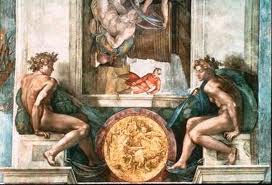
Fig.Sistine Ignudi
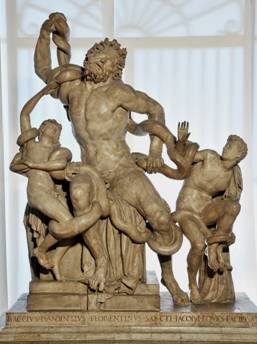 Fig.Laoccoon,Bandinelli |
In Rome, however, that diversity, in so far as it involved the kind of macabre imagery seen in the Disputation composed in 1517 and engraved in 1518, assumed a physical actuality and emotional force very different from what appears in the Florentine work. Absurd as is the horrid single figure of Fury himself, with a snake curled around his raised left arm, he undoubtedly shows a response to Michelangelo’s ignudi and to the antique Laocoön as restored in Bandinelli’s copy9. Fury’s extended arm and wide spread thighs and missing penis also bring to mind the Apollo Belvedere and the Torso Belvedere. Rosso’s use of these revered works to create the figure of Fury is a response to the ideals of these ancient sculptures. This reaction may be similar to the attack that Rosso made on the ideals of Sangallo’s architecture that led to the painter’s loss of the Cesi Chapel commission for frescoes and an altarpiece. Against a dense dark woods that may be derived from the forest of Eden in Dürer’s Adam and Eve but is instead a gnarled and desiccated version of it, with several tree stumps, suggesting the cut-off single tree trunk in the Apollo Belvedere that supports the statue’s restored right arm and hand, as pointed out to me by Robert D. Brown, Professor of Greek and Roman Studies at Vassar College. Professor Brown also noted that “One of the circles in Dante’s Inferno (that of suicides) features a barren wood” (“mesta selva” in Canto 13, 100, 7 Circle, Middle Ring).
Rosso’s wild figure, seated on the back of a monster and bracing himself with his right hand on one of a pair of large tree stumps, springs forth holding a skull either without a lower jaw or with a jaw that has fallen down and, in either case, having some correspondence to the missing lower jaw of the deceased in the Disputation of 1517. The setting of the Fury shows at least six snakes that arise out of the branches of the bare trees, their source very likely the snakes that appear on, not coming out of, the tree stump of the Apollo Belvedere where they could refer to the civilizing act of destroying the serpent Python at Delphi. Rosso’s many more snakes would instead show the triumph of monstrous forces over humanity, as suggested to me by Professor Brown. It is the largest snake that wraps itself around Fury’s raised arm that brings to mind the Laocoön with its raised right arm as restored by Bandinelli and in his copy commissioned in 1520. An enormous swan or goose stands on the two stumps of a single tree, cocks its head with its beaks slightly parted, and possibly sings, as Vasari says he does. The multiple sources of this bird will be considered below. The horrendous screaming dragon, Vasari’s serpent upon which Fury sits, seems to have no precedent in Roman art. In Florentine art the figure of Fury, Vasari’s notomia secca, has precedents only in Rosso’s own emaciated figures.
The fantastic Stregozzo engraved by Agostino Veneziano or by Marcantonio,10 if earlier than Rosso’s image, could possibly have given some impetus to Rosso’s invention. But in its long curves the elegant Stregozzo does not approach the gnarled horror of the Fury. As Rosso transmutes the heroic persuasive rhetorical forms of Michelanglo’s nudes and the tragic pathos of the Laocoön into a wrathful frenzy, the Fury is an artistic achievement that is not unlike that of the Disputation of the Angel of Death and the Devil and its relation to Leonardo’s Adoration of the Magi. But in Rosso’s work of 1517 there is a degree of sympathetic relationships surviving from Leonardo’s Adoration that is, in the Fury, replaced by a feeling related instead to that of Rosso’s cruel Virtù Vanquishing Fortune. Related as the emotion of the Fury may be to that in Michelangelo’s art and in the drama of the Laocoön, Rosso’s image is without any sensuous appeal that might lead us to identify with it or experience it as tragic. The Fury is totally negative in its effect; even the swan, or goose, appears repellent. It is possible to go so far to sense that the image even suggests revenge toward the sources it evokes.
Vasari wrote simply that the print represents “una figura di notomia secca, che ha una testa di morte in mano e siede sopra un serpente, mentre un cigno canta.”11 Although precisely executed its symbolism is not obvious. Unlike all of the other prints engraved in Rome after Rosso’s drawings, this, apparently the first, is not explicitly of an antique subject, nor does it appear obviously dependent on the environment of Rome for its theme. As, according to Vasari, some of Rosso’s drawings had, even before his arrival, established a reputation for him in Rome, he would also most likely have been known from his Disputation that Agostino Veneziano engraved in 1518 and that was sufficiently successful to be copied by Marco Dente in Rome from a new disegno di stampa made from Rosso’s drawing. It and the Fury exhibit a similar bizarreness and both are equally removed from what might be assumed was the norm of artistic expectations at the times they were created, although the earlier print prepared the way for the latter.
The current title of the print, the Fury, seems to go back no further than Bartsch, although Heinecken, while calling it The Chimera added: “c’est un homme furieux.” An untitled poem that appears under excellent early impressions seems to be based upon the print, and more or less describes rather than explains the image. It mentions the bird as a singing swan, however much it does not specifically resemble one, and refers to Vasari’s serpent as a dragon. The poem is written as spoken by the emaciated figure that is not identified. All the references are vile. The desiccated figure resembles some of those in the engraved Disputation but is more horrendous, resembling a flayed figure.12 He does not have a penis but his scrotum is intact, recalling the similar loss of many ancient statues.13 The monster on which he is seated may have one huge breast, although Professor Brown sees it as “a long (perversely placed) penis, symbolizing lewdness and lust” and as “a comical comment on Apollo’s missing one,” referring to the Apollo Belvedere. To which can also be added Fury’s missing penis. As in the earlier allegory and as mentioned above the skull in the Roman print does not appear to have a lower jaw, although the jaw that seems to have a few teeth may just be hanging loosely from skull. Nevertheless, the silenced skull offers a contrast to Fury whose mouth is open and perhaps screams a demonic howl. The “doglike” monster may also be howling but its wide-open mouth suggests instead that the he wants to devour whoever or whatever approaches, like Cerberus and his “allusion to hell.” Last, “the gaunt, contorted physique and demonic look of Rosso’s man,” in Professor Brown’s words, “contrasts with [Belvedere] Apollo’s serenity and physical perfection.” Such is the aspect of the entire image, of the total transformation of what was once an ideal and benevolent place into one of horror and pain. Only a small leaf, of acanthus perhaps, in the lower left corner shows a detail of the life and growth of a former time and that survives to reclaim again the place it once abundantly filled.14
In the context of Roman art around 1524 the Fury appears an imported product, like the Stregozzo, mentioned above, and yet no other artistic context is especially related to Rosso’s print. Vasari said that the success of the Fury resulted in Caraglio engraving other designs by Rosso,15 yet none of Rosso’s other Roman drawings for prints resembles it. As a demonstration of Rosso’s talents the bizzare extravagance of the Fury seems yet another example of Rosso’s opinione contraria, in this case accepted by il Baviera and apparently by others as the result of the success of the Disputation of the Angel of Death and the Devil engraved by Agostino Veneziano. In Rome, however, that position recognized in the Fury was also held in relation to quite other artistic works and issues than was the case in Florence with respect to Agostino Veneziano’s engraving.
While the Fury does not seem at first to evoke antique literary sources, the large bird in it may. As a swan it is the bird that was sacred to Apollo, but confused with a goose it could be connected to one of Aesop’s fables: The Swan mistaken for a Goose. Caught by mistake for the dinner table instead of the goose with which it was kept in a pen the frightened swan began to sing, from which arose the belief that the dying swan sang its final lament to save its life by its song that distinguished it from the goose. It may be that displacement of one detail for another plays a role elsewhere in this scene as in the substitution of the single penis-shaped breast or penis for the much smaller sex organ missing from the central figure. Both of these displacements of one aspect of the story or visual detail for another probably pervades the entire image if one could grasp the basic intent behind them. In Florence ancient sources would only seem to have been useful for Rosso’s knowledge of the details of the statue of Fortuna at Praeneste. Professor Brown wrote to me of the transformations in the Fury: “I see no allusion to classical myth, though the combination of incompatible life forms reminds one vaguely of the world of Ovid’s Metamorphoses and the Gorgon Medusa” (Ovid, Metamorphoses, Book IV, 753–803), here recalled by the snake-like hair of the frightening Fury. Most of the transformations have their sources in the visual works of art alone, although some bring with them associations with ancient texts as well. In Rome Rosso could easily have heard these texts discussed by artists who had used them as required sources for their commissions from highly literate men.
In the end what is most unlikely is what is most probable, that all the associations within the Fury turn toward the identity of the central figure and the large bird with which the emaciated and emasculated ignudo is most identified. The bird had been a swan until in the mind of our artist it was forced by the generation of all those modern false Apollos to sing as a goose a last song at what should be seen as the final disintegration of that ancient god. It is probable, then, that the central figure is Apollo as deformed into a monster along with his swan transformed into a goose by the artist’s contempt for the use that has been made by modern artists in Rome—in Christian Rome—of the gods and goddesses of antiquity.
The Fury has its vital counterpart in Rosso’s Nude with a Standard (Fig.D.12), a red chalk drawing in the Uffizi, and again of a furious figure. His anatomy is so evident through his skin that the drawing seems almost an ecorché. And further, like the Fury, he seems demonic. It is possible to imagine the Nude with a Standard as having a place in the evolution of Rosso’s thinking about the scene that the Fury became. In its tight graphic precision the drawing is probably not unlike the lost disegno di stampa of that engraving. So explicit is the draftsmanship of the anatomy of this slender but tightly muscular nude that it seems not simply described but bound by its draftsmanship. If the subject of the drawing is representative of Rosso’s temperament, the handling of it is no less a demonstration of his intensely focused artistic skill, further proof of the “gran pulitezza” by which Vasari described his draftsmanship. While the model here is very different from the one used for the figure of St. Sebastian of the Dei Altarpiece the handling of the two drawings is almost identical in suggesting the chiseled surface of a marble statue.
Now, his brilliant technique of Florentine origin, his temperament, and his own particular imagination were to challenge important aspects of contemporary Roman art. The Fury may well be the major record of one aspect of the state of mind that existed among Roman artists caught in something of an impasse after the death of Raphael and the absence of Michelangelo who had returned to Florence. Now Rosso decried in a print, as a kind of parody, his anger toward the great examples of sculpture in the Vatican collection, suggesting that they were no longer the models for great artistic achievement. What this anger and the print achieved has still to be recovered by scholarly investigation. But while the Fury seems to have been made following upon the success of Rosso’s brilliant and macabre Disputation engraved in 1518 by Agostino Veneziano there were no more prints of this bitter and violent kind designed for il Baviera.
As already noted the primary evidence of Rosso’s early temperament in relation to the works of others is Vasari’s comment on Rosso’s “opinione contraria,” that already appeared in the 1550 edition of the Lives. It is further supported by other records in Florence and by the stylistic characteristics of Rosso’s Florentine works themselves. In Rome a continuing discontent is indicated not by anything more that Vasari had to say but by the remarks of Cellini and by what is indicated in the only surviving personal and autograph record by Rosso himself. These can be correlated to what else we know of his activity in Rome and, with some caution, to the very appearance of his art. There is, of course, much that we do not know. But it may be worthwhile in our attempt to understand Rosso’s art more fully to see what the surviving facts suggest. For it is possible that what we recognize as temperamental behavior has also some basis in historical circumstances. We know that Rosso’s work on the Cesi Chapel was commissioned in the name of mess. Agniolo da Ciessi by the architect of the chapel, Antonio da Sangallo the Younger, and that originally it was to include, in addition to the two frescoes that were executed, other frescoes, stuccoes it would seem, and an altarpiece on panel, as determined by Sangallo. Cellini, who had celebrated the Feast of St. John the Baptist (24 June), the patron saint of Florence, with Rosso in Rome, then went out to where Rosso was staying in Cerveteri at a castle owned by the count of Anguillara to escape the plague later in June, and later writing of his first journey to France reported that Rosso slandered Sangallo and that as a result a commission given to Rosso by Angelo Cesi was taken away. This must refer to the Cesi Chapel. Cellini went on to say that Antonio began to persecute Rosso and brought him near to starvation.
“Again, the evil things said by Rosso against San Gallo, that excellent architect, caused the latter to get work taken from him which he had previously procured for him from Messer Agnolo da Cesi; and after this San Gallo used his influence so strenuously against him that he must have been brought to the verge of starvation, had not I pitied his condition and lent him some scores of crowns to live upon.”16
It is possible that Vasari’s later evaluation of Rosso’s frescoes reflects remarks that were originally made by Sangallo. On 6 October 1526, Rosso wrote a long letter to Michelangelo defending himself against the rumor brought out in the sentence: …I understand that you have been told that when I arrived here (in Rome) and entered the chapel you painted, I am supposed to have said that I would not adopt that maniera (of painting) (DOC. 9)
Rosso’s defense of his admiration for Michelangelo in this letter is remarkable for its length and repetitions, but there is no reason to doubt that it is honest in its intentions in spite of the sense of fear in it of losing Michelangelo’s good will and yet fearlessness, too, in setting out to write this defense in the first place. He may also have felt that he could not afford to lose the respect and friendship of Michelangelo whose opinion would also be professionally valuable. Nevertheless, it is equally likely that upon arriving in Rome Rosso had made vituperative statements about the frescoes of the Sistine Ceiling as he moved to define his own artistic position in the midst of the Roman artistic scene that still contained its Michelangelo faction with the presence particularly of Sebastiano del Piombo. Rosso’s actual position, however, as indicated by the frescoes of the Cesi Chapel, was to enlarge upon Michelangelo’s art in what Rosso saw as its most impressive term, the massiveness of its grand ignudi. But had he also seen the eroticism of aspects of Michelangelo’s maniera that he, from his early clerical education at the Annunziata, wished to limit in his nude figures in the Cesi Chapel?
It was not only Michelangelo’s art that came under verbal attack. Cellini also reported from France of Rosso that “per la sua mala lingua essendo in Roma, gli aveva detta tanto male de l’opere di Raffaello da Urbino, che i discepoli suoi lo volevanno ammazzare a ogni modo.”
After taking some repose in Paris, I went to visit the painter Rosso, who was in the King’s service. I thought to find in him one of the sincerest friends I had in the world, seeing that in Rome I had done him the greatest benefits which one man can confer upon another. As these may be described briefly, I will not here omit their mention, in order to expose the shamelessness of such ingratitude. While he was in Rome, then, being a man given to back-biting, he spoke so ill of Raffaello da Urbino’s works, that the pupils of the latter were quite resolved to murder him. From this peril I saved him by keeping a close watch upon him day and night.17
There was little else of real significance that Rosso could have attacked in Rome in the mid-1520s, except the antique, and this is railed at in the Fury with its references to the Laocoön, the Torso Belevdere, and the Apollo Belvedere. The standards set by the works of Michelangelo and Raphael, and by the remains of antiquity, were the foci of contemporary art in Rome. That Rosso should adhere to any one of them when such behavior had never been his before would have been stranger, indeed, than his own kind of very personal response to the art of Rome. All of it, so it seems, was subject to his outspoken criticism; he would, outsider that he was, have himself known as having different opinions about art. Nevertheless, this position, though possibly temperamental in its origins, was bound to the historical facts presented by the works of Michelangelo, Raphael, and antiquity in Rome and by the impasse to independent expression that they and the partisans of the art of Michelangelo and Raphael created. It was through his passionate criticism, however, that Rosso came to understand the possibilities of the art that he found in Rome and to use them freely as his feelings and intelligence prompted him. But his attitudes, in spite of what Cellini wrote, were not throughout antagonistic as Rosso’s letter to Michelangelo and the frescoes of the Cesi Chapel indicate. It is probably not an exaggeration to say that Rosso understood better than any other artist in Rome the range of artistic modes practiced there. It seems also true, as his other Roman works show, that while he could be sympathetic to these modes he could be so without any inclination toward reverence. While there is something egotistical in this position, there is also something brave. From it would arise his various Roman manners and eventually, in the next decade, that even more extensive multifaceted artistic behavior that would be his in the service of the king of France.
The complexity of Rosso’s relation to the art in Rome and the clarity of his understanding of his own position with regard to it and to his Florentine background are visible in three drawings of the life of St. Roch made very possibly for Carlo Virginio Orsini, the Count of Anguillara. This was in the summer of 1524 at Cerveteri, one of the count’s castles to which Rosso was invited to escape an occurrence of the plague in Rome. The first in the series, from the Lebel Collection and now in the Louvre, representing, in red chalk, St. Roch distributing His Inheritance to the Poor (Fig.D.13) is remarkably diverse in its references without, however, looking like a pastiche. It bears the arms of the Virginio branch of the Orsini and the Count of Anguillara, Gentil Virginio Orsini.18
Composed of three scenes within an architectural setting with the major figure in the center foreground and two minor episodes set farther back the composition recalls the Hanging of Haman by Michelangelo. Although the figure of St. Roch, especially his head, seems to refer to Michelangelo’s early ignudi, the saint’s deliberately complicated crossed arms gesture looks like a derivation from the ingeniously complex posture of Michelangelo’s Haman.19
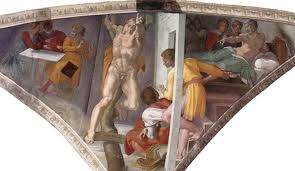 Fig.Sistine, Haman |
 Fig.Sistine Ignudi |
But the measured divisions of Rosso’s composition suggests the tapestries designed by Raphael, in particular the Sacrifice at Lystra with its architectural background. Rosso’s drawing with its infirm figures also brings to mind another tapestry designed by Raphael, Healing of the Lame Man.
Yet clear as these relationships to the works of Michelangelo and Raphael may be, they do not seem quite to indicate all that lies behind the invention of this drawing. There is also a degree of fantasy evident in the intimacy of glances and gestures in the scene that does not appear to be what might generally be thought of as Roman in origin. At the upper right a street of houses, similar to that in the Florentine Moses killing the Egyptian and defending the Daughters of Jethro, looks strangely provincial in this Roman drawing. The not wholly logical relationships of the figures to the architecture, the use of a large flight of stairs, and the appearance of the deathbed scene in an upper corner recall Pontormo’s Joseph in Egypt painted in Florence about a half a decade earlier. In the second drawing, a copy representing St. Roch visiting the Plague-Stricken, the figure bending over and seen from behind is specifically derived from Pontormo’s Joseph sold to Potiphar.
Furthermore, the view of the street at the upper right of the Lebel drawing and the lame man at the lower left may indicate that Rosso had in mind Masaccio’s frescoes in the Brancacci Chapel, especially the St. Peter healing the Sick with his Shadow and the St. Peter distributing Alms. The way in which the spaces are arranged makes one think of fifteenth-century Florentine paintings and reliefs in general. In the third drawing, also a copy, showing the Angel of God appearing to St. Roch, the same kind of relationships appear, with grand and clear Roman forms set beside Florentine details of narrative and descriptive intimacy.
Done probably after the Cesi Chapel frescoes were conceived, if not wholly executed, the St. Roch drawings suggest the degree of comfortable adjustment that Rosso made to the Roman scene within months of his arrival in Rome. There is in these drawings none of that aggrandizement of intentions that so appears to suffocate the frescoes of 1524, nor any of the hysteria that seems as much a characteristic of the style as of the subject of the Fury. The flaunting of Rosso’s talents does not impress us as an issue in the St. Roch drawings though these talents are superbly exhibited here. It might also be thought paradoxical that Roman grandness could co-exist so easily with Florentine charm, or that the diversity of quattrocento narration and the extravagance of Pontormo’s fantasy could be accommodated so well to the fullness of Michelangelesque form and the order of Raphaelesque composition. But the style of these drawings is not that of a paradox. Their style is a straightforward, intelligent, and sensitive adjustment of several artistic possibilities into a pictorial mode that appears to be quite literally the sum of its parts. Given the quality of the art upon which Rosso drew it would be misleading to characterize Rosso’s own art in these drawings as “inspired”. What we experience instead is a most accomplished artistic cleverness that distinguishes the St. Roch scenes from the Cesi Chapel frescoes and from the Fury, both of which appear passionately determined by the sources they exploit. Already in 1522, in the Dei Altarpiece, Rosso gave evidence of knowing how to construct a work of art in terms that were not ostensibly his but which he could interpret, as it were, into his mode of feeling and expression. In Rome, as we shall see, the terms of his art were enlarged and he learned surer and more various ways of composing them that would not be so precariously dependent upon his inspiration. This does not necessarily mean that none of his art would any longer be deeply felt, but intuitive inspiration would not now always be essential to its creation. Beginning in Rome it seems often that he invented with his wit rather than his genius and created works that were an elaboration to a large extent upon the inspiration of others. Just before coming to Rome he had shown in the Moses and the Eliezer his ability to create with extraordinary freedom works of art in this manner. In Rome, after his initial works, he continued to use his imagination in this same way, but the handling of his material was more conscious of the circumstances of his new artistic ambiance and more deliberately calculating in the reflection and concealment of them.
From the latter part of 1524, when the commission of the frescoes in S. Maria della Pace was taken from him, until his departure from Rome after the Sack of 1527, Rosso’s activity was largely devoted to the execution of thirty disegni di stampe that were engraved by Caraglio. Only two paintings, the Dead Christ attended by Four Angels in Boston and a lost “bozza” of a Beheading of St. John the Baptist, are recorded as having been executed in these years. The subjects of the prints he designed constitute a new kind of artistic activity for Rosso. Prior to his arrival in Rome only the Virtù vanquishing Fortune has a non-Christian subject and the large Disputation drawing of 1517 seems also to be (largely) independent of Christian thought if not of sentiment. However, both compositions are not obviously pagan in their sentiments. The Roman Fury seems to belong to the same class of invention as the latter, not specifically Christian and yet having again feelings of Christian pathos. All the other thirty Roman prints show instead a fantastical and wry imagination sporting with ancient subjects and texts. These prints are so clever in their evocation of the myths and history of antiquity that they present that one is inclined to suppose that they are filled with quotations from ancient art, or with figures that show at least their derivation from it. This is not, however, the case, indicating that Rosso took seriously the charge of his Fury.
Certain of these prints also seem to suggest derivations from the work of the 1520s by Giulio, Perino, and Polidoro. Here, obviously, is where Rosso’s competition lay. But again, if direct borrowings or even close parallels are sought the search for them remains inconclusive. For Rosso’s powers of assimilation are so extraordinary and his powers of invention so multiple and brilliant that the evidence of his sources in Rome is in most cases obliterated. Furthermore, in spite of their Roman character the prints carry with them qualities of Florentine wit and eccentricity that free them from the severe canons of even the least formal contemporary Roman art. For this reason, and in spite of their Roman expression, these prints stand apart from contemporary Roman art in much the same way that Parmigianino’s Roman art, enlarged though it was by his experiences in Rome, would maintain its foreign stylistic independence.
While the St. Roch drawings show us the extent to which Rosso had quickly assimilated the tenets of Renaissance Roman art, the six Labors and Adventures of Hercules (E.19–24), designed probably shortly thereafter in the second half of 1524, are not such formal examples of his abilities of accommodation. Each of the Labors has something of the aspect of an artistic jeu d’esprit, invented without the slightest sign of artistic pedantry. Unlike the Cesi Chapel frescoes these six prints do not appear as demonstrations of a talent with Michelangelesque ambitions, nor have they that cast of Raphaelesque order of the St. Roch drawings. The richness of their invention is more like that of the Fury but without its welter of small forms, niggling detail, and bizarreness. The broader details and the brilliant contrasts of light and dark are so rich and varied that the prints, though black and white, have a pictorial opulence that takes one also back to the Marriage of the Virgin. Furthermore, the figures and compositions of the six prints are very much related to those of the last two paintings that Rosso executed in Florence, the Moses and the Eliezer. However, the total impression of decisive form that each of the Labors and Adventures of Hercules makes is one that belongs to the artistic ambiance of Rome. The two late Florentine pictures appear, by comparison, abstract and stylistically arch. However, it is the daring of those private paintings that underlies the easy exuberance of the Hercules compositions made for publications as prints in Rome.
Issued probably late in 1524 these compositions should, in what reveals them as Roman, be comparable to what were the most current stylistic modes of Polidoro and Perino, the latter having himself only shortly before come from Florence, and of Giulio Romano, though he would have departed for Mantua just about the time that these prints were made. The hard forms of Rosso’s male figures in these prints, and the thick-set proportions of some of them that are generally unlike those of his Florentine figures, seem to point to his study of the works of Perino and Polidoro. There is also an energy and swiftness of movement of Rosso’s figures that are characteristic of theirs too. But it is difficult to specify the relationships of their art. The bluntness of the forms of some of Rosso’s figures and their abrupt movements suggest Polidoro more than Perino, although it is not possible to demonstrate that these characteristics are dependent on Rosso’s particular study of Polidoro’s art.20 At the same time these characteristics, especially the abrupt movements, can already be found to some extent in Rosso’s late Florentine pictures though without the emphatic plasticity of the Labors and Adventures of Hercules. The Roman vocabulary of Perino’s Martyrdom of the Ten-Thousand may have been known to Rosso in Florence though it does not seem seriously to have touched his art there. In Rome, however, this vocabulary of forms could have been recognized as useful by Rosso and it might be supposed that something of the swift movement of these forms would also have been adopted by him, from Perino’s cartoon or from Perino’s most recent work in Rome.21 Yet the movement of the figures in the Hercules prints does not resemble that of Perino’s figures much at all. For the Raphaelesque grace of Perino’s swift-moving figures seems to have been incompatible with Rosso’s own conception of movement going all the way back to the tumbling angels in the Assumption at the Annunziata and to the picture at Tours. In the Moses and the Eliezer, as in the Deposition at Volterra, forms never turn in space with a continuous grace; there is always a quick, unexpected change in direction that distinguished these pictures from those of Classic art. Or from the art, like Perino’s and Polidoro’s, that had come extensively from it, as Rosso’s, by willful resistance to it, had not. What, then, remains specifically Roman about the Hercules prints is the firm plasticity of their figures, and a much more masterful manipulation of the human body than appears in any of his earlier work. There is also a quality of invention that is remarkably richer and freer, but also more disciplined than ever before even as it still very much resembles that of the Marriage of the Virgin and the Moses and Eliezer. Where, however, the working of Rosso’s imagination in the Hercules prints differs from that in the two preceding Florentine paintings is in its release from the kind of earnestness that characterizes their style. In those paintings style was a kind of severe imposition on the subject of the pictures, disjoining it from the sensuous effects of figures and things that are generally presented by Renaissance painting. At the same time the subject was allowed to exist aside from the realm of deep feeling. From this position of apparent objectivity the fancifulness and wit of the Hercules prints seem to have arisen. The inventions of these compositions are serious, and delightful, suggesting that they were made for an audience that Rosso knew would appreciate their sophisticated entertainment.
The Labors and Adventures of Hercules—the initial set of prints designed by Rosso in Rome of which only the Hercules fighting Cerberus and the Hercules killing the Hydra are among the traditional twelve Labors of Hercules—are also the first works by Rosso for which he had to give his attention to ancient myths. The textual sources for these six episodes are varied and it has not been possible to determine which are the ones that served Rosso’s depictions. The stories of the Hercules overpowering the River Achelous and the narratively related Hercules shooting Nessus are told sequentially in Chapter IX of Ovid’s Metamorphoses. The story of Hercules fighting Cacus occurs in Virgil’s Aeneid, Book VIII, 184–305; the sources of the stories of the other prints and their details could have come from a variety of other texts, including Hyginus’ Fabulae and Poetica Astronomica, and the Library of Apollodorus.22 But the prints do not follow any single text or any group of texts, although the engravings are faithful to the details of these various texts and would thus have satisfied the sophisticated audience who knew them and for whom the engravings were largely intended. Rosso may have been able to recognize some parts of the Latin texts but not to the extent that would have been necessary to read them as would a humanist scholar. There is no evidence that he knew any Greek. He probably studied Latin as a boy and we know from Vasari that he studied Latin seriously in preparation for his career in France. He could have read some of these myths in Italian translations or other versions of them and seen them used elsewhere by artists in Rome. Friends who were accomplished Latinists could have assisted him. Little if any of the compositions of the Hercules scenes and their details come from the densely packed visual material of the many Roman sarcophagi showing the Labors of Hercules, such as the sarcophagus of around 240–250 in the Palazzo Altemps in Rome (Fig.Hercules Sarcophagus).
Brief texts may have been intended for the margins beneath the scenes, four of which have what look like holes for pairs of pegs at each end to suggest the use of attached metal plaques, also suggesting that the scenes above are reliefs. The other two prints have narrower margins indicating perhaps the use of titles alone or one-line texts. Rosso may rather have simply wanted a little more space for his scene. The engravings are not mere illustrations filled with details to impress by the erudition they display. Rather they vie with the literature of the myths they recall as poetic statements on their own. This is different from the inventive but more prosaic St. Roch scenes derived from the Golden Legend. As the twelve canonical Labors of Hercules were not intended as the sole subjects of these prints the series was probably originally intended to be made up of just these six histories.23 They were possibly selected from the variety of labors and other adventures of Hercules by Rosso himself from what he had been told of them and seen depicted by other artists, ancient and modern, the ancient examples seen most often on sarcophagi of the Labors. Modern prints seem to have been of individual episodes of Hercules’ endeavors. The selection of these six scenes must have been made according to what Rosso thought would result in the most interesting set of prints. The figure of Hercules in the scene of his combat with Cacus who is attempting to steal one of the Geryon’s cattle is, with only a slight variation in the turn of his body, related to the central figure of Moses in the Florentine picture of 1523–1524.
In both scenes the penis of the central figure swings to the right in response to his forward movement to the left. Hercules swings his club with his right hand indicating that the scene is not reversed. It is not quite possible to know the precise spatial situation of either figure, even less so of Hercules, whose legs and feet are hidden by the bull. But in the print this is not much noticed, so occupied are we by the physical action of the narrative, by the visual cleverness of the scene, and by the clarity of the engraving. Only in this scene does Hercules not wear his lion skin, while Cacus wears the peaked cap that denotes him as the son of Vulcan, mentioned by Virgil.24 Cacus and the bull are set in the immediate foreground, one foot of each actually placed upon and overlapping the lower edge of the picture area, an illusionistic device already found in Rosso’s much earlier Assumption at SS. Annunziata.25 The woeful animal, placed low in the foreground and parallel to the picture plane, is seen in contrast to two foreshortened cattle at the top of the engraving and in the distance, one of which is viewed from the front with its head lowered, the other from behind with its head raised. The depiction of Cacus pulling the lowing bull backwards by his tail, to cover up the trail to Cacus’ lair, as narrated by Virgil, creates a wry scene, especially as our sympathies, although not Virgil’s, seem so much to lie with the perplexed bull. From the print alone it would seem that Cacus is being punished for the ill treatment of the animal. A similar humor is found in the scene of Hercules overpowering the River Achelous in the form of a bull for the hand of Dejaniera (Fig.E.23).
The forward lunging figure of Hercules is complexly balanced over the body of the bull that he has just brought down; he is about to break off the penis-shaped left horn—unlike the normal appearance of the right one—which was taken by the Naiads, who, according to Ovid, filled it with fruits and flowers to create the cornucopia or Horn of Plenty that appears in the background much elongated and elegantly curved. Hercules’ pose recalls some of Raphael’s late figures, such as the old man in the left foreground of the Transfiguration. But the lightness of the movement of Rosso’s figure does not intend the depth of feeling of Raphael’s figure as the witty placement of the extended and open left hand of Rosso’s figure also indicates. It falls in our field of vision just in front of the long thigh of one of the women in the background, the hand looking as though it were just about to grab the thigh. But details, such as the live and broken reeds in the Achelous scene, give evidence of the extent of Rosso’s attention to the particulars of the Hercules stories as told by Ovid. But such Ovidian details are matched by the artist’s visual spatial distractions as with the foreground bull in profile that appears with the two foreshortened bulls high up in the background of the Hercules fighting Cacus (Fig.E.24).
The figures in the Hercules fighting the Centaurs [Fig.E.22] are derived fairly directly from the Moses Killing the Egyptian and Defending the Daughters of Jethro, including the appearance of the bald-headed centaur who has fallen on his back. There may also be a recollection here of Leonardo’s Battle of the Standard (Fig.Rubens, after Leonardo, Battle). Nothing of the abstraction of Rosso’s earlier Moses painting halts, however, the narrative exuberance of the Hercules engraving, but neither does its style create anything of the appearance of the deeply generated meaning of Leonardo’s Battle. The effect of this and the other prints of this series is one of brilliant narration, and of depiction that is explicit, dramatic, and inventive. In the Hercules Fighting Cerberus (Fig.E.19) the hero is seen standing above a fallen male nude, perhaps Menoetes, the herdsman of Hades’ cattle, whom, according to Apollodorus, Hercules defeated before he subdued Cerberus.26 His body is depicted strongly foreshortened in opposition to the full view of Hercules’ body. This juxtaposition recalls Quattrocento painting or that vein of quattrocentesque description and narration that survived in the art of Peruzzi in Rome, not only in the Ovidian scenes in the Sala del Fregio in the Farnesina [Fig.Peruzzi, Centaurs] but also in the Old and New Testament narratives in the Cappella Ponzetti in S. Maria della Pace (Fig.Peruzzi,Ponzetti). As in all the Hercules prints, the light comes sharply from the left, but here in the scene with Cerberus there is also a blast of light from the fire at the entrance to Hades near the walls of Tartarus that suggest Roman buildings.
The figures of Hercules and Iolaus in the engraving showing the fight with the Hydra [Fig.E.21] are almost exact counterparts in a manner that recalls the opposite views of the same posture employed by Antonio Pollaiuolo in his engraved Battle of Nudes (Fig.Pollaiuolo,Battle,London). At the lower left of Rosso’s scene, the crab Cancer sent by Hera to aid the hydra, pinches Hercules’ left foot, while Iolaos sears the screaming hydra’s stumps with his huge torch. To amuse the viewer the end of the long tail of Hercules’ lion skin falls over the bottom edge of the picture into the area of the blank plaque. Peruzzi’s painting of Hercules killing the Hydra in the Loggia of Galatea in the Villa Farnesina [Fig.Peruzzi,Hydra] shows the handsome hero acting alone in a presentation of his prowess and his virtù. The crab is there as in Rosso’s depiction biting Hercules’ right foot but there is no dangling tail of a lion. Hercules is seen wholly from the front while Rosso’s figure appears entirely from the back.
Of the six Hercules’ prints the Hercules Shooting Nessus [Fig.E.20] is the most extraordinary in its variety of textures and values that affect the aesthetic delight of missing color. The scene is set against a dark and threatening sky and the decoratively churning and foaming waters of the river Evenus, personified by a reclining male nude with wet hair who holds a huge urn with a large scroll for a handle that visually connects the scene of Nessus escaping with Dejaniera and the figure of the hero at the lower right. His pose suggests some of the early ignudi of the Sistine Ceiling, laid on their sides; there may also be a reference here to the Discobolus, for instance, or the Belvedere torso, but if such a reference exists it is so imaginatively re-shaped as to lose all but a hint of the antique association. The burly Hercules walks onto the bank of the Evenus over the lower edge of the engraving as though he were entering another world of churning waters. He has just shot his invisible arrow, poisoned with the blood of the hydra, at Nessus who flees with Dejaniera and pulls his cloak over his wounded shoulder, the bloodied garment that he would give to Dejaniera and which would cause Hercules’ death.27 The clouds behind him are streaked with light; it is possible that night is represented and that the light everywhere is that of the moon. What is evoked here is not so much an experience of the figures in this story as a poetical insight into the fantastic quality of the myth itself. The apparent actuality of that myth is of course synonymous with Rosso’s artistic creation, the obvious brilliance of which suspends our belief in any other kind of actuality that might have been created.
In spite of the possibility that there may be references in these highly artificial scenes of Hercules’ exploits to the art of Michelangelo, Perino, and Polidoro, perhaps also of Leonardo, and to antique sculpture, there is reason to believe that some of the figures are also based on life studies. Rosso’s Standing Bearded Nude with a Fillet binding His Hair in the Uffizi (Fig.D.16), done in red chalk, was certainly drawn from a live model whose physical type became that of Hercules in a few of the prints. The drawing preserved very accurately, one imagines, the details of the model’s personal anatomy—the shape of his feet, for example—but Rosso has drawn the figure with such “gran pulitezza” that it appears as though it were chiseled by the draftsmanship that records it. The locks of hair have been shaped into patterns that recall the formulae used by sculptors. Nevertheless, the figure also appears intensely seen by the draughtsman, especially as the strong raking light makes so very clear the precise nature of its anatomy. The figure does not appear substantially re-formed by some compelling aesthetic ideal but instead as given an ornamental veneer created by the subtle stressing of the details of his actual appearance. It is this veneer that constitutes the fantasy of this realistic drawing and which, in the Hercules engravings, transforms the stuff of reality into the matter of myth. Lighthearted and witty as they are, these scenes show aspects of a visionary art, like that of Rosso’s Marriage of the Virgin, that is, however, still based, in part at least, as is the Uffizi Standing Bearded Nude, on the material of the visual world. The link with this world, that was tenuous in the Florentine Moses killing the Egyptian and defending the Daughters of Jethro, was restored in Rome, and in the process Rosso’s art achieved the ease of modern Roman art. But his art also acquired in the designs he made for Caraglio’s engravings a visual piquancy and wit that kept it apart from the more archaeological and worldly art of Perino and Polidoro. There is no evidence that these distinctions found a place in any larger works that Rosso did in Rome but seem to belong wholly to his graphic designs engraved by Caraglio and printed in black and white.
Returning to Peruzzi’s Hercules killing the Hydra (Fig.Peruzzi,Hydra) for comparison with Rosso’s representation of the same subject engraved by Caraglio (Fig.E.21), it is clear that Rosso’s reinvention of the hero of these myths is no longer connected to the allegory that made this hero since the early fifteen century the Exemplar Virtutis,28 and in Florence a symbol of the city already in the thirteenth century.29 Rosso’s scenes of the labors and adventures of Hercules are merely narrative in intent and while violent in the actions of their figures, if not in the expressions they show, there is little indicated of the strength of Hercules to imply a larger meaning for this hero. As prints they are not connected to any monument or setting as is Peruzzi’s figure, and without the inscriptions that may have been intended but never composed, no direction is given to focus the thought of the viewer upon the virtues that had been earlier and elsewhere assigned to Hercules’ labors. Furthermore, the set of six prints show only two of the labors, indicating that they were never intended to identify Hercules only with the virtues that had become identified with the labors. The stories as told by Rosso delight the viewer and that would seem to be their sole brilliant intent.
Stylistically consistent as the Hercules scenes are among themselves, it would be misleading to assume that they alone represent Rosso’s art in the second half of 1524. They may be contemporary with the St. Roch scenes and the style of the prints may therefore represent an alternative, rather than a preceding or subsequent manner, to that of the drawings perhaps intended for a series of frescoes in the Orsini castle at Cerveteri. Each of these series carries with it aspects of Rosso’s Florentine art and other Florentine sources that were at his disposal before he came to Rome. It has to be remembered how diverse these were in his Marriage of the Virgin and the almost contemporary but very different Moses painting in the Uffizi. This diversity was heightened in Rome as the result of the new sources upon which he could draw, largely modern rather than antique as might be expected given the cry of Fury in the first of the engravings by Caraglio made from Rosso’s designs.
Caraglio’s engraving of the Challenge of the Pierides is based on a disegno di stampa that Rosso very likely also made during the second half of 1524. The composition and individual figures are dependent on Raphael’s Parnassus, probably on the fresco itself (Fig.Raphael,Parnassus), but also, it seems, on the engraving by Marcantonio of an early design for it (Fig.Marcantonio,Parnassus).30 Rosso may also have known some of Raphael’s drawings for the Parnassus, such as that represented by the pen copy in the Ashmolean Museum (Fig.Ashmolean,Parker 639) where the Muses are shown nude and where the Muse at the far right seen from the back resembles one of Rosso’s Muses.31 These sources are no less explicit than those of Michelangelo’s art evident in Rosso’s Cesi Chapel frescoes, but Raphael’s art, even less here than seems to be the case with regard to the St. Roch drawings, is not assumed by Rosso to be the fundamental stylistic premise of the Challenge of the Pierides. For this scene, composed though it was in Rome, is still very much related to the Florentine Marriage of the Virgin.
The inscription in the margin beneath the scene refers to the story in Ovid’s Metamorphoses of what the Muses told Athena and that purports to be the subject of Rosso’s scene. (V, 294–334 and 662–678; line 299 containing the same last three words: “imitantes omnia picae”: After daring to contest the Muses with their singing they now fly as magpies, imitating the sound of all and sundry.)32 The nine daughters of Pierus, the king of Emathia, challenged the Muses for the prize of poetry at their new spring, Hippocrene, on Mount Helicon, that the hoof of the Medusa’s winged horse had produced. The contest was to be judged by the nymphs who took an oath by their streams. After dancing with a tambourine (and not playing the harp mentioned by Ovid) performed by the Pieride who proposed the contest and the singing and playing of the lyre by Calliope, the Muse chosen by her sisters and who “tried plaintive chords with her thumb,” the nymphs agreed that the Muses had won, to which the Pierides retorted by reviling them. For their insults the Muses turned them into magpies “imitantes omnia picae”. Rosso changed the story by placing the nude Apollo in the center of the upper group, apparently as judge facing toward the Pierides, and with a quiver at his back and his left hand propped up by his bow. The bare-breasted Minerva is at his side, wearing a helmet and holding a lance with its point broken off to suggest her role as goddess of the arts by reducing her other role as goddess of war still represented by the helmet she continues to wear and by her shield that she touches with her left hand. Bacchus, with vine leaves encircling his head, stands at the other side of Apollo, while Mercury, with winged hat and a wing visible on one of his feet, stands behind him. A satyr, possibly Pan, stands behind Bacchus, while another satyr appears behind Minerva; three other male nudes are without specific attributes. In front of this central group surrounding Apollo are six water gods, three men and three women, which can probably be related to the nymphs’ streams mentioned by Ovid.33
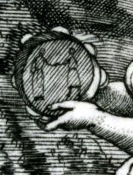 Mirimonde has shown that some of the musical instruments in the scene are interpreted from ancient sculpture.34 Furthermore he indicated that the instruments associated with the Muses in the engraving are noble and sacred, while the tambourine with jingles held by one of the Pierides, and not in Ovid’s story, is a symbol of lust and lewdness. Her bent knees would seem to indicate that she is dancing. Not mentioned by Mirimonde is the scene that is depicted on the drum surface of the tambourine showing two women, one wearing a long skirt, the other a short one, facing each other with outstretched arm and clasped hands.
Mirimonde has shown that some of the musical instruments in the scene are interpreted from ancient sculpture.34 Furthermore he indicated that the instruments associated with the Muses in the engraving are noble and sacred, while the tambourine with jingles held by one of the Pierides, and not in Ovid’s story, is a symbol of lust and lewdness. Her bent knees would seem to indicate that she is dancing. Not mentioned by Mirimonde is the scene that is depicted on the drum surface of the tambourine showing two women, one wearing a long skirt, the other a short one, facing each other with outstretched arm and clasped hands.
The bagpipe and goat horn, lying at the feet of the Pierides, were frequently used by satyrs. Hence the scene shows the confrontation of two kinds of music, as defined by ancient philosophers, the one that purifies the soul and elevates it to the highest spheres as opposed to the other that stimulates the instincts and degrades the higher faculties. This explains why, in the confrontation, the Muses are nude, symbolic of truth, revealed beauty, and, according to the Neoplatonists, the ideal, while the elaborate garments and headdresses of the Pierides denote foolish and fickle dissimulation. This must explain why Apollo, who presided over the Muses, is shown as judge gesturing with his right hand toward the Pierides, his left hand held tightly against his thigh. At his side stands Minerva, to whom, in Ovid, one of the Muses tells their story.35 Above the heads of the gods and in the trees to the left and right are several magpies, and a flock of birds and one large bird fly into the distance above the center of the scene.
The theme of Rosso’s print, adapted from its sources as in the Hercules series rather than adhering to them, would, as already noted, had to have led him in Rome to Raphael’s even more particularly conceived Parnassus with its assemblage of historically diverse figures and the nine Muses around the figure of Apollo. It is even possible that the subject of the print was selected to prompt a comparison with Raphael’s scene although the theme of the engraving also reflects other musical interests, bringing to mind Vasari’s remark the Rosso “era bonissimo musico, & haveva ottima termini de Filosphia.”36 In Rome these interests found a milieu for which the Pierides was invented. The general disposition of the figures on a wooded terrain of two levels around a central void goes back to the arrangement that Raphael invented because of the window around which he had to compose his picture, an actual “inconvenience” that Rosso did not face. But we are reminded more of Marcantonio’s print than of the fresco itself because of the greater separation of the groups of figures in the Challenge of the Pierides. Even here, however, Rosso chose to ignore those devices, such as the positioning of the trees and the postures and gestures of the figures, which give continuity to Raphael’s design. The continuity of the Pierides scene is achieved quite differently, suggesting almost that Rosso was reading Raphael’s composition in Marcantonio’s print back to an earlier stage in the evolution of the former’s style. What, instead, Rosso seems to have done is see Raphael’s early design for the Parnassus in terms of what the S. Lorenzo Sposalizio prescribed. All the figures in the engraving are seen against a rising dark landscape, the dark edges of which fall in the center behind the figure of Apollo, just above the stream below that separates the Muses from the Pierides. The figures are arranged in registers, the center group above and behind the others, the arrangement tending to isolate one group from the other. The two more rectangular lower groups are contrasted to the upper oval one with Apollo at its center. The arrangement of this group of figures may be more dependent upon Raphael’s Parnassus and Marcantonio’s engraving. But even here Rosso has turned the figures largely inward so that they form a self-contained group with only minimal extensions beyond its limits. Nevertheless, our attention moves continuously across the entire scene not, however, through the disposition of its forms but with the fall of light from the left and the constant flutter of light and shade that creates irregular patterns of chiaroscuro throughout the composition. As with the Marriage of the Virgin, the visual impression of the Challenge of the Pierides is luminary, though also plastic, and presentational in its effect rather than dramatic, except the landscape with its gnarled and bending forms. Calliope and the Pieride who proposed the contest have come to the center of the scene to perform, indicating the staged concert that is the principle event of the contest. At the moment chosen to depict Calliope is singing and playing the lyre and the Pieride is dancing and holding up her tambourine to show the scene that is depicted on its drum surface.
It is this detail along with the introduction of Apollo as judge and his entourage replacing the nymphs of Ovid’s story that Rosso’s representation of this event is also significantly at odds with the Ovidian caption beneath it. For here Apollo as well as Minerva appear by their gestures to favor the Pierides. The picture on the tambourine almost in the very center of the engraving would appear to be a scene of conciliation as also effected by Apollo and Minerva who by their judgment establish an equality between the Muses and their music that purified the soul and the Pierides and their music of the instincts.
It may be that Apollo’s less than emphatic gesture may be meant to indicate not a judgment of victory for the Pierides but a degree of invitation to join the Muses in this conciliation. Here Rosso may suggest a Christian involvement in Apollo’s choice when acknowledging the losers as worthy of the privileges of the god who presides over the Muses. Minerva, as goddess of the arts and the inventor of the pipes that the Pierides played, stands closest to Apollo to share in the fairness of his opinion.
The ancient subject of this print is, alone, almost enough evidence to indicate for Rosso its Roman origins; its subject was also sufficient stimulus for the enlargement of the possibilities of Rosso’s art. Related as the Challenge of the Pierides is to the Sposalizio of 1523, the style of the later work is very much determined by its depiction of male and female nudes in a scene of Roman mythology. The figures are more massive than any in Rosso’s Florentine works and their corporeal integrity is not reduced by the frequent abstraction from of his earlier art. Furthermore, the engraved scene clarifies the faceted complexities of the style of the Marriage of the Virgin and opens up for the viewer its composition spatially on the basis of the example of Raphael’s early Parnassus designs. The number of figures controlled by this new, larger, and more compositional order may not exceed that of the Sposalizio or of the Disputation of the Angel of Death and the Devil, but in their entirety the later Roman figures are used to greater advantage, again, it appears, in a Raphaelesque sense. The individuality of Rosso’s style persists, and yet it has had to forfeit its expressive Florentine idiosyncrasies in order to assume the more direct exposition, though not declaration, of modern Roman art up to the time of Raphael’s death. Two of the figures in the print suggest that Rosso may also have looked at ancient statues of reclining river gods and the figures in the foreground may be related to his study of ancient Muse sarcophagi.37
Throughout 1524, or throughout those works that may be dated within that year, though later works that could well have occupied Rosso also in 1525, there remains in evidence signs of Rosso’s accommodation to the Roman artistic scene. This was not, however, in the nature of any simple attitude towards the art visible in Rome, for his response to that art appears to have varied from willful sympathy, as in the Cesi Chapel frescoes, to a kind of ironic antagonism, in the Fury, and then with varying degrees of assimilation of Roman ideas to his Florentine attitudes in the St. Roch drawings, the Hercules prints, and the Challenge of the Pierides. This may be put too categorically, for no single work necessarily represents an artistic position distinct from another. Still, either in their brashness, timidity, or cleverness, the works done through 1524, or into 1525, make one aware of Rosso, the newly arrived Florentine, in an ambiance that is offering him a larger frame of reference in which to work than had been his before his arrival in Rome. What has also to be recognized in the stylistic diversity of his production is not only the range of his artistic behavior, known to have been characteristic of his activity before he ever came to Rome, but also the variety of styles that Rome had to offer, basically derived from Michelangelo’s art or from Raphael’s, of which Rosso had made public his adverse opinions. The variety of these Roman styles, and not only Rosso’s promiscuous behavior and expression toward them, led inevitably to the diverse manners of his own Roman art.
The text that accompanies the Fury is a later addition, probably after it was thought that some kind of verbal account was needed to accompany the image that was otherwise incomprehensible. But what was invented was merely an account of what the author saw in the print itself with its poetic form a mask to what was not any further understood by him. For his invention what Rosso himself needed was easily and eagerly gathered from what he saw around him of ancient Roman art and its use by modern artist. As a boy he could have heard in school Latin lessons about Apollo’s swan and Aesop’s story of the goose and the swan. Otherwise, as in the Disputation of the Angel of Death and the Devil of 1517, the conglomeration of the details of the Fury is from Rosso’s own artistic imagination that finds pleasure in a degree of obfuscation. Captions might have been intended for the six Hercules scenes, as suggested by the blank plaque below each picture, although if they were intended they would have been engraved on each plate before it was printed. Perhaps it was seen that the stories themselves were well enough known by the cultivated collectors of these prints that in the end captions were thought not necessary. This conclusion may simply have come about when no author for these inscriptions was found.
With the Challenge of the Pierides a simple caption was deemed necessary although what was written was done without knowledge of Rosso’s interpretation of the subject. Still an author was found for this simple line of text whose Latin and education were sufficient to the task, an assistant that may have further introduced the artist to other aspects of Ovidian mythology from which followed the artist’s novel interpretation. Not long after Rosso left Arezzo on his way to Rome, his host and long time friend, the Aretine painter Giovanni Antonio Lappoli, according to Vasari’s life of this compatriot:
“recognizing that if he wished to make greater proficience in his art he must take his leave of Arezzo, he determined, after the plague had ceased entirely in Rome, to go to that city, where he knew that Perino, Rosso, and many others of his friends had already returned and were employed in a number of important works. While of this mind, a convenient occasion of going there presented itself to him, for there arrived in Arezzo M. Paolo Valdambrini, the Secretary of Pope Clement VII, who, in returning from France in great haste, passed through Arezzo in order to see his brothers and nephews; and when Giovanni Antonio had gone to visit him, M. Paolo, who was desirous that there should be in his native city of Arezzo men distinguished in all the arts, who might demonstrate the genius which that air and that sky give to those who are born there, exhorted him, although there was not much need for exhortation, that he should go in his company to Rome, where he would obtain for him every convenience to enable him to attend to the studies of his art. Having therefore gone with M. Paolo to Rome, he found there Perino, Rosso, and others of his friends.”38 [PUT ITALIAN IN ENDNOTE]
Through Lappoli Rosso would have been introduced to the milieu that formed around Paolo Valdambrini, an “artistic coterie,” so to speak, according to André Chastel,39 but also of men of intellect that could have been of assistance to Rosso in the invention of the stories and also to the artist and to Baviera in the writing of the inscriptions that were engraved by Caraglio. Although the Hercules prints required some learned assistance the Challenge of the Pierides may be the first print of the Rosso-Caraglio collaboration that results from the arrival of Lappoli in Rome and Rosso’s introduction to Paolo Valdambrini and his circle of friends, artists and intellectual. (There would have been some sympathetic familiarity between Lappoli, Valdambrini, and Rosso from the fact that the Rosso’s father came from the same Aretine region of Tuscany, as mentioned in Chapter I. Rosso returned to Arezzo from Rome, and through the help of Pietro Aretino made his way to Venice and on to France from which the Pope’s secretary had just a few years earlier returned.) It is in the following twenty Gods in Niches of 1526 that Rosso’s association with these humanists in Rome had its finest and most varied effects.
DEAD CHRIST ATTENDED BY FOUR ANGELS
By 1525, or by 1526 at the latest, Rosso’s art in Rome had achieved the condition whereby it no longer appeared to contend with its sources but to take them firmly in hand as the factors of his own art. The Hercules shooting Nessus already gives evidence of this position. The Michelangelesque elements of his Dead Christ attended by Four Angels in Boston (Fig.P.18a) are now so exquisitely rendered as Rosso would have them that their meanings seem only tangentially related to those of Michelangelo’s art, and, as Shearman pointed out, in the turn of Christ’s head and his dangling arm to the ancient marble relief known as the Bed of Policleitus.40 The great nude of Rosso’s picture is not so much derived from the Sistine Ceiling as from the appearance of a hulking nude model, minutely observed—like the seated nude of the slightly earlier Uffizi drawing (Fig.D.9)—who was posed in what approximates a Michelangelesque posture. The torso of the figure is not turned at all in space and hence his body confronts us not in terms of what it expresses but in terms of what it is: the Corpus Christi, presented to us at the level of our line of sight—”a Mystery rather than an event,” as Shearman put it.41 How gigantic the figure of Christ would appear next to the angels were he represented standing! With Christ seated, albeit not entirely convincingly as no weight appears to bear down on his buttocks, the picture is the devotional and emblematic image for Leonardo Tournabuoni, the Bishop of Borgo Sansepolcro—the town named after Christ’s sepulcher—who commissioned it. Attended by four angels, the body of Christ, through its emphatic corporealness, seems literally the embodiment of its own symbolic meaning of everlasting life. The immediate presence of Christ’s body before us resembles, although he is quiet, the thrust of the bodies towards us in Rosso’s Moses killing the Egyptian and defending the Daughters of Jethro. Both pictures have emblematic implications, and both are executed, one coarsely, the other with infinite refinement, to emphasize the objective actuality of the images. In the Roman picture, however, that objectivity also describes illusionistically what is represented in the picture.
The richness of the handling of the Dead Christ is comparable, in Rosso’s earlier pictures, only to that of the Marriage of the Virgin. As in that altarpiece of 1523, the exquisite execution of the Roman painting not only describes beautiful details of clothing, hair, and decoration, it also gives to the painting itself the quality of a beautifully wrought work of art. The light in both pictures is also similar, falling strongly and sharply from one side, and illuminating, against a quickly darkened background, the figures of each scene so that they appear as a kind of revelation. But whereas the Sposalizio, by its spatial organization and abstract patterns, remains somewhat distant from us and hence visionary in its effect, the Dead Christ is almost vulgar in the illusionistic physical presence of Christ’s body and in terms of its own rich surface as a painting. A strong plasticity defines even the locks of the angels’ hair, and although these are inspired by the locks of some of the early ignudi on the Sistine Ceiling, Rosso’s are more sensuous in their sheen and palpable undulations.
The theme of the Boston picture was not new to Rosso’s artistic experience. It is possible that around 1512 he had a hand in the painting of a similar scene for the predella of Sarto’s San Gallo Annunciation (L.2) although it was more probably executed by Pontormo, the master’s pupil at the time. Vasari described it as showing “un Cristo morto con due angioletti che gli fanno lume con due torche, e lo piangono.” We know with more certainty that he painted a now lost “Cristo morto” in fresco for the Bartoli probably sometime around 1513 (L.5), and that around 1520 he executed another for the Signor di Piombino (L.13). The small picture for Sarto’s altarpiece, even if Rosso did not actually participate in its execution, may have been the most direct source of the general conception of Rosso’s picture with its dead Christ flanked by angels holding torches more smoldering than inflamed. But Rosso’s angels are not crying nor are they lamenting the death of Christ (nor do their torches illuminate the scene). These differences from the predella picture as described by Vasari make Rosso’s picture a significantly other kind of image. Furthermore, if the small and probably horizontal predella panel showed the whole body of Christ it is likely that it was depicted stretched out as in Sarto’s predella of around 1507–1509 in the Borghese Gallery (Fig.Sarto,Borghese). Otherwise, the somewhat later lost predella figure was probably shown seated and either half-length or visible to the thighs. In either case, Rosso’s picture in Boston is a different kind of conceptions for here Christ’s body is not only seated upright but is seen also in its entirety.
These aspects of Rosso’s figure and the mitigation of almost all signs of Christ’s suffering—only the wound in his side, gently touched by an angel, is clearly visible—bring to mind the Entombment in London ascribed to Michelangelo—although no other elements of their styles, nor even the handling of those mentioned, appear closely related. In terms of the intimate, even sensual depiction of Christ’s body, which, by implication, is shown sleeping rather than dead, one is also reminded of Sebastiano del Piombo’s Pietà in Viterbo, but again there is no correspondence in the formal aspects of these pictures.42 Nevertheless, the possibility for such a picture as Rosso’s did already exist in these two Michelangelesque paintings and this should temper to a certain extent our sense of the unusualness of the Boston Dead Christ. However, the actual sources of the conception of Rosso’s painting seem to lie elsewhere, in the environment of the history of his own artistic career. But the fulfillment of these sources in Rome still culturally joins his image to those of the picture in London and Sebastiano’s in Viterbo.
There is some likelihood that Rosso recalled in Rome the full-length seated Man of Sorrows in fresco that Sarto painted at SS. Annunziata, possibly just before Rosso’s departure from Florence, and that is now detached and at S. Salvi.43
The figure of Christ in this fresco, nude except for the drapery wrapped around his hips and thighs, does not actually resemble Rosso’s figure in physical appearance or in the actual character of its pose. But in the very fact that Sarto’s figure is seated and appears more asleep than dead relates it to Rosso’s image although his Christ is attended by four angels. Rosso’s Christ wears the crown of thorns, the marks of which appear on Christ’s head in Sarto’s fresco, and in the latter at least one nail appears in the foreground where Rosso’s painting shows three nails and the sponge on the floor at Christ’s feet. The attendance of these angels may go back to Sarto’s lost Puccini Pietà of around 1515–1516 where, however, two of the three angels actually supported Christ’s body, the third held the three nails of the crucifixion. 44
From this picture, too, Rosso could have remembered the large body of Christ slumped to one side with his head resting against his shoulder. But this pose also goes back to Rosso’s own picture in Volterra where the figure of Christ, similar as it is to Sarto’s in the Puccini Pietà, may rather be dependent upon the upper part of one of the figures in Michelangelo’s Battle of Cascina.
Remembering again the angels and torches of the lost predella of Sarto’s San Gallo altarpiece, we would seem to have all we need to account for the possibility of such a picture as Rosso’s Dead Christ. Still, the actuality of its creation around 1526 arises as much out of the context of Rosso’s own art as it does from the works of others.
Already in his Disputation of 1517 Rosso interpreted death not as the tragic negation of existence but as the event that granted to the deceased an everlasting life through fame. Only in death was the value of life affirmed. In the Volterra Deposition Christ is shown smiling as he is lowered from the cross, death-like in his collapsed posture and greenish color but otherwise having the appearance of being in a sweet sleep: the pain and passion of Christ’s life are here surpassed by the deeply felt release of dying. The implications of these pictures are carried even further in Rosso’s Roman Dead Christ. Christ’s body is immediately before us, neither separated from us by actual distance or by having it the object of too intense attention by the angels in the picture. They simply and gently wait upon Christ’s body, holding funerary candles to indicate the Eucharist sacrifice, as distinct from his death on the cross.45
The body itself is self-supporting and its legs and feet are locked together as normally no dead or sleeping figure’s limbs would be. His right arm and hand are relaxed, but not inertly limp. He has a slight smile on his face. In this equivocation between life and death Rosso’s Christ is disturbing.46 For death seen as pleasurable unsettles our proprieties about and our conventionalized attitudes towards dying. To Rosso, on the contrary, it meant an ultimate satisfaction. To make this connection was not daring on Rosso’s part but brave, not perverse in relation to normal expectations but honest to his intuition. The physical intimacy of Christ’s large body presses the intimacy of our witness to the Eucharistic sacrifice. But this experience is not entirely personal. For there is indicated by the formality of the picture a still guarded symbolic level of meaning that preserves the sanctity of the Corpus Christi.
Ultimately, however, the picture is not as believable as it seemed initially. The details of the painting are brilliant, precisely observed, designed, and executed; the realistic details, such as Christ’s right foot, appear as the equivalent, in aesthetic effect, of the more abstract patterns of the drapery and the angels’ hair. The colors of the angels’ garments, chiaroscural red and green at the left, turquoise, orange, and lavender cangianti at the right, extend its artistic range.47 These details surround the body of Christ whose torso and left leg and thigh, arm, and hands are, however, structurally unconvincing and devoid of compositional or aesthetic vigor. A strong plasticity is almost certainly intended throughout the picture but is successfully realized only in the smaller details. In the body of Christ, unfortunately, the limits of Rosso’s powers become evident as they had earlier in the rather flabby and poorly articulated figure of Eve in the Edinburgh drawing for her. In his Seated Woman in a Niche (Fig.D.11) the anatomy of the figure was masked by the crystalline patterns of her garment. In all three works the realization of Rosso’s Michelangelesque ambitions was thwarted by an insufficiency of knowledge of human anatomy, and by, it seems, a lack of imagination to invent deeply with Michelangelo’s terms in a seriously Michelangelesque manner.48 The anatomy of Christ’s torso in the Boston Dead Christ is superficially described and it evokes, consequently, a response that lacks the deep identification with the corporealness of Christ’s body that was probably intended. Rosso’s already well demonstrated artistic facility appears to betray him here again when it comes to handling the nude figure on this scale. That such was not the case in the earlier Roman prints, and especially in the Hercules series, may be due to their small size but also possibly to their less demanding requirements as works of art. For it is one kind of challenge to meet the novel terms of the illustration of the mythological feats of Hercules and another to face the traditional responsibility of depicting the dead Christ and realizing the implications of his resurrection in the strenuous manner of Roman art of the early sixteenth century.49
In the tradition of the imago pietatis, as Rosso’s Dead Christ was called in the document pertaining to its transportation from Rome to Borgo Sansepolcro, there is among its predecessors a picture, possibly Brescian, of the Dead Christ attended by Two Angels of around 1520 in the Royal Institution in Cornwall.50 Christ is seated upright on the forward edge of a sarcophagus the corner of its lid having fallen and which can be seen above the back corner of the tomb. He is naked but for that part of his long winding sheet that falls across his lap. He has a radiant square halo. All five wounds of the crucifixion are clearly visible. Christ’s head is turned to the side and his eyes are closed giving the impression that he is asleep. The winged child angels stand in and kneel upon the edge of the sarcophagus supporting Christ with one hand and with the other hand holding tall funerary candles with slightly smoking flames. This group of Christ, angels and open sarcophagus is placed beneath a large cross the arms of which are partly cut off by the top of the painting. The left two-thirds of the background shows a very rocky wall that may be the interior of the cave where Christ’s body was laid to rest. At the right the landscape seems to be of a stream and waterfall.
Federico Zuccaro’s Dead Christ attended by Five Angels of 1559–60, in the Borghese Gallery, would seem to belong to the same tradition as Rosso’s Dead Christ with four angels holding tall flaming and smoking candles; the fifth angel supports Christ’s slender body. As in the other two paintings the candles are composed of four parts although those in Rosso’s picture are twisted at the center. Zucarro has placed his figures in front of the entrance to a cave in which Christ’s body was laid to rest. Rocks cover the foreground and Christ has his feet resting on them. While the painting shares a great deal with Rosso’s Dead Christ there are no stylistic aspects that clearly indicate that the artist knew the work in Boston rather, that is dependent upon the tradition represented by the picture with the two child angels.
Where Rosso’s image may well have had its influence is upon Francesco Salviati’s so-called Descent from the Cross, a fresco done in 1549–50 in the Chapel of the Pietà, S. Maria dell’Anima, in Rome.51 The figure of Christ by Salviati bears a strong enough similarity to Rosso’s Christ to suppose either that Salviati knew the Boston picture or that he had studied a drawing made for it. From other drawings by Salviati it is clear that when young he had seen and worked from Rosso’s drawings. Here he has taken the full volume of Rosso’s Christ and given it the mass felt of Christ in a Descent from the Cross and shaped into the scene and passion of a Pietà.
THE TWENTY GODS IN NICHES
The exuberant invention of the Hercules prints appears again in the series of twenty Gods in Niches (E.26–45) that Caraglio engraved after Rosso’s designs. Saturn, the first of series (Fig.E.26), bears the date 1526. Vasari said that they were designed “per un libro”. They do have texts that were invented for them complementing the images, but the appearance and actions of the figures do not actually illustrate the Latin inscriptions under the niches. The prints are numbered, and in this order they form a regular alternating sequence of gods and goddesses, beginning with Saturn, the “progenitor of the gods”, and his wife, Ops, the “mother of the gods”, continuing with other pairs among which are Jupiter and Juno, Mars and Venus, and Bacchus and Ariadne, and ending with Vulcan and the virgin Minerva. Except for this last pair and Mercury and Ceres the gods and goddesses are paired by easily recognized associations. Various interpretations, such at the inclusion of the mortal Ariadne, indicate that this is not a series meant for mere instruction. The two exceptional pairs mentioned above seem formed by the necessity of their inclusion in the series and by the requirement that the series alternates by sex. Unusual as some of the figures and inscriptions are, but given an order by arrangement in pairs, there does not seem to be an overriding literary program to the twenty prints. Nevertheless they do form, as Vasari put it, a “book”52 with images and texts for a humanist audience that reads Latin and that by its education could respond to their allusions and to those of the images, opening with the vicious Saturn biting into one of his children and closing with the strong, dignified and thoughtful Minerva. In between, the visual enjoyment of this “book” is to a large extent dependent upon the alternation of male and female gods and upon the seemingly inexhaustible variations on the theme of a figure in a niche. This program of a series of antique gods conceived in the terms of modern artistic invention constitutes a sophisticated conceit that continuously verges on the facetious or on the extravagant heightened by the contrast to the somewhat more commonplace representation and pairing of a few of the divinities. Even these, however, have their idiosyncrasies.
Assistant Professor Curtis Dozier of the Department of Greek and Roman Studies at Vassar College informed me that all the inscriptions are metrically correct dactylic hexameters, bringing to mind Virgil and Ovid, but also other hexameter poets. They would have been written by a person whose Latin was exceptional as recognized by the inclusion of what are surviving rare ancient couplings of words to lend their extraordinary effect to these modern Latin lines.53 The center pair of the series is Apollo and Diana, perhaps the most beautiful divinities of the ancient world. The caption under the goddess merely names and identifies her:
Diana is patroness of forests, a virgin most chaste
Under Apollo appears the only quotation from an ancient Latin source, from Ovid’s Metamorposes, Book IV, Line 227, from “The Transformation of Leucothoë”:
OMNIA QVI VIDEO PER QVEM VIDET OMNIA TELLVS
(All things do I see—and all the earth has sight through me.)
[Translation by the late Professor Emeritus James Day, Vassar College]
The remarkable and privileged position of this single ancient quotation in the first central place, Number 11 of this series, beneath an image of Apollo riding in a chariot radiating light that uniquely here casts no shadow, must announce an intention of this line of gods and goddesses. Most simply it may imply that over and above the importance of reading these Latin words is the experience of seeing these Gods in Niches.
These representations of gods and goddesses in niches remind the viewer, of course, of ancient statues, either as we think of them having been displayed on ancient buildings or as they appear in Renaissance pictures and in the exhibitions of the ancient statues of Renaissance collectors. A large number of such statues are arranged in rows of niches along the sides of the grand central space in Raphael’s School of Athens.
Apollo and Minerva are set in niches at either side of the front of this central space. Gods in niches appear in decorative arrangements such as that of the Loggetta of the Cardinal Bibiena at the Vatican (Fig.Loggetta Bibiena).54
Marcantonio and others also engraved a large number of statues in niches, some of which are based on individual ancient statues, others from figures, with some in niches, on Roman sarcophagi.
Although not always clear in monochrome engravings, it is generally possible in the earlier prints to interpret the figures as statues, that is, as figures with postures and gestures that appear as sculpted in stone. There was, however, increasingly a tendency to depict the figures in poses or with details that could not have existed in stone statues. In a series of eight gods in niches engraved after Polidoro and possibly related to a lost monochrome fresco decoration of his on the Quirinal done perhaps around 1524.55
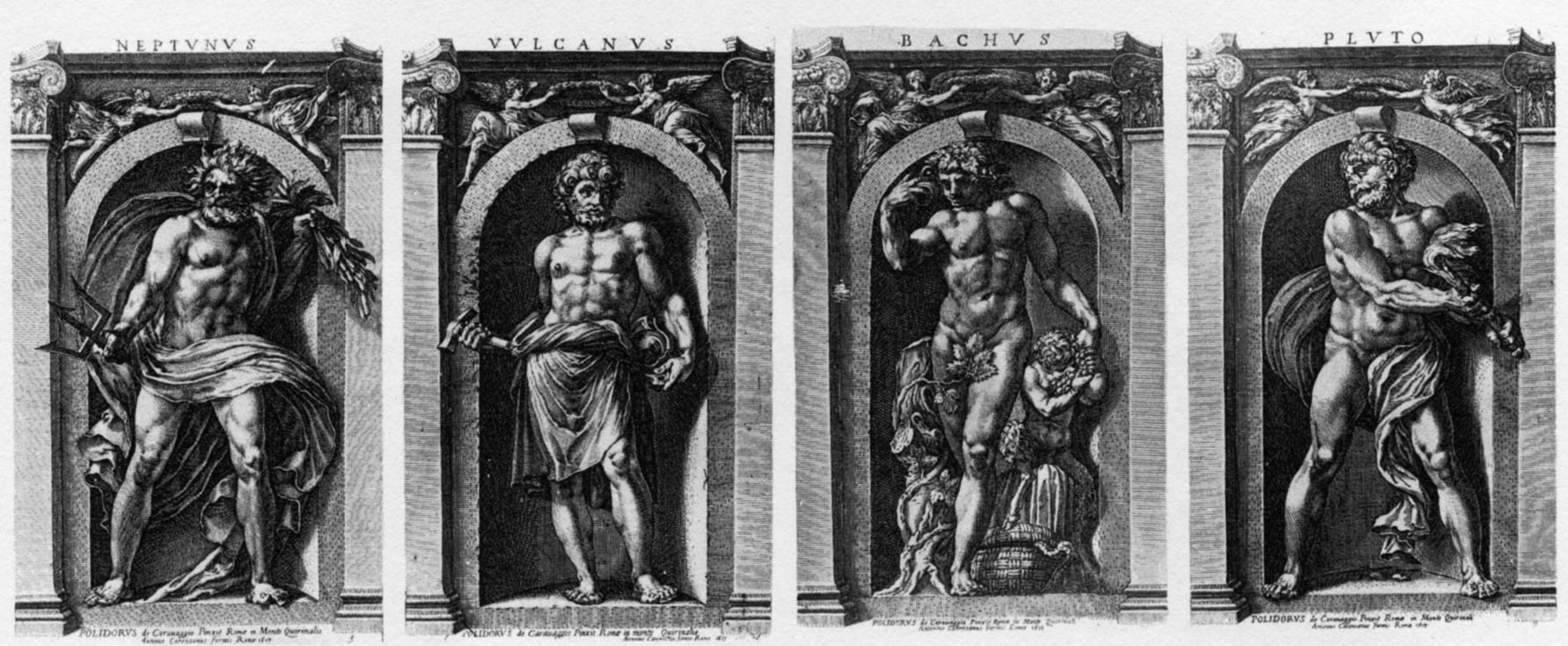
Some of these gods have such active poses, or their drapery and hair are so freely flying out and around, that they appear to a large extent pictorial rather than sculptural. Others suggest real figures rather than statues.
Almost none of Rosso’s figures can be viewed as statues and his use of the niche only emphasizes his departure, far more than Polidoro’s or that of any other artists, from the conventional relationship of figure and its architectural setting. Some of Rosso’s figures are seen from behind. One of them, Jupiter, bounds forward from his niche on a bank of clouds. Apollo rides right by his niche. Not a single figure stays wholly within the space provided for it. While earlier this was not absolutely essential, even in Raphael’s art, the figures did then keep at least the greater part of their mass within the niche settings provided for them. This is also true of Polidoro’s gods. For Rosso this relationship may or may not be maintained, but what is still true is that it is never altogether destroyed. The niche is always present and the torso of each figure is in the center of the breadth of each niche. Delightful is the variety of Rosso’s invention beyond what one knows (and still sees evidence of) are the conventions of this artistic conceit of a figure in a niche inherited from ancient Roman architecture and its sculptural decoration and revived in early sixteenth-century Rome.
Seen slightly from below the lower edge of the niche each figure is given a certain heroic appearance. But this effect is lessened by the placement of each figure at the very edge of the niche. Each posture is ever so slightly precarious in its balance on the floor of its niche. Furthermore, though there is no single attitude that can be recognized to govern Rosso’s characterization of all the divinities, a personal humorous wit is recognizable in so many of them to suggest the levity of Rosso’s mind in the invention of the series. Yet this levity has its own degree of seriousness. Like the Hercules engravings, the Gods in Niches presuppose an audience that is highly sophisticated about the terms of its art and is prepared to recognize and enjoy the fantastical exploitation of it as a form of entertainment. If this is true Rosso’s intended a different kind of meaning from what was Michelangelo’s and Raphael’s, even Polidoro’s, in their art, about which more will be said later.
The first of the series of Gods in Niches shows Saturn, as the Greek god Cronus, the progenitor of the gods, in a three-quarters view seen from the back. He holds up a screaming youth, one of his sons eaten to prevent him and his siblings from overthrowing their father. With exposed teeth the god tears at the soft flesh of the flank of his son. In its terrible aspect the image of this engraving recalls Rosso’s Virtù Vanquishing Fortune and his Fury. He is altogether unlike Polidoro’s dignified and simple standing Saturn of the engraved series mentioned above.56 The musculature of Rosso’s Saturn is emphatically hard and bulging; his son’s body is soft but tense. The light glistens on the surface of the figures and cast their shadows on the interior of the niche at the right. But legitimately horrible as is this conception of Saturn devouring his own progeny, the back view of the figure, the bursting yet static physicalness of it, and the god’s exaggerated expression press upon us the viciousness of the representation without, however, suggesting any further symbolic meaning. Polidoro’s Saturn originally on the facade of the Palazzo Milesi57 is also shown eating one of his children, but it is less bizarre than Rosso’s and less hysterical. Although done about the same time as Rosso’s engraved Saturn, or only slightly later, Polidoro’s image is more heroic and compassionate, suggesting that what is seen, including the god taking the child’s arm into his mouth, refers to more than an act of vengeance and cannibalism. Not that Rosso’s image is misleading in these respects; it is simply not very profound in its definition of these aspects of the Saturn/Cronos myth. The representation is, one might say, not cruel enough; its invention is too fantastical, and perhaps even mocking of what a more straightforward depiction of the subject would be.
Behind the god a huge scythe extends from outside the lower left corner of the niche to the upper right of the half dome of the niche. Its huge blade projects beyond the lower right side of the niche. It is too large to be the sickle with which Cronus castrated his father, Uranus, unless the exaggeration is the intended irony. Cronus was also a harvest god in Greece, but even here he seems to have been identified with a sickle.
As the goddess of the earth’s riches Ops, the second of the series, is shown pressing her breasts; six beasts are impossibly squeezed into the niche behind her. The shadow cast at the right does not resemble her but rather an animal such as the deer at the left, although this cannot be its shadow. Such humorous ambiguity matches that of the characterization of the animals that verges on caricature, especially the appearance of the sideward-glancing lion, aware of the large unaware donkey behind him. The goddess is smoothly broad in the hips, her figure swelling from her closely placed ankles and bending, above the waist, downward to the left; her head is turned to the right and lowered as she looks, possibly demurely, down at her breasts. In spite of the regularity of her forms and the continuousness of her contours the grace of the figure is thwarted by a persistent inflexibility all the more noticeable when one thinks of the contemporary Roman figures of Parmigianino. She hardly moves the spectator as an image of “Abundance” for her invention intends nothing quite so significant; instead she exhibits a kind of girlish sensuality in opposition to the hard ferocity of Saturn, her mate.
The third figure, Jupiter, rides forward on his small eagle with a glance to the left while pointing for the bird to fly to the right as it seems fiercely to peer downward, perhaps at some prey that its slightly open beak suggests. Under the great canopy of his billowing cloak and with his thunderbolt in hand, the god is distracted by something to his right, possibly the demure Ops, the wife of his comrade, Saturn.
This is the first indication that the gods and goddesses, while separated each in his or her own niche, can be aware of his or her neighbor in the series. The recognition of Jupiter’s glance at Ops requires that the images of this series be set out before the viewer in a sequence of more than two. If, however, the engraving were kept as a book, as Vasari suggests, Saturn would stand alone on the right page at the beginning and the first double spread would show Ops at the left and Jupiter next to her at the right. In a large album, however, the whole series could appear together on two large facing pages that would allow for other associations to be recognized.
Jupiter’s drapery, the clouds, and the eagle almost totally conceal the niche from which the god bounds above the sphere of the earth. By an extensive stretch of the imagination this figure recalls Michelangelo’s depiction of God-the-Father on the Sistine Ceiling, and also to some extent the Prophets, as well as the flying divinities by Raphael in the Loggia of Psyche at the Farnesina. But Rosso is not participating here in that kind of artistic endeavor. His Jupiter is no master of of the high arc of the upper air, as the inscription beneath him indicates, but his bursting forth impossibly from the niche strikes our fancy as a delightful conceit.
No less delightful is Rosso’s witty invention for Juno with a peacock, “Saturn’s daughter,” and “ both sister and wife of Jove”, earlier named Jupiter. She is seen from the back and proportioned and posed in such a manner that the shape of her body from waist to ankle resembles that of the peacock’s body from head to breast, but up side down. She looks up into the shadowed niche as though she could see beyond it. This figure of Juno could possibly owe something of its conception to the Grace seen from the back in the Farnesina Loggia of Psyche although that figure by Raphael is a much more plausible and sensual figure than Rosso’s. Rosso’s goddess requires only a casual glimpse to register the full extent of her charms, and as one of a set of twenty engraved divinities little more need have been intended for the appreciation of this one figure. Is she perhaps aware of her companion’s attraction for the young Ops?
Neptune and Thetis move in an almost parallel manner, looking to the right while the wind blows their drapery and hair in the same direction. They are each accompanied by an aquatic beast, his a large seahorse, her’s a fish with a menacing expression, frightened possibly by the splash of the water from the urn held by Thetis upon the hollow shell on which she presses her left foot.
Next appears one of the most majestic figures of the series, Pluto, his lithe and muscular forms and upward stretching posture suggesting Michelangelo’s Dying Slave. Cerberus has the heads of three different species of dogs. For this print Rosso’s red chalk disegno di stampa survives, in Lyons, showing how faithful are Caraglio’s translations of Rosso’s original drawings in the same direction but also how well the draftsman prepared his drawing for the engraver’s use. The god looks back at Neptune and Thetis. Pluto’s is one of the most impressive of the inscriptions: People stand in awe of great Pluto as much as they do of Tartarus over which he is king. Like the disegni di stampe for Proserpina (Fig.D.17B), Mars (Fig.D.17C) and Bacchus (Fig.D.18) the drawing in Lyons shows a dark border all the way around the niche. It is thus clear that originally the prints were not each to have dactylic hexameter inscriptions beneath their niches. Instead of clearing only this area for an inscription the original dark border was entirely removed, creating a greater effect of each figure in its niche with its own shadow falling upon the inner wall of the niche and uniting the inscription with the figure above.
Proserpina, is simply identified as her companion’s wife. She walks to the right away from him, who had abducted her, with flowers announcing the arrival of spring falling from the pile she holds in the drapery against her left arm. Proserpina in a Niche, with flowers floating down, is surely not a sculptural conception and they do not appear in Rosso’s disegno di stampa. However, their addition to the print may have been the poetic idea that came about as Rosso talked over the design while Caraglio was engraving it.
Proserpina’s gentle stride to the right is related to the bold rightward march of Mars who, however, has turned from us and glances back into the shadow of the niche. Only his left cheek is visible. The god seems inspired by one of the soldiers in Raphael’s Massacre of the Innocents, engraved by Marcantonio.58 But how exaggerated the musculature of Rosso’s figure and how jaunty his movement for no apparent reason, his large plume bouncing above his helmet and in front of his raised sword is matched only by the plume of the helmet held by the man in the Liverpool portrait. Mars, who awards spoils of war with victor’s hand could be related to the god’s raised right arm holding a sword. The shield appears too small to conceal the god’s whole arm and his shadow seems quite independent of the figure of the god although a section of the shadow of the plume is visible.
Full-bodied Venus is shown standing on the rim of a huge conch shell a large portion of which projects from the lower right corner of the niche. But the goddess’s feet standing near the rim of the shell are still within the edges the niche. This most beauteous mother of wanton love bends slightly to the left but without turning her body, and in a winsome manner pushes back her hair with her left hand. With her right hand she touches Cupid’s head as he lightly kneels upon the shell and holds out an arrow in his right hand. She is the seductive version of Ops and as with the many of the figures of this series her attitude impresses more as an intelligent artistic invention than a felt emotion. This becomes all too obvious when Rosso’s Venus is compared with the same subject in a niche designed by Raphael and engraved by Marcantonio.59
Raphael’s Venus bends and turns her full body with a grace that paces and coordinates all the variations of her movement. The figure of Cupid at her right reaches up to Venus whose arms embrace his head as her left arm partly conceals his face and thereby blinds him. Unlike Rosso’s, Raphael’s Venus appears deeply knowledgeable of forms and relationships that do more than merely illustrate, though they do this, too, with absolute conviction. But we are more than delightfully entertained by Raphael’s invention; we are also moved by it. For the resources of Raphael’s imagination appear so much richer than Rosso’s, and so much more masterfully controlled. Yet recognizing the different levels of quality here, indicative as it may be of one aspect of post-High Renaissance art in Rome, is no more revealing of what distinguishes Rosso’s genius than of what it may suggest as well of Rosso’s probing of his own talents in Rome. For Rosso’s Venus can also be compared with his (secular) Standing Nude Woman of around 1520.
There is a definition of the spirit in that drawing that nowhere seriously touches any of the Gods in Niches and that still joins this earlier image of a woman to Raphael’s (divine) Venus. Rosso’s stiff bending mature goddess of 1526 is not only remote from us as desirable, palpable fact but also as an inspired mythical idea. What matters here, that is what seems to have directed Rosso’s imagination, is not what mattered six years before to him or what mattered to Raphael. Nor, it must be recognized, what mattered in the creation of the approximately contemporary Dead Christ in Boston. The terms of Rosso’s art in the Gods in Niches are neither searching nor revealing of any serious aspects of the human condition; these have here been set aside for easier and more obvious effects of entertaining human incidents and artistic conceits. A choice has been made to create an art that is intentionally superficial, as though to do more would serve no purpose. To some extent the beginnings of such as attitude can be traced back to his art in Florence immediately after 1521 reaching an altogether unforeseeable conclusion in the Moses and in the Rebecca and Eliezer. In these works, however, the deflection of his humanistic and emotional intentions into an exasperating abstraction produced an alternative to, but also an extension of, his early styles that declared a comparable seriousness of intentions, intellectual as well as artistic. His Roman art of the mode represented by the Gods in Niches does not present the same kind of achievement. There seems here rather an accommodation to meet the expectations established by the art of Giulio, Perino, and Polidoro since the time of Raphael’s death, and even to surpass it in cleverness of invention for viewers of small-sized prints. It would have been another kind of challenge ten years earlier to attempt to surpass the brilliant inventiveness of Raphael and Michelangelo, although in the mid-1520s such a challenge could already have stimulated Rosso in Rome. It was also possible now to relax the requirements of art and to look upon it more as a diversion from too serious a cultural commitment. For by the 1520’s Renaissance art in Rome had already established its own context in which Rosso’s Gods in Niches would have appeared as sophisticated extensions. Neither obviously Raphaelesque nor Michelangelesque, nor demonstrably archaeological in derivation, and yet referring obliquely to all of these sources, Rosso’s inventions of 1526 give evidence of the exuberant capability of his artistic skills with the material of Roman art. Within its context he enlarged not only the stylistic possibilities of his art, but also the range of its intentions.
The freedom of Rosso’s inventiveness in relation to what could seem the limitations of the arrangement of a figure in a niche is nowhere more beautifully, even poignantly, revealed than in the image of Apollo, the eleventh figure at the center of the series.
Unlike Rosso’s figure of Jupiter who bursts forth from his niche, Apollo, in profile, rides across his, the relation of his body to the niche appearing consequently as an almost chance occurrence. Although it is true that Raphael could not have used such a figure as Rosso’s in the niche of the building in the School of Athens and engraved by Marcantonio it is equally true that Rosso could have felt obliged to maintain the traditional relation of the figure and the niche, and preferred not to. Rosso’s Apollo is almost conceived as the Sun, his chariot described as the source of a blast of light. His appearance is of a superhuman handsomeness that passes as a momentary vision before us, differing from the gracefully stable and reflective image that is Raphael’s Apollo. Rosso’s figure is less complex than Raphael’s, nevertheless it projects through its open and arching silhouette a degree of symbolic or allegorical force that has its own kind of meaning as in its inscription from Ovid: All things do I see—and all the earth has sight through me. His large single wide open eye stares straight ahead seeing all things before it.
Looking closely at the single right eye it is possible to see that it may have been drawn by Rosso in his disegno di stampa with the lid down as indicating that the god was looking to direct the course of his chariot. Then it was given a very large iris by the engraver (?) to emphasize its function of sight. Thus to relate it to the caption beneath the niche.
This meaning has a correspondence to the role of the nude angel in the earlier drawing of the Angel of God appearing to St. Roch (Fig.D.15) and, in some measure, to the presentation of the body of Christ in the Boston picture. There is prepared in these works an aspect of the invention of Rosso’s post-Roman Allegory of the Immaculate Conception (Fig.D.32) with its floating figures of Adam and Eve and of Diana and Apollo. The Apollo in a Niche is the only god of the series that seems to carry with it the significance that had been accorded to it by antiquity and preserved in its mythical status is Christian Rome. At the same time Rosso’s Apollo may see even the unseen and allow for the unseen to be seen as Rosso recalls from the Nicene Creed stating the belief of One God … maker of heaven and earth, of all that is seen and unseen. The Apollo in a Niche may be a forgiving replacement for the arrogance shown by the destruction of Apollo in the earlier Fury that Rosso created soon after his arrival in what may have appeared to him as a pagan Rome.
Broad-hipped Diana resembles Venus, and her action of pulling an arrow from her quiver but without holding her bow in readiness to receive it is just as trivial as Venus’ light touch of Cupid’s head. Mercury, the thirteenth of the Gods in Niches has a boyish body that is unlike that of any of the other male figures in these prints.
At his feet lies the large bearded head of Argus, but with only two eyes. Darragon thoughtfully suggested that it is a self-portrait and with its full head of hair, large moustaches and long beard, it resembled closely the portrait in Vasari’s Vite and with the self-portrait in the Gallery of Francis I. But it would likely be an idealized image of an older Rosso than his appearance at thirty-two in 1526.
 Caraglio after Rosso Fiorentino, Head of Argus, Mercury in a Niche |
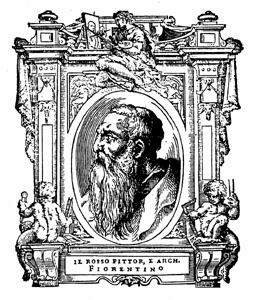 Portrait of Rosso Fiorentino, woodcut, from Vasari, 1568 |
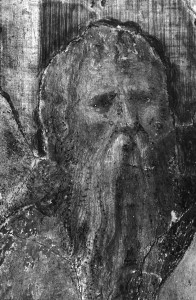 Self-portrait, Royal Elephant, Gallery of Francis I |
A sword, with its hilt projecting sharply from the niche between the god’s legs, suggests the beheading that has occurred, while the god’s playing double flutes refers to how he lulled Argus to sleep. There is a resemblance to the subject of David and Goliath and just possibly a recollection of Donatello’s bronze statue in the Bargello.
The pose of Ceres recapitulates Apollo’s movement though her figure remains largely within her niche. Her shadow has the appearance of a devil, with horns, a sharp nose, and a beard. Ancient coins showed the goddess with snakes and torches to ward off disease and were used in celebration of this goddess of grains and the harvest. The curve of the sickle she holds follows the shape of her buttock and is the instrument that would normally be shown with Saturn (Cronos) with which to castrate his sons.
Hercules is seen squarely from the back, his head turned sharply to the left. The lion skin barely covers his body but only one of his buttocks, the point of the fringe placed at bottom of their cleavage. One of the lion’s paws hangs down where Hercules’ left arm and hand might otherwise appear. The caption that accompanies this rear image of this great ancient hero must be one of the most ironic of this series: This is the image of Hercules as widely proclaimed by Greek poets.
Hebe declares: I am the beauteous goddess who glories in everlasting youth. She runs by her niche, as from outside of it at the right, naked and alarmed with her arms above her head, very much in contrast to the majestic transport of Apollo and the firm immobility of Hercules. She wears a floral crown and long locks of her hair fly behind her. While she glances back as though at her pursuer; whomever or whatever this may be. Perhaps it was one of the many suitors that her eternal youth attracted until she was married to Hercules when he became an immortal.
Bacchus, accompanied by a small satyr, has a large Michelangelesque body posed in an almost spiraling manner with a grace that makes light of his massive physique. While the god is depicted squeezing grape juice into the saucer he holds up with his right hand and thus appears as the god of wine, his caption relates: He that has taught [us] to train the vine-tendrils to grow up elm-trees. The original drawing for this god, in Besançon (Fig.D.18), shows that a dog was at first planned behind Bacchus’ legs. Clearly visible in a comparison between the drawing and the print in the area around the head of the god where the details of the grapes and vine leaves have had to be defined by Caraglio’s burin with a precision beyond what Rosso’s use of soft red chalk described. The conception of this Bacchus by Rosso, and as interpreted faithfully as an engraving by Caraglio—the dog having been already removed by a wash in the drawing 60—is amusingly coy, an attitude matched by the demureness of nude Ariadne (Fig.E.43), the next divinity of the series, who looks modestly down with her arms and hands timidly outspread. A ring of stars encircles her head indicating the constellation Corona into which her nuptial diadem was transformed following her wedding to Bacchus, who found her abandoned by Theseus on Naxos.
Vulcan, wearing a cap similar to Cacus’, his son, in the Hercules series, swings a hammer outside the niche and above his head with both his arms, his lithe and muscular body pivoted on his right foot. His penis swings in the opposite direction. At his feet lie another hammer, an anvil and a pincer with long handles, all identifying him as a blacksmith whose skill fashioned the golden net in which he trapped Venus, his wife, in flagrante delicto with Mars. It is they who make a couple in this series of engravings, numbers 9 and 10. In order to give Vulcan his due his caption reads: Venus, Saturnian mother, is my golden spouse, the trap of gold now an aspect of his wife’s opulent skin.
The last of the series shows Minerva with a large firm body holding her spear in one hand and her shield with the Gorgon’s head represented upon it by the other. She could have resembled Raphael’s thoughtful statue of this goddess in the School of Athens and their Gorgons’ heads are similar, but compared to the painted goddess Rosso’s nude figure looks gross and at the same time languid. She does, however, exhibit some majesty by the fullness of her body within the niche and by her turning posture with her left arm rising above the rim of the niche. The shadow of her lance is barely visible and there is what seems to be a primary and a secondary shadow of her raised arm within the niche and bent downward upon the flat surface of the surrounding wall. Yet there is pomp here rather than grandeur that brings Rosso’s procession of gods and goddesses to a close in a manner that seems appropriate to the similar bravura of his preceding inventions.
Shifting from one kind of figure to another, and from the most extravagant postures to others that are reticent, but all viewed against the same regularly shaped niche, the novelties of the Gods in Niche reveal a new kind of discipline in Rosso’s art. Though recognizable in his earlier Roman works it is more fully apparent as an aspect of his art in these twenty prints and in the four surviving disegni di stampe made for them. There is first of all a consistent substantialness and physical credibility about the figures that mark them as different in general from Rosso’s Florentine figures and hence as Roman in origin. Furthermore, Rosso’s inventiveness here, even when creating an extraordinary figure, seems to work from the physical attributes of the figures rather than from an abstract manner of conceiving them. This, of course, is not absolutely new to Rosso’s art for already in his very early Assumption at SS. Annunziata he made artistic issue out of individual physical appearance. But while some of Rosso’s gods and goddesses of 1526 may be extravagant, witty in appearance, and entertaining, they are not so eccentric or bizarre, even the Saturn, as are many of his pre-Roman figures or his early Roman Fury and Nude with a Standard. The psychologically moving idiosyncrasies of his former Florentine expression have been replaced or reshaped by a language that assumes now much of its form and meaning from the more public mode of Roman art. But it assumes this form with a certain wry knowledge that no absolute commitment to it is necessarily involved in the sense of its arising significantly from artistic concerns as passionate in their origins as those of the works of his first maturity around 1520. Some of the Gods in Niches, however—the Pluto, the Apollo and the Minerva—exhibit an eloquence of expression that carries meaning as effective substitutes for deeply experienced and directly communicated feeling. Yet this is an expression that is still sharply Rosso’s in its intelligence and richness of invention.
LOVES OF THE GODS
Towards the end of his stay in Rome, probably early in 1527, Rosso began another series of disegni di stampe for Baviera also to be engraved by Caraglio. Some impressions of these Loves of the Gods have long texts on separate plates, like the Fury, which again complement the images they accompany. Rosso designed only two of these Loves of the Gods before he had a falling out with Baviera who then had the disegni di stampe for the remainder of this set created by Perino del Vaga after the Sack of Rome. Vasari wrote that this series was begun following the Gods in Niches and it is likely that the Loves was prompted by the success of the twenty Gods. It is probable that the Loves of the Gods was thought of as a kind of replacement for the confiscated I Modi, or Venti Pose, created by Giulio Romano and engraved by Marcantonio in 1524, with the difference that Rosso’s episodes would be mythological in subject and less obvious in their sexual content to avoid confiscation. Impressions of Marcantonio’s prints also had poems, by Pietro Aretino. From the two that Rosso designed, the Pluto and Proserpina and the Saturn and Prosepina, derived directly or indirectly from Hyginus’ Fabulae (nos. 146 and 138), it is clear that the whole series, had it been designed by Rosso, would probably have exceeded in its range of inventiveness the Gods in Niches.
This would have been partly due to the greater possibilities offered by the theme of the second set requiring at least two figures, more similar as an artistic enterprise to the Labors of Hercules. Nevertheless, the two engravings made from Rosso’s designs are so different from each other to suggest on Rosso’s part an even more acute awareness than before of the various possibilities of style within his own artistic activity. Or an even more acute awareness of his ability to exploit various stylistic modes, and to exploit them to special effect within the context of this single artistic enterprise centered on sex.
The large muscular nude of the Pluto and Prosepina are Michelangelesque not only physically but also, in spite of the subject of the print, in the degree of grandeur that they convey at the entrance to the underworld. There is an earnestness in the lunging of these two heavy figures toward each other that is convincingly passionate in the sense of Michelangelo’s art. The masculine characteristics of Prosepina, after the mostly quite feminine goddesses of the Gods in Niches of 1526, only emphasizes the intentional Michelangelesque reference in the scene. It may be possible to go still further and suggest that the erotic implications of some of the handsome paired ignudi of the Sistine Ceiling (Fig.Sistine) have been made explicit in these two nudes by Rosso whose postures, the one bent in response to the other to form an almost emblematic arrangement. Thus while this scene is directly and independently understandable as Rosso’s illustration of the lovemaking of Pluto and Proserpina, a full appreciation of its wit and bawdiness requires, almost certainly, the recognition of the artistic and cultural milieu that it entertained. Rosso’s two antique divinities are remarkably like the figure of Christ in his picture in Boston and shifting our attention from the one figure to the other alters our sexual response much less than might have been expected. For both gain their meanings through a frank avowal of the value of the voluptuousness of the human body. The print, however, is also richly amusing as the lovers, she with her leg widely slung over Pluto’s arm to expose her sex, exert their efforts with some inconvenience situated upon the back of a forbearing, bewildered, and angry Cerberus, with three heads of the same species of dog and a fourth head with a long beard. But only one dog seems aware of what is happening above by letting out a howl from his wide-open mouth.
The Saturn and Philyra is distinctly different. Its style recalls nothing of Michelangelo’s; in fact, it appears to avoid the frame of reference of his art altogether in order to present a pointed contrast to the style of the Pluto and Proserpina. The Saturn and Philyra has taken the elements of its style from Raphael’s art, from the Galatea and the frescoes of the loggia of the Farnesina. But as it may be said that the physical robustness of Michelangelo’s art has been vulgarized in the Pluto and Proserpina, here the grace and measure of Raphael’s art have been refined into the most elegant fantasy. The mood of the Saturn and Philyra is light-hearted and witty as Philyra looks down at Cupid for a suggestion of help faced as she is by the dilemma of a lovesick horse. Unlike the aggressive and ponderous scene of Pluto and Proserpina, the Saturn and Philyra appears flirtatious, not only in theme but also in its relation to Raphael’s style. The postures of the figures, the billowing of the drapery, and the arc of the blade of the scythe, the tip of which has become caught in Philyra’s hair, are so precisely and mutually responsive that the composition of the scene seems in a sense to mock its own clever buoyancy. Nevertheless, the print carries with it some of the eloquence of Raphael’s art and depends almost certainly on the recognition of this connection to make its fullest effect upon the viewer.
Although these two prints are stylistically very different, so much so in fact that without other evidence it might be impossible to attribute their designs to the same artist, neither one is indecisive in the style that it presents. Neither style anticipates that of the other, nor is either less fully explored than the other. Nor are the styles of these prints mere elaborations of what Rosso had done before in Rome. Rather they appear as higher accomplishments in terms of Rosso’s understanding of what Roman art offered. The figure of Philyra, for example, though related to some of the goddesses of the Gods in Niches, and especially to Juno who is also seen from the back, is conceived with a grace and controlled movement far surpassing that of any of Rosso’s earlier female figures. A suggestion of her movement appears in the postures of the three women in the background of the Hercules overpowering the River Achelous, where the possibility exists that Rosso has also been touched by the Roman drawings of Parmigianino such as his Nymphs Bathing in the Uffizi. The grace of Raphael’s figures has now become the pose of a figure serpentinata in the foremost nude carrying the Horn of Plenty. In spite of the extraordinary inventiveness of the six Hercules scenes it is still an inventiveness that looks back to Rosso’s last Florentine works. The Saturn and Philyra has left those works now far behind. The same is true of the Pluto and Proserpina that is also, in its Michelangelism, more accomplished than Rosso’s Dead Christ in Boston.
While we cannot know what Rosso envisioned for the other scenes of the Loves of the Gods—ten according to Vasari when he writes about Rosso’s participation in this series—it is more than likely that their range of expression would have been remarkable and part of the series’ interest and charm. Perhaps these two compositions represented the poles of inventiveness between which a range of interpretation and extrapolation would have taken place. Such differences of styles as are represented by this pair of prints are not unprecedented in Rosso’s career as comparisons of his pictures of 1522, the Dei Altarpiece, of 1523, the Sposalizio, and of 1523–24, the Moses and the Rebecca and Eliezer have shown. The difference of the styles of the two Roman prints is no less deliberate, but the intentions of their differences seem to be quite another issue from that of his earlier works. In Florence and Volterra the acute changes of his style appear to have been at least partly related to the willfulness of his own “opinione contraria” on the one hand, and on the other to the necessity to accommodate his mode of expression to public expectations. The styles of both the Roman Loves of the Gods reflect a total commitment to the artistic possibilities provided by his Roman milieu: the adjustment of his sensibility to that milieu’s expectations is now complete. At the same time it has been knowingly critical in order to exploit fully the terms available to him to the benefit of his own ingenuity. His was not now so much an “opinione contraria” as an opinion that was extraordinarily sympathetic, so much so in fact, that his art had become an art of several manners in response to the various manners that the art of Rome exhibited. No other Roman artist had such a comprehensive view of Roman art nor an interest in its possibilities to prompt the imagination in such a variety of ways, except Perino del Vaga who was to finish the series of the Loves of the Gods.
The entertaining wit and cleverness of the Gods in Niches, the two Loves of the Gods, and the slightly earlier scenes of Hercules’ adventures constitute an alternative to the strong feeling of some of Rosso’s pre-Roman works and to his early Roman Fury. There are, however, precedents for them in his late Florentine works, the intentions of which were other than entertainment. Nevertheless, the poignant seriousness of the beauty of the Sposalizio still pervades the Saturn and Philyra, as it has simultaneously been shaped into a more graceful and flexible expression. In his Standing Nude Youth, in the Louvre, the grace and elegance of the figure of Philyra are not to be lightly appreciated, again perhaps with a suggestion of Parmigianino’s figures. In the context of Rosso’s Roman art this figure, executed in gray chalk, brings to mind the figure of Apollo in the Challenge of the Pierides and the figure of Mercury in the series of 1526. His movement suggests Minerva’s in the same series and to some extent that of the women in the background of Hercules overpowering the River Achelous. But the coordination in the Louvre drawing of elegant proportions with the posture, gestures, and glance of the figure create an image that is almost classical, in the sense, in antiquity, of Lysippos’ and Praxiteles’ art. Again, however, there is nothing in the appearance of the figure that suggests a deliberate reference to ancient sculpture. As in the case of the Gods in Niches the expectation of such a comparison must have existed but not a direct identification with actual examples of ancient art. There is no evidence here of an opinione contraria, nor of any facetiousness in relationship to the artistic attitudes that the drawing seems to reflect, as in the Sposalizio, a very refined and sympathetic response to them.
BATTLE OF THE ROMANS AND THE SABINES
Now without Baviera’s intervention, Rosso’s last Roman work, the Battle of the Romans and the Sabines, engraved by Caraglio but not finished by him at the time of the Sack, is neither amusing nor passionately expressive. It resembles instead in its straightforward seriousness the St. Roch drawings and the Challenge of the Pierides, the large size of which is almost equal to that of the last engraving designed by Rosso in Rome. The architectural setting of the Battle of the Romans and the Sabines is extended from the backgrounds of the episodes of St. Roch’s life while the number of figures in it is even larger, approximately double that in the Pierides. Rosso’s Sabines composition is the most ambitious and most complex of his Roman works making it all the more regrettable that it was never completed by Caraglio. Finished instead by an inept engraver the composition should be studied from the surviving unfinished states of the print where Caraglio’s hand alone has translated Rosso’s disegno di stampa.
Although Vasari called the print the “rape of the sabines” probably because the finished engraving bears this title as well as a Latin phrase at the lower left indicating the same subject, this cannot be what the scene actually represents. In Book I of Livy’s The Early History of Rome,61 the abducted Sabine women pestered Hersilia, Romulus’ wife, to ask Romulus to accept their parents and allow them to live in Rome. The Sabine men, in order to avenge the abduction of their daughters and sisters, attacked the City of Rome themselves. Gaining access to the Forum, they engaged the Romans in mortal combat. The Sabine women, now mothers and reconciled to their Roman captors, intervened and begged for peace. In the center of Rosso’s scene there is a woman seated on a donkey. From her central position and by the gesture of her right hand with the palm down she seems to be the person who is attempting to calm the battle raging around her. The other women tend their children whose fathers are in battle with the Sabine men. In Plutarch’s Life of Romulus, where this battle is described, the women cry out and Hersilia is specifically named.62 But she is not given any other dramatic role; nor is anything said, by Plutarch or by Livy, about anyone riding a donkey. The nude man seen from the back just left of center also appears to be seated on a donkey. At the right there is an old man seated upon another animal that could be the same beast, but only one of its feet is visible. This man has his arms extended toward the woman and his head is turned in the other direction; he appears to be encouraging the young warriors to listen to the peace-making efforts of the central woman. A donkey appears in the crowd at the left ridden by a bearded old man although only one long ear of it is visible, and to the right of him can be seen the ear of another donkey. The woman on the donkey, who, unlike the women at the left, has no children, has been identified as the Roman goddess Vesta, the patroness of family life, seated on her favorite animal.63 Thus the print could be titled Vesta Reconciling the Romans and the Sabines. There is support for this conclusion in Plutarch’s story in which the battle had reached the temple of Vesta where it was stopped by the Sabine wives. Further support is presented at the far left of the composition, where there is no battle at all. Instead there is a procession, with camels in the distance and a leopard (or panther or perhaps a female lion) in the foreground. A man points to the female statue placed high upon the corner of the rostrum. It is possible that this is a procession of followers of Vesta who are led by the Sabine women and by the goddess herself into battle to bring about a reconciliation of the Romans and the fathers and sons of the wives. This interpretation is in keeping with Rosso’s interpretive use of sources for his Challenge of the Pierides, which also does not simply illustrate the story as written by Ovid.64
The size of the engraving and the elaborateness of its composition relate it not only to Rosso’s own earlier Challenge of the Pierides but also to the other large engravings that were made in Rome in the second and third decades of the sixteenth century, specifically Marcantonio’s Massacre of the Innocents and the Judgment of Paris, after Raphael’s designs, and Marco Dente’s Massacre of the Innocents and Martyrdom of St. Lawrence, after drawings by Bandinelli.65 The last was probably done only a few years before Caraglio began Rosso’s Sabines composition. It is slightly larger than Agostino Veneziano’s engraving of 1518 (E. 109) after Rosso’s Disputation of 1517 (D.1). Like these earlier prints Caraglio’s has something of the aspect of a special demonstration of the designer’s and engraver’s talents, and suggestions of the compositions by Raphael and Bandinelli in Rosso’s Sabines probably reflect a high degree of competition with them. References to Michelangelo’s Deluge of the Sistine Ceiling and to antique sculpture have also been pointed out.66 But even as a kind of muscular alternative to the Raphaelesque Challenge of the Pierides the Roman and Sabines engraving is not especially Michelangelesque. Nor can the grace of Raphael’s art nor the very ordered compositions of Bandinelli’s scenes be so easily recognized. After three years in Rome, Rosso’s relation to and understanding of both ancient and modern Roman art was so extensive and so intimate that this late Roman work by him no longer reveals specifically its Roman sources. Furthermore, the scene has comfortably incorporated into it elements that go back to his Florentine Sposalizio and to the Moses and the Eliezer. Although the engraving is of a Roman historical subject there is no pressing archaeological aspect to it. The complexity of the composition clearly indicates its origins in Renaissance Rome with the art of Raphael and Michelangelo and antiquity, and of Rosso’s own contemporaries in Rome, providing its context. But there is also a random quality about Rosso’s invention that shifts its complexity away from what one might earlier have thought of as the grand order of Roman art, as pushed, for example, to academic rigidity in Bandinelli’s Massacre of the Innocents. Instead of narrative concentration Rosso seems actually to diffuse the drama, to distribute it as episodes and incidents throughout the scene.
In its complexity and randomness, and in its details that are not generalized in a Roman manner but maintain a sharp foreign individuality, Rosso’s Sabines resembles Peruzzi’s large Presentation of the Virgin in the Temple in S. Maria della Pace. Both scenes have also a large architectural background and a quality of space that can be read as deep but in which, nevertheless, the foreground figures are somewhat unnecessarily crowded. The foreshortened horse in the immediate front of Peruzzi’s picture is not unlike the foremost donkey in Rosso’s scene especially as both tend to reduce the clarity of the space they occupy. These relationships could be gratuitous given Peruzzi’s also Tuscan, albeit Sienese, background and his own very personal kind of accommodation to the art of Rome that tended to produce an art, not unlike Rosso’s, of coordinated but disparate qualities. Still, the bearded old man with his parallel arms extended across his body and to the side just right of center in Rosso’s composition is remarkably like Peruzzi’s God-the-Father in his Creation of Eve in the Cancelleria, probably done in 1519.67
Both figures are pointing to the most significant person in the pictures and the identity of Peruzzi’s God-the-Father might be lending though its grand appearance a special authority to the man on the donkey in the print. Furthermore, if the recently revised dating of Peruzzi’s fresco in S. Maria della Pace to the years 1523 and 1526 is correct68 it is possible that it was done at the time that Rosso himself was working in the same church. Executed then (or earlier) it is also possible that in the second half of 1524 Peruzzi’s fresco had some influence on the conception of Rosso’s drawings of the life of St. Roch. These drawings provide, in Rosso’s own oeuvre, the clearest precedents for the composition and details of his Sabine design.
At the same time, the Sabines engraving shares the ambition of its design and the inclusion of non-Roman idiosyncratic expression with Perino del Vaga’s Visitation in the S. Trinita dei Monti (Fig.Perino,Visitation), probably datable within the same period that has been suggested for Peruzzi’s fresco, between 1523 and 1527.69 Although Perino’s picture is more spacious than Rosso’s, making them in this respect fundamentally very different, the Visitation has a similar randomness in the disposition of its figures against an imposing background of architecture. The diffusion and richness of incidents of Perino’s fresco also recall Rosso’s scene. But there does not seem to be any direct relation between these two works of art. Again, as in the case of Peruzzi’s Presentation, the correspondence may be the result of similar sources producing partially corresponding effects at about the same time in Rome. Perino’s recent return to Rome from Florence, where he seems to have studied the works of Pontormo and Rosso, would only have increased the possibility of coincidence of artistic inventions in his and Rosso’s works. All three works by Peruzzi, Perino, and Rosso recognize the challenge presented by the grand schemes of Roman High Renaissance art, of Raphael’s works from about 1515 on especially, and in Rosso’s case, also Michelangelo’s Sistine frescoes. There is every reason to believe that the terms of that art were well understood by Rosso, and that, like Peruzzi and Perino, he knew how to manipulate them. What, however, they did not observe in the mid-1520’s is what might be referred to, in an almost architectural sense, as the original order of those terms. The terms themselves—the figures and the buildings—maintained by their size, veracity, and variety the semblance of that original order. Or, it might rather be said, they did not contradict the basically realistic tenets of that earlier Roman art, or the grandness of its intentions. The terms could not, of course, remain altogether unchanged, but they were less altered than these approximately same terms were in some of Rosso’s earlier Florentine art and in Pontormo’s contemporary art in relation to what preceded them in Florence. In Rome such transformations were not possible, so authoritarian, it would seem, were the examples of Raphael’s and Michelangelo’s art taken to be. Nor could the order of their art be subjected to the fantastical distortions that were possible in Florence. Nevertheless, one variation that was possible in Rome was a shift of that original architectonic order into a new multifarious casualness. This new randomness of composition was nevertheless responsive to what had gone before and was conceived not disrespectful of the latter. Its innovations extended the possibilities of that earlier art even as eventually they would seem so much less seriously intended than those of that earlier art. But in Rosso’s Sabines composition this was certainly not yet the case.
In Rosso’s scene, as in Peruzzi’s and Perino’s frescoes, it is not immediately clear where one should direct one’s attention. In spite of the fact that the very center of the engraving is occupied by the head of the woman on the donkey on whom the drama of the scene seems to be focused, the action around her, while it does to some extent point to her, also directs one’s attention elsewhere. The density of the composition is such that one is compelled to investigate it in its entirety and sense its order accumulatively rather than to grasp its order relatively quickly and then have one’s attention bound by it. For even as one realizes the inclination of some of the effects of this composition towards the center it is also easy to read some of them and others as dispersed. Given the focus or direction of Raphael’s and Michelanglo’s art, and of Rosso’s own earlier works, it might well be asked what advantage Rosso found in distending the focus of his narrative and consequently lessening its impact. For one thing there is suggested by the asymmetrical architecture and by the cutting off or disappearance of some of the figures at the outer edges of the scene that the world of Rosso’s image is larger than what we actually see of it. Furthermore, not everyone in the engraving is aware of what is happening in the foreground, nor has everyone the aspect of being thematically or pictorially necessary to this scene. Not that informal secondary figures were absent from Raphael’s pictures where they provide a context and emphasized by contrast the importance of the major protagonist. In Rosso’s scene, however, some of the minor figures are at least as interesting as the major actors in the scene. The diversity of types and poses of these smaller figures in the upper background differentiates them, in certain cases very distinctly, from the more generally similar and idealized figures in the foreground. But within the background group various degrees of awareness of what is happening in the foreground appear, bringing our attention also forward, for which a similar, but rather obscured, precedent occurs in the background of the Sposalizio of 1523. The two nude men coming down the stairs move us towards the center of the engraving although their glances are cast to the left side of the scene. Immediately to the left of them, the outstretched arms of the old bearded man emphatically point out the central woman, who may be the goddess Vesta, riding on an ass. At the far left the gesture of a nude man in the foreground similarly gestures, but to the right. Behind him a crowd moves forward, with some of its figures farther back looking up at the statue above and others farther forward glancing towards the center foreground episode. Still, these various gestures and movements in the foreground and background are so scattered that they do not compel our attention towards the middle of the scene. Furthermore, the pair of women with their children to the left and the battling men at the right, especially those fighting against opponents who are partly out of the scene at the right, present groups of considerable interest that tend to reduce the dominance of what appears in the center, and which through its placement and other signs is indicated to be the most significant narrative element in the engraving. Given the elaborateness and complexity of this scene it cannot be assumed that its composition is only the result of over-enthusiasm for invention, though this may certainly have had its part in directing Rosso’s intentions. But there seems also here the realization of a desire to be less consistently grand than Raphael and Michelangelo and to produce an art that is not so singular and focused in its expression. As a result the effect of Rosso’s Sabine scene is almost the antithesis of Bandinelli’s in his Martyrdom of St. Lawrence.
Although none of Rosso’s earlier Roman works, in spite of their ancient subjects, give evidence of a direct, sympathetic and pervasive relation to antique art, in the sense that Giulio’s and some of Peruzzi’s and Perino’s art does, the Sabines composition may well be dependent upon his study of Roman narrative reliefs. It is not merely that the poses of some of Rosso’s figures can be related to those of figures of various Roman reliefs, or even that the lower half of Rosso’s design is almost entirely contained within a rectangle that may suggest the format of a relief. It is rather the continually fused quality of the foreground of Rosso’s composition that suggests the lessons of ancient Roman narrative reliefs. The very close relation between what is dominant and what is less important brings to mind some densely composed Roman sarcophagi reliefs as well as other historical narrative reliefs, such as those on the Arch of Titus and on the Column of Trajan. The similarities are not such as to give Rosso’s composition the aspect of a pictorial translation of antique relief sculpture; the depth of even the lower half of his composition points out the imagination of a painter. Nor does Rosso’s Roman narrative appear authenticated by obvious quotations or paraphrases of Roman art. In these respects the style of Rosso’s picture reflects his usual independence from the very art that he may have chosen to take advantage of. What interested him in the Roman relief sculpture he chose to study was its unrelieved complexity and its unrelieved dramatic continuousness. That these were modified in his own work does not conceal the fact that in their modification the artistic ideals of his earlier compositions were significantly altered. No earlier work by Rosso, including the crowded Disputation of 1517–18 or the unusual Moses of 1523–24, is so difficult to comprehend as the Sabines composition of 1527. The broad clear patterns of organization of his earlier works have, in this instance, been largely displaced by accumulative mode of composing whereby details and incidents are gathered together and juxtaposed to form an extended design. It is the viewer’s somewhat difficult task to recognize the separate narrative elements of this scene that together create the matrix of Rosso’s composition.
Perhaps if we knew more of the story that is illustrated by Rosso’s scene and if the engraving had been completed by Caraglio with that subtlety of effect visible in the impressions of the unfinished states, Rosso’s intention would have been clearer. Yet even in the simplest outlines of the early states the composition of the Sabines appears Rosso’s most difficult composition to comprehend up to this time. Compared even to Michelangelo’s complexly organized Battle of Cascina Rosso’s design appears tenuous; compared to Raphael’s Massacre of the Innocents it appears almost without order at all. For the kind of order it does have requires for appreciation the kind of close attention that would be necessary to understand a dense literary text. Given the need for that kind of close scrutiny the potential force of the crowded drama of Rosso’s subject is diminished. Its casualness, on the other hand, and its Florentine colloquialisms, are not sufficiently moving or poignant enough to compensate for the lack of a larger order and broader narrative clarity. Artful as Raphael’s Massacre of the Innocents is, one is moved by its declarative power and by the total emotional commitment that it conveys. It surprises us in Rosso’s scene that the two women with three children in the left foreground could be so unmoved by the battle raging to the right of them or by the central woman who is trying to bring calm to the scene. The multiple effects of the Sabines engraving that could strike one as merely a random accumulation of incidents actually create its artistic structure, although too many effects could seem to have been invented to too little purpose. It is possible that, after three years in Rome, Rosso had learned so much that at this moment he was not quite sure of his own artistic intentions. But the Romans and the Sabines may also represent a turning point in the evolution of his art, the consequences of which might be seen in his subsequent creations. Although the Battle of the Romans and the Sabines is the last Roman work by Rosso of which we have abundant knowledge, there was another late Roman composition, a painting that is now lost. This was an oil sketch of the Beheading of St. John the Baptist that was, in the middle of the sixteenth century in the now destroyed church of S. Giacomo Scossacavalli (L.19). It is likely that it was a study for a large painting that was never executed or never finished, perhaps, given its subject, commissioned by a Florentine patron in Rome. It would have been interesting to see how Giovanni Battista, il Rosso, conceived the decapitation of his own namesake. If Vasari’s use of the word “bozza” for this painting is interpreted correctly here this would be the only known instance of an oil sketch by Rosso, although his St. John the Baptist in the Wilderness of 1521–1522, in a private collection in Florence, which was most probably not made as a study for a larger painting, is executed somewhat in the manner of such oil studies. However, with more figures on a panel of probably about the same size the Beheading would very likely have been sketchier. This would be one of the earliest examples of the use of an oil sketch. That the large painting itself was actually planned may be indicated by the Profile Head of a Young Woman in the Fogg Art Museum, which could just possibly be the study for the head of Salome or Herodias.
It has some of the elaborateness of the heads of the youths in the Boston Dead Christ, but it also goes back to the beautifully coiffed women in the Sposalizio and in the Moses and in the Eliezer which, ultimately, of course, reflect Michelangelo’s teste divine. But there is a degree of physical vulgarity about the head of Rosso’s drawing that relates it to Proserpina’s in the Pluto and Proserpina of early 1527. However, the Fogg drawing still shows Rosso”s “gran pulitezza” as a draughtsman. If, like the Battle of the Romans and the Sabines, the Beheading of St. John the Baptist—the sketch and the planned final painting—was difficult to comprehend compositionally, it may, nevertheless, have been exquisite in detail, if this drawing tells us anything about this particular composition. Perhaps in these respects Rosso’s lost Beheading, like the Romans and the Sabines, would have introduced us further to that mode of expression that appears in his first large post-Roman painting, the Pietà in Borgo Sansepolcro.
Rosso’s three years in Rome were so far the most diversely inventive of his career. This is not to say that his various Roman inventions were as profoundly original as the works of his earlier years. It may be necessary to recognize that they were not, in order to see precisely their nature as Rosso’s artistic achievements of these years. For the changes in his art that occurred in Rome not only show a new range of stylistic expression but also, it seems, new attitudes towards his activity as an artist. However one might characterize his pre-Roman art, it must be acknowledged that it was in several ways at variance with the accepted order of the most modern Florentine painting. But the aims of Rosso’s art were no less serious and in certain respects his accomplishments were significantly more profound than those of Fra Bartolommeo and Andrea del Sarto. He was able to achieve a level of meaning that actually more closely approached that of the art of Leonardo and Michelangelo, but with terms that had evolved significantly beyond the norms of their art. Nevertheless, his eccentricity would seem to have had some support in Florence, at least in private circles. In Rome the situation was different and from the very beginning, in the frescoes of the Cesi Chapel, in the St. Roch drawings, and in the Challenge of the Pierides, it is clear that Rosso wished to identify his talents with the greatest art of Renaissance Rome, in spite of the adverse criticisms he seems to have made of the paintings of Michelangelo and Raphael.
The impulse to be different, so evident in his Florentine works, was not to be suppressed in Rome, as evident at the very beginning of his stay in the bizarre extravagance of the Fury. After this moment, however, the kind and degree of eccentric expression found in this print did not again appear in his Roman works. Nor did that kind of exacerbated passion, extended from his Florentine art, play a role in his later Roman creations. This kind of expression would be replaced by a greater concern for wit and elegance, and for, in certain instances, the direct appeal of vulgarity. All of these attitudes prompted necessarily new inventions and a certain reduction in the discipline of earlier sixteenth-century Roman art. The casualness of the design of Rosso’s Sabines has also partly its origins, it seems, in the wish to create an art that appeared not quite so inevitably certain in its significance. His relations with Baviera and Caraglio encouraged furthermore the creation of a large number of works that otherwise would certainly never have appeared. In spite of the withdrawal of the Cesi Chapel project the opportunity to exercise his talent had never been greater. But the exercise of that talent for a Roman audience had to re-shape his modes of expression. It may not be altogether misleading to say that Rosso realized in Rome the value of the market he could serve by adopting its attitudes of sophistication. The terrible seriousness of some of his earlier art was put aside as was also its very private obsessions, although this had already begun to occur in the Dei Altarpiece. In Rome Rosso became a master in that city’s sense of the term, a master capable of serving the artistic requirements of a larger and more public audience than was his in Florence. That he did not actually serve it on a grand scale still allowed for the expression of his opinione contraria in the some of the thirty-one designs for prints. In frescoes, easel paintings, and even more extensively in the variety of these disegni di stampe, the years in Rome prepared Rosso for the greatest occupation of his life as the principal painter to Francis I, the King of France.70
* * *
Vasari reported that at the Sack of Rome which began on 6 May 1527 Rosso was taken prisoner by the Germans and badly treated; stripped of his clothes and barefoot he was forced to carry heavy loads and to empty almost the entire contents of a cheese and butcher shop (pizzicagnolo). With the retreat of Charles V’s men the artist made his way to Perugia where he was clothed and cared for by Domenico Alfani.71 However, at the very beginning of the assault, Rosso found refuge in the palazzo of Cardinal Andrea della Valle in the Rione S. Eustachio, along with Jacopo Sansovino and his wife and nearly four hundred others. Already on 8 May an Italian captain in the Imperial forces, Fabrizio Maramaldo, was able to get over 34,000 ducats for protection from those in the della Valle palace. But within a week when the palace of Cardinal Piccolomini was besieged by the German Landsknechts forces under Marmaldo and fell within four hours. Cardinal dell Valle fled from his palace abandoning those that had been under his protection into the hands of the German troops.72 It would probably have been then that Rosso underwent the cruelty described by Vasari. The artist may have gotten away in July during an interruption in the siege due to an outbreak of the plague when, according to the memoirs of one of the commanders of the imperial army, “we left the city for the Marches to find cleaner air.”73
Before leaving Rome, and very likely, before the Imperial troops reached the city, Rosso took care to protect the Dead Christ that he had painted for Bishop Leonardo Tournabuoni, who was also in Rome and fled to Borgo Sanespolcro. The picture, and other of Rosso’s belongings, were being kept by a Florentine sister as S. Lorenzo “in Colonna,” identified as the convent of Poor Clares at S. Lorenzo in Panisperna. Before September 1527, and again that month, Rosso, in Borgo Sansepolcro, attempted to recover the picture and his possessions. The immediate outcome of these negotiations is not known, although eventually Tournabuoni did receive his picture.
“The arrival of the imperial army in the capital of Christendom after an interminable descent the length of the peninsula,” quoting André Chastel, must have been recognized too late by Rosso—and others—or he would have fled sooner than he did. But if its threat, again quoting Chastel, “with anxiety running high because of dreadful predictions, false reports, and all sorts of premonitions”,74 if not the Sack of Rome itself, was sensed early enough it could have prompted the making of the disegno di stampa for the Battle of the Romans and the Sabines, but not early enough to allow Caraglio to finish his engraving of it. The historical subject of this last print is, ignoring the earliest, the Fury, unlike any of the preceding twenty-nine mythological engravings. The hope for a reconciliation that the subject of the Romans and Sabines seems to propose might have been recognized by the Renaissance humanist’s imagination as analogous to what the threat of the approaching foreign army would have led the current Romans also to hope for.75 In the months of the approach of the Imperial forces there might have been time to get this print to the waiting citizens of Rome to raise their spirits. After the Sack that Caraglio survived and did not flee, he or Baviera or both may have chosen not to return to the engraving, very probably because its subject, however it was interpreted, would not have found a market. From the evidence of the finished print the disegno di stampa was lost by the time the engraving was worked on again when Caraglio had left Rome, around 1533–34, and moved to Venice.76 When it was completed for the stampatori, according to Vasari, it was a “cattiva cosa” done “tutto per cavar danari.” (And although this work has since come into the hands of the printers, it has proved a miserable failure, for the engraving has been done by one who had no knowledge of the art, and thought only of making money.)77
1 See Vasari-Milanesi, V, 160–161.
2 See André Chastel, “L’aria: théorie du milieu à la Renaissance,” in L’uomo e il suo ambiente (Quaderni di S. Giorgio, no. 34), Florence, 1973, 161–179, and Chastel, 1978, I, 393–405.
3 See Cox-Rearick, 1964, I, 37–38, and Freedberg, 1971, 120.
4 On Fra Bartolommeo’s St. Peter and St. Paul, in the Vatican, the former completed by Raphael, see Hans von der Gabelentz, Fra Bartolommeo und die Florentiner Renaissance, Leipzig, 1922, I, 166–167 .
5 Grime and old restorations had left the frescoes in a condition that has made it impossible to be sure of what one was seeing (Fig.P.17b). Their colors could not be identified with any certainty (Fig.P.17b (2)). In this state any evaluation of the paintings was only a surmise.
6 Vasari-Milanesi, V, 161; translation, Vasari-DeVere, V, 194: “in which city his works were sought for with extraordinary eagerness, great expectations having been awakened about them by the sight of some drawings executed by him, which were held to be marvelous, for Rosso drew divinely well and with the highest finish.”
7 See Cellini’s account of going to see Rosso there, in Cellini-Ferrero, 1971, 121–122.
8 On Baverio de Carocci da Parma, called il Baviera, see Vasari-Milanesi, IV, 354–355, n. 4 and V, 425; and Landau and Parshall, 1994, 159–160 and 360.
9 Pope-Hennessy, 1970, 362. Although finished in 1525 it might have been seen by Rosso while Bandinelli was working on it in Rome, or when finished if the disegno di stampa for the Fury was done that year.
10 Bartsch, XIV, 1813. 321–323, 426, as by Agostino Veneziano. On the attribution to Marcantonio, see Oberhuber, 1966, 102–103, no.145, and Fig. 17; and Davis, 1988, 110–113, no. 37, with Fig.
11 Vasari-Milanesi, V, 424–425; translation, ADD Vasari-DeVere, , on Caraglio’s prints
12 Kornell, 1989, 845, Fig. 56, 846, related the print to Rosso’s study of anatomy that Vasari mentions somewhat later in his Life of Rosso.
13 Franklin, 1988, 326, thought the missing penis was due to the fact that the figure is a partial écorché. But similar figures in the Disputation of 1517 are not missing this member.
14 While the head of Rosso’s Fury can be compared with the so-called Fury by Michelangelo in the Uffizi (Fig.Michelangelo,Fury; see Hirst, 1988, 107–109, Pl. 219) done for Gherardo Perini in Florence, the meanings of these heads appear quite different. Gilbert, 1992, 218–221, Figs. 5–6, thought that Michelangelo’s drawing, which may well pre-date Rosso’s Fury, actually served as Rosso’s model. But Michelangelo’s head seems to me of quite a different type—a handsome, virile head of a mature, unbearded, man with an expression of intense emotion, similar to that of the shouting man in Leonardo’s Battle of Anghiari, as Gilbert recalled was pointed out by Forlani Tempesti. The head of Rosso’s figure is desiccated and has a scraggly beard. Compared to Michelangelo’s head Rosso’s appears horrible and vile. Nevertheless, there may be a thematic connection between the two images, which are close in date. Gilbert showed that Michelangelo’s drawing was already in the 1560s described as a “viso quasiche di furia.” While Rosso’s figure can be seen as a Fury the complete and quite different image signifies something more extensive and more particular in its many details than Michelangelo’s isolated head. Gilbert also suggested a connection with the witches’ sabbath in Rome, an event of 1532 that is described in Cellini’s autobiography (section LXIV). But what Cellini actually wrote has little in common with Rosso’s Fury.
16 See Cellini-Ferrero, 1971, 293; and Cellini-Symonds, 1929, 199.
18 “Una memoria di Gentil Virginio Orsini Conte dell’Anguillara,” The Lakes of Bracciano and Martignano Regional Park, Website.
19 Ciardi and Mugnaini, 1991, 34, noted a resemblance between the central figure of St. Roch and the figure of Concordia on ancient Roman coins. This is not a correspondence that I recognize. For the standing figure of Concordia on the reverse of a coin of Caligula’s, see Breglia, Laura, Roman Imperial Coins, Their Art and Technique, London, 1968, 44–45, no. 6, with Plate.
20 The problem of Rosso’s relation to Polidoro is compounded by the uncertainty of the dates of the latter’s works that are stylistically closest to Rosso’s. The scenes that decorated the Palazzo Ricci and that seem to bear most upon any recognition that Rosso studied Polidoro’s art have been dated by Marabottini (1969, 123) around 1525, and by Freedberg (1971, 146) around 1524–1525. It is also not absolutely certain when Rosso’s Labors and Adventures of Hercules were designed. They may very well have been done before the Palazzo Ricci frescoes.
21 See Perino’s frescoes in the Pucci Chapel in the Trinità dei Monti that seem to have been largely executed after his return from Florence (see Freedberg, 1971, 140–141, and 487, n.57; and Parma Armani, 1986, 55, 258–260, Sceda A.VI).
22 See The Myths of Hyginus, translated and edited by Mary Grant, Lawrence, 1960; and Gods and Heroes of the Greeks: The “Library” of Apollodorus, translated with introduction and notes by Michael Simpson, Amherst, 1976, 90–137, both with references to other sources. All the sources are also given in Graves, 1975, II, 152–158, no. 134 (Cerberus), 190–195, no. 142, 200–206, no. 145 (Nessus), 107–110, no. 124 (Hydra), 158, no. 134.8, 113, no. 126b (Centaurs), 158, no. 134.8, 190–195, no. 142, b–d (Achelous), and 136–137l, m (Cacus).
23Turner, 2007, 363 and n. 16, believes that the Hercules series was left unfinished when Rosso “stormed off” as he had when working on the Loves of the Gods series. “A full set of Hercules Labours was clearly planned beyond the six extant; a drawing now in the University of Göttingen Art Collection, whether it is Rosso’s autograph or (as I think likely) a copy, certainly belongs to this series and shows the later episode of the Hesperides.” There is no evidence that the Hercules series was “clearly” meant to be larger than the six that are known, and the Göttingen drawing of Hercules picking a golden Apple of the Hesperides is neither by Rosso or copied from a work by him, and hence not “certainly” part of the Hercules series by Rosso. The drawing (pen and black chalk, brown wash, 26.5 x 22 cm, kindly brought to my attention in 1966 by Dr. Hans Wille [Fig.Göttingen Hercules]) resembles the the drawings of Étienne Delaune.
24 The cap as pointed out by Campbell, in RISD, 1973, 79, under no. 85; the same kind of hat is worn by Vulcan in the series of Gods in Niches designed by Rosso in 1526 (Fig.E.44; on which, see below).
25 About the same time a similar overlapping appears in a fresco associated with Polidoro from the Villa Lante in Rome (Marabottini, 1969, 66, Pl. XXVII, Fig. 4).
26 Campbell, in RISD, 1973, 76, indicated that this figure may be Hades as appears in a variant of the myth in Iliad V: And even great Hades himself was stricken by a swift shaft, when that same hero [Hercules], aegis-bearing Zeus’ son, wounded him at the Gate of Hell, at Pylos, among the dead, leaving him in agony. Hades fled to the house of Zeus, to high Olympus, shaken to the core and in great pain, for the arrow had pierced his mighty shoulder, and his heart was labouring. There Paeon the Healer spread soothing herbs on the wound, and cured Hades, one not made as mortals are. See also Sheard, 1978, no. 95 with illustration (New York, Copy).
27 The action of Hercules’ right hand is difficult to understand. He seems to have his thumb and first finger around a flap of the lion skin, comparable to a piece of it at the other side of his head. Perhaps Caraglio misread Rosso’s disegno di stampa that might have shown the position of Hercules’ hand and fingers as they appear immediately upon the release of the arrow.
28 See Galinsky, 1972, Chapter IX, “Exemplar Virtutis,” 185–230.
29 Ettlinger, Leopold D. “Hercules Florentinus.” Mitteilungen des Kunsthistorischen Institutes in Florenz, XVI (1972): 119–142.
30 See Winternitz, 1967, 186, 190–191, Pl. 79; and Pope-Hennessy, 1970, 95, 96, Fig. 83.
31 As pointed out by Mirimonde, 1973, 143–144, Fig. 5; for the drawing, see also Parker, 1956, 341, No. 639; see also Winternitz, 1967, 186, 191, Pl. 80; and Pope-Hennessy, 1970, 96, Fig. 84, 97.
32 Ovid-Miller, 1926, I, 258–285.
33 On the relation of Apollo, Bacchus (Dionysius), and Minerva, see Wind, 1968, 196, and n.21. On Mercury’s relation to music, see Meyer-Baer, 1970, 288, and Kiadó, 1984, 11–12, Fig. 2. In Ovid (I, 689–712; Ovid-Miller, 1926, I, 50–53) Pan created the syrinx: which seems to be held by the Muse at the far left in Rosso’s scene.
35 As Zerner indicated (EdF, 1972, 249, under no. 205) the Neoplatonic interpretation of the subject of this engraving resembles that of the contest between Apollo and Marsyas. On the Muses and the harmony of the universe and its relation to the harmony of the soul according to Plotinus, see Meyer-Baer, 1970, 18–22, 30–35, and 68 with relation to the lyre. Surprisingly Rosso’s Calliope holds a lyre with a bar down its center and apparently without strings which are often a crucial aspect of its meaning. But then none of the string instruments in the Pierides engraving are depicted with strings. Mirimonde, 1973, discusses the instruments in Rosso’s composition, although he does not mention the syrinx apparently held by the Muse at the far left. The Muse next to her holds a kind of harp, of which only the sound box is visible. The two long wind instruments held by two Muses are incorrect versions of the ancient double aulos. The small wind instrument lying at the feet of another Muse is a Renaissance chalumeau. A different kind of lyre, again interpreted incorrectly from ancient sources, is seen at the lower left.
36 Vasari, 1568, II, 205; Vasari-Milanesi, V, 155–156.
37 Such as the sarcophagus mentioned by Mirimonde (1973, 144) in the Museo Nazionale delle Terme, Rome, and two others in the Palazzo Mattei, Rome (see Max Wegner, Die Antiken Sarkophagreliefs, V, 3, Die Musensarkophage, Berlin, 1966, nos. 128, 167, 168, Pls. 54a, 84, 87, 150b.
38 Vasari-Milanesi, VI, 9–10; ADD Vasari-DeVere, ADD VOL. & PAGE
40 Shearman, 1966, 156, 157, Fig.7, and Bober and Rubenstein, 1956, 127, under no. 94. See also below n. 44.
42 Hirst, 1981, 48, n.27, thought the “strange grey-brown flesh tones of Sebastiano’s Christ are reflected in the Roman and post-Roman paintings of Rosso.” I do not see this in the Dead Christ.
43 Freedberg, 1963, I, 69–70, Fig. 150, II, 128–129, dated the fresco between 1523 and 1525 and very close to the Scalzo Visitation of 1524; Shearman, 1965, I, Pl. 71a, II, 244, dated it just before 1520.
44 This lost painting is known from Agostino Veneziano’s engraving of 1516; see Freedberg, 1963, I, 33–34, Fig. 60, II 52–53; and Shearman, 1965, I, 45–46, P1. 46a, II, 229–230.
45 See Sinding-Larsen, 1974, 100–101, who stated also that the candles do not refer to the resurrection and the paschal candle, that Shearman suggested and that would be indicated by one candle. Quoting from the Life of San Gaetano (Acta Sanctorum, XXXV, Augusti II, 277) Hartt, 1963, 231, reported that “in order that we mortals should be more greatly moved through external appearance and sense [Gaetano] began to expose the august sacrament between shining torches.” The three tapers of each torch with one light might refer to the Trinity. Chastel, 1983, 166, found in the Dead Christ the “reflection of a certain kind of spirituality—the mystic of the amor divino, favored and encouraged by the Datary Giberti.” I do not know how this would be related to Bishop Tornabuoni’s own interests.
46 Stefaniak, 1992, explored the meaning of Rosso’s painting as an image related to the equivocal definitions of the Eucharist and of the mass in the mid-1520s. She also saw a special significance in Christ’s wound as indicating that Christ “was surely destined to be reborn feminine (711).” She took the position that “In a real sense Rosso’s knowledge or intention in painting the panel is irrelevant, since once it left his hands, its meanings were subject to revisions by its Renaissance readers (716).” I cannot entirely follow her here. It might be pointed out that it is likely that very few Renaissance men or women saw this privately held painting. Stefaniak saw the picture both as an Imago Pietatis and a Man of Sorrows although Shearman (1966, 151) said it was neither. Both saw a reference to the Resurrection in the equivocal definition of Christ’s posture, and both connected the image to the story of Adonis (Shearman, 1967, 67).
47 Caron, 1985, 487, recognized the chiaroscural color as coming from Raphael’s Transfiguration, and the cangianti as related to Michelangelo’s art. Hall, 1992, 155, thought the latter gave a sense of transcendent beings, the deep chiaroscuro an aura of mystery.
48 The figure of Rosso’s Christ was associated by Vermeule, Shearman, and Freedberg (see under P.18) with a drawing for a Pietà in the Louvre (Inv. no. 716) that has been attributed to both Michelangelo and Sebastian del Piombo, and dated at various times, but always related to the latter’s Pietà in Ubeda, commissioned in 1533 but not painted until 1537–1539 (Hirst, 1981, 126–129, 131, Pls. 163–166, and Hirst, 1988, 61, 69, Pl. 141). Apparently Sebastiano’s Pietà was to resemble Michelangelo’s statue of the same subject in St. Peter’s, done thirty years earlier. Given the size and vertical format of the painting, and considering how much later it was done, it does resemble Michelangelo’s statue in the juxtaposition of the two figures, in the Virgin’s extended left hand, and in Christ’s fallen back head seen above his raised right shoulder. The statue and the picture are also in the same direction. One should also note that in the Louvre drawing Christ’s legs are lightly sketched and although their position is not as in Michelangelo’s Pietà and were most likely never intended to be included in Sebastiano’s painting, nevertheless they indicate the thought of the draughtsman, when creating the drawing, of a fully extended figure, as in the statue. The fine modeling of the torso in the drawing also recalls this extraordinary feature of Michelangelo’s carved figure. What might be concluded, then, is that the Ubeda Pietà is, over thirty years later, a kind of re-invention of the Pietà in St. Peter’s in accord with the requirements of an upright picture. As the drawing seems to have been made for the Pietà that Sebastiano eventually painted there would seem to be no reason to date it before he received the commission for his picture. Therefore, it can hardly be a drawing that was made before Rosso began his Dead Christ, as Shearman recognized.
The question then arises: is Rosso’s Christ dependent on some image by Michelangelo that also bears a relation to his early Pietà, and is it dependent directly upon that statue as well? Unlike Sebastiano’s figure Rosso’s sits upright and its head falls only slightly to one side in the direction of the raised left shoulder, opposite also to what appears in the Louvre drawing and in the Ubeda Pietà. This pose of Rosso’s Christ has little relation to what appears in Michelangelo’s statue. Still one might see in Rosso’s figure some response to Michelangelo’s in respect to its suggestion of sleep and its exquisite description of Christ’s body. The tilt of Christ’s head in the Boston picture and the free hanging of his left arm are found in the figure of Christ in Rosso’s Volterra Deposition, but that figure may go back to one in Michelangelo’s Battle cartoon, that might be reflected as well in Sarto’s Puccini Pietà that Rosso could have known. Looking back at Rosso’s earlier figure of Christ it is possible to see in the Boston picture an augmentation of that conception encouraged by his direct contact with Michelangelo’s art in Rome: the figures on the Sistine Ceiling and the Pietà in St. Peter’s. That the conclusion Rosso’s reached around 1526 is similar to what appears in the Louvre drawing does not necessarily indicate that they share one common source but rather that they share a set of sources. And a careful comparison of these two works reveals results from their sources that are not all that much alike. The orientation of the bodies is different, the heads hang differently, and one of the arms of Rosso’s Christ falls free while in the drawing the arm falling from the raised shoulder is supported from beneath, which is made even clearer in the Ubeda Pietà. Furthermore, the other arm in the drawing is brought entirely across the body as does not happen in Rosso’s picture. One has also to see that the drawing, as well as Sebastiano’s painting, interpret the significance of Christ quite differently from Rosso. In the drawing the figure is pliant and relaxed, and peaceful. Rosso’s Christ is physically tense and his sleep seems more temporary. The drawing is more profoundly Michelangelesque. Rosso’s figure, dependent on Michelangelo as it is, comes from other sources not shared with the figure in the Louvre drawing and in the Ubeda Pietà.
Shearman’s suggestion that both the figure in the Louvre drawing, which he thought by Michelangelo, and Rosso’s Christ are derived from the sleeping figure in the ancient relief known as the Bed of Policleitus may add an element to the sources of both these images, but not necessarily a direct one (see above n. 36). Michelangelo almost certainly knew the version of the relief in Florence once owned by Ghiberti and then by his son, and Rosso may have known it. However, if the Louvre drawing re-interprets the Pietà in St. Peter’s and Rosso’s image goes back partly to it, and the Christ in the Volterra Deposition reflects a figure in Michelangelo’s Battle cartoon that might go back to that relief, then it is likely that the Bed of Policleitus is recognizable in the Louvre drawing and in Rosso’s painting as it was transmitted through Michelangelo’s earlier works. There is a drawing of a Male Nude in the Louvre (inv. no. 853; red chalk, 27.6 x 12.3, silhouetted) that shows a body similar to that in Rosso’s Dead Christ. The drawing was mentioned by Delacre, 1938, 229, in relation to a red chalk drawing of a leg, also in the Louvre (inv. no. 845 A or B) that Kusenberg, 1931, 145, no. 67, had given to Rosso, wrongly, I believe. The Male Nude in not by Rosso, but the broad and muscular body in the drawing does suggest a kind of Michelangelesque source for Rosso’s Christ.
49 Freedberg commented on the religious cynicism of the painting, Barolsky spoke of its ironic treatment of sexuality, and Hall stated that the picture attracts and at the same time offends the spectator’s sensibilities (see under P.18), all of which seems to me to indicate a much too limited prospect for true religious feeling at the time the Dead Christ was painted. However, it is also possible that what these viewers experienced is the limited success of Rosso’s achievement.
50 National inventory of Continental European Paintings, Accession No. TRURI:1924:57.
51 Mortari, 1992, 46, Fig., 50, 118, Cat. n o. 27.
52 See Turner, 2011, 567, 569–570, on the use of the word book for this sequence of twenty single-sided prints that might be “combined ad hoc by the dealer or the collector,” citing Griffith, 2003, 12, that the use of the term “book” used for sets of 20 engravings need not imply binding, and that a “book of less than sixty or eighty pages is hardly viable.”
53 Writing of “the self-naming tablet in the first of the Gods in Niches (Fig.E.26 Tablet) that he [Caraglio] produced in collaboration with Rosso Fiorentino,” Turner, 2007, 361, remarks that “This form of signature implies an educated, even erudite engraver fully able to reinvent ancient mythology on his own terms.” But while Caraglio would have engraved this inscription there is no reason to believe that he invented it as he would also not have been the author of the Latin inscription under each of the Gods in Niches.
54 Freedberg, 1961, I, 316–317; II, Pls. 389–391. For the appearance of statues in niches in the recreated ancient settings of the tapestry cartoons of The Sacrifice at Lystra and Saint Paul preaching at Athens by Raphael, see John Shearman, Raphael’s Cartoons in the Collection of the Queen and the Tapestries for the Sistine Chapel, London, 1972, Figs. 35, 38–39, 41.
55 Marabottini, 1969, I, 121, 351–352, II, Pl. CXXIV (engravings by Raffaello Guidi); and Ravelli, 1978, 297–302, nos. 480–490, and Figs.
Most extraordinary is Fra Bartolomeo’s lost panel of St. St. Sebastian with an Angel, done in 1515 and known from a half-size copy on canvas in the church of San Francesco in Fiesole. In its “sculpturizing” style, as characterized by Cox-Rearick, it was “competitive with the sculpture of [Fra Bartolommeo’s] own time,” and “the largest painted nude in Florence.” See Cox-Rearick, Janet, “Fra Bartolomeo’s St. Mark and St. Sebastian with an Angel,” Mitteilungen des Kunsthistorischen Institutes in Florenz, 18, Bd., H. 3, 1974, 332–354. The illusion here in color is that of a real figure and flying angel stepping and flying out of the niche in which the saint had been bound and is now freed of his shackles by the angel who descends with the palm of martyrdom. While the origin of the figure in a niche is sculptural its effect is of the miraculous transformation of a statue into a living figure. This Rosso had to create in monochrome, and more modestly with Proserpina’s falling flowers and Apollo flying by his niche.
56 Fogg Museum, 1959.29, Gift of Mr. and Mrs. Charles C. Cunningham
57 Marabottini, 1969, I, 126–129, 366–369, II, Pl. CL, 4.
58 As suggested to me by Stephanie Edens, Vassar ’12 and my assistant 2012–2014.
59 Bartsch, XIV, 1813, 234, 311.
60 Turner, 2007, 363, writing of the relation of the artist and Caraglio comments that “we know that he felt free to alter Rosso’s drawings, eliminating the dog from Bacchus in the Niches.” But as the hind quarters of the dog are so completely drawn and variously shaded and there is no indication of the front quarters or head of the dog, it is most likely that Rosso changed his mind to leave the little satyr alone and communicated to the engraver not to reproduce the dog. A few black chalk lines between the satyr’s left leg and Bacchus’s left leg are possibly the slightest indications of the front legs of the dog that had been abandoned when the little satyr was given a greater role in the composition.
63 Campbell, in RISD, 1973, 81.
64 The identification of the donkey with Vesta goes back to the “Copa” attributed to Virgil, lines 25–26; see Drabkin, Israel E., The Copa, an Investigation of the Problem of Date and Authorship with Notes on Some Passages of the Poem, Geneva-New York, 1930, 98–101, where the issue of a reference to Cybele in the second word in this passage, “Calybita,” is discussed. This might have some bearing on the nature of the procession if the Renaissance humanist who advised Rosso knew the Copa and interpreted the word this way. For processions are not connected to the worship of Vesta, but they are to that of Cybele. A depiction of Vesta riding on a donkey is found painted in a house shrine at Pompeii (see George K. Boyce, Corpus of the Lareria of Pompeii, Memoirs of the American Academy in Rome, XIV, 1937, 82, no. 403, Pl. 24.2, wrongly as showing Epona, on which see The Oxford Classical Dictionary, 2nd edition, Oxford, 1970).
65 For Marcantonio’s prints, see Shoemaker and Broun, 1981, 97–99, no. 21, 146–147, no. 43, with illustrations, and Oberhuber, IB, 26, 1978, 29 and 242; for Marco Dente’s prints, see Oberhuber, IB, 26, 1978, 33, 135, and 136.
66 See Campbell, in RISD, 1973, 80–81.
67 Frommel, 1967, 93–95, no. 53a, P1. LIa; see also Freedberg, 1972, 411–412, 630.
68 See Frommel, 1967, 125–128, no. 89, Pl. LXb, LXIa, LXVa, but also Freedberg, 1972, 630 and Freedberg, 1975, 109, where a date around 1520 is suggested.
70 On the reported but not proven collaboration of Rosso with Parmigianino on the decoration of some rooms in a palace of the Florentine Signoria in via Giulia, see L.18.
71 Vasari, 1568, II, 208, repeated almost verbatim from Vasari, 1550, 800. This story was recognized as fictional by Barolsky, 1992, 83–85.
74 Chastel, 1983, 19. Although Chastel expresses high praise of the prints that Rosso designed in Rome he does not mention the Romans and Sabines engraving.
75 See throughout Gouvens, 1998, the humanists’ use of ancient analogies to aspects of the sack of Rome, as for example (84) Pietro Corsi’s expression in his Romae Urbis Excidium that the “low visibility that masked the initial Imperial attack on 6 May was an expression of divine revulsion: “Apollo himself … did not tolerate with a favorable countenance the military destruction of Rome. In fact, he immediately concealed his radiant head with a black cloud and a dense fog.”

